Indigenous peoples of the Americas, so called "Amerindian"
アメリカスにおける先住民
Indigenous peoples of the Americas, so called "Amerindian"
池田光穂
アメリインディアン(amerindian) と は、新大陸であるアメリカ(合州国のことではなく、南北両米大陸のこと)の先住民のことをさす。アメリカインディアン(america indian)の短縮形とも考えるが、多くの文脈では、北アメリカ先住民の——アメリカ合州国のテリトリー内の ——ことをさすために、このような呼び方が代替的に使われてきたようだ。OEDには、amerindian の同義の名詞あるいは形容詞として amerind と使われているとの指摘があり、同辞書によると20世紀の初頭からであるという。その用例は、
1900 Ann. Rep. Bur. Amer. Ethnol. 1897–98 i. p. xlviii, The tribal fraternities of the Amerinds. Ibid. ii. 835 The four worlds of widespread Amerindian mythology. 1901 Dellenbaugh N.-Americans Yest. 247 The communal principle of living had much to do almost everywhere with the size and character of the Amerind houses. 1902 Man II. 101 A group of Amerind tribes are known as Algonquians.
とある。しかしながら、現在の用法だと、南米の先住 民のことを意味することが多く。ウィキペディア(英語)の項目"Indigenous peoples of the Americas"には、アルゼンチン(スペイン語圏)では、アボリヘン(Aborígen)と呼ぶが、ガイアナ (英連邦加盟国)ではアメリインディアンと呼び、他の国でもそれに準ずる呼称をしていると記述し、その根拠を、世界的な規模の非営利・非政府系の先住民保 護団体であるサバイバル・インターナショナルの用語法のウェブページから引いている(http: //www.survivalinternational.org/info/terminology)。当該箇所のサバイバル・ナショナルの説明では、 なぜガイアナでこのような説明が定着したかというと、同じ英連邦加盟国であるインドの民つまり、インディアンとの区別をつけるために、この用語があるとい うことだ。同様な混同を避ける用法に「西インド諸島」というものがあることは御存知のとおり。ともに、コロンブス一行が新大陸の人たちと出会った時に、そ こをインドと間違えたという逸話から来ている。
先に触れた、ウィキペディアの両アメリカ大陸 (the Americas, las americas)の先住民の項目によると、アメリインディアンの推定人口は約480万人である。アメリインディアン全体の研究は、スミソニアン研究所な どの機関による長年の支援による、Handbook of American Indians North Mexico(1907-1910)、Handbook of North American Indians(1978- )、Handbook of Middle American Indian(1971-1976)、Supplement to the Handbook of Middle American Indians(1981-1985)、Handbook of South American Indians(1940-1947)などが、ある。『南アメリカインディアン・ハンドブック』を編纂したジュリアン・スチュアード(Julian Steward, 1902-1972)によると、南北のアメリカの先住民は文化的にみて、北米と南米の巨大二大集団に分類されて、メソアメリカ より、つまり現在の、ホンジュラス東部より南からパナマにかけては「中間地帯」という両大陸の特徴をもつと説明されている。
アメリインディアンの末裔は、2万年か2万5千万年 前に、北アメリカ大陸北西端のベーリング海峡が氷により徒歩可能な時期に、シベリアを経由してモンゴ ロイドが移住した末裔であることがわかっている。赤ちゃんにみられる蒙古班や、母から子に伝わるミトコンドリアの遺伝子から、現在の南北両大陸に住むラテ ン系の混血の人たちには、アメリインディアン起源のルーツが認められていて、彼/彼女らの「大いなる母」を共有していることは間違いないようだ。もちろ ん、日本や韓国あるいはモンゴルの人たちにとっては「大いなる伯母」さんにあたるわけだが……。だから、先住民やそうでない民の間の人種差別を正当化した り、国家という了見の狭い統治単位に括られている国民の間での優劣の話をジョークだと考えない連中が、いかにスケールの小さい奴であり、人類の歴史的伝統 を軽視することがこれでおわかりになったことであろう。
| The Indigenous
peoples of the Americas are the peoples who are native to the Americas
or the Western Hemisphere. Their ancestors are among the pre-Columbian
population of South or North America, including Central America and the
Caribbean. Indigenous peoples live throughout the Americas. While often
minorities in their countries, Indigenous peoples are the majority in
Greenland[36] and close to a majority in Bolivia[37] and Guatemala.[38] There are at least 1,000 different Indigenous languages of the Americas. Some languages, including Quechua, Arawak, Aymara, Guaraní, Nahuatl, and some Mayan languages, have millions of speakers and are recognized as official by governments in Bolivia, Peru, Paraguay, and Greenland. Indigenous peoples, whether residing in rural or urban areas, often maintain aspects of their cultural practices, including religion, social organization, and subsistence practices. Over time, these cultures have evolved, preserving traditional customs while adapting to modern needs. Some Indigenous groups remain relatively isolated from Western culture, with some still classified as uncontacted peoples. The Americas also host millions of individuals of mixed Indigenous, European, and sometimes African or Asian descent, historically referred to as mestizos in Spanish-speaking countries.[39][40] In many Latin American nations, people of partial Indigenous descent constitute a majority or significant portion of the population, particularly in Central America, Mexico, Peru, Bolivia, Ecuador, Colombia, Venezuela, Chile, and Paraguay.[41][42][43] Mestizos outnumber Indigenous peoples in most Spanish-speaking countries, according to estimates of ethnic cultural identification. However, since Indigenous communities in the Americas are defined by cultural identification and kinship rather than ancestry or race, mestizos are typically not counted among the Indigenous population unless they speak an Indigenous language or identify with a specific Indigenous culture.[44] Additionally, many individuals of wholly Indigenous descent who do not follow Indigenous traditions or speak an Indigenous language have been classified or self-identified as mestizo due to assimilation into the dominant Hispanic culture. In recent years, the self-identified Indigenous population in many countries has increased as individuals reclaim their heritage amid rising Indigenous-led movements for self-determination and social justice.[45] In past centuries, Indigenous peoples had diverse societal, governmental, and subsistence systems. Some Indigenous peoples were historically hunter-gatherers, while others practiced agriculture and aquaculture. Various Indigenous societies developed complex social structures, including precontact monumental architecture, organized cities, city-states, chiefdoms, states, monarchies, republics, confederacies, and empires.[46] These societies possessed varying levels of knowledge in fields such as engineering, architecture, mathematics, astronomy, writing, physics, medicine, agriculture, irrigation, geology, mining, metallurgy, art, sculpture, and goldsmithing. |
アメリカ大陸の先住民とは、アメリカ大陸または西半球に土着する人々を
指す。彼らの祖先は、中央アメリカやカリブ海地域を含む南北アメリカ大陸のコロンブス以前の住民に属する。先住民はアメリカ大陸全域に居住している。自国
では少数派であることが多いが、グリーンランドでは多数派[36]であり、ボリビア[37]やグアテマラではほぼ多数派に近い。[38] アメリカ大陸には少なくとも1,000の異なる先住民言語が存在する。ケチュア語、アラワク語、アイマラ語、グアラニー語、ナワトル語、および一部のマヤ 語を含むいくつかの言語は、数百万人の話者を有し、ボリビア、ペルー、パラグアイ、グリーンランドの政府によって公用語として認められている。 先住民は、農村部や都市部に居住しているかに関わらず、宗教、社会組織、生業など、自らの文化的慣行の側面を維持していることが多い。時を経て、これらの 文化は進化し、伝統的な慣習を守りつつ現代のニーズに適応してきた。一部の先住民集団は西洋文化から比較的孤立したままであり、未接触部族に分類される集 団も存在する。 アメリカ大陸にはまた、先住民とヨーロッパ人、時にアフリカやアジアの血を引く混血の人が何百万人も住んでいる。スペイン語圏では歴史的に「メスティー ソ」と呼ばれてきた人々だ[39][40]。多くのラテンアメリカ国民では、部分的に先住民の血を引く人々が人口の多数派あるいは相当な割合を占めてお り、特に中央アメリカ、メキシコ、ペルー、ボリビア、エクアドル、コロンビア、ベネズエラ、チリ、パラグアイで顕著である。[41][42][43] 民族の文化的帰属意識に基づく推計によれば、スペイン語圏諸国の大半ではメスティソが先住民を上回る。ただし、アメリカ大陸の先住民コミュニティは祖先や 人種ではなく文化的帰属意識と血縁関係によって定義されるため、メスティソは先住民言語を話したり特定の先住民文化に帰属意識を持たない限り、通常は先住 民人口に算入されない。[44] さらに、先住民の伝統に従わず先住民言語も話さない純粋な先住民血統の多くの人々が、支配的なヒスパニック文化への同化により、メスティソとして分類され たり自己認識したりしている。近年、先住民主導の自己決定と社会正義を求める運動の高まりの中で、自らの遺産を取り戻す動きが広がり、多くの国で自己認識 する先住民人口が増加している。[45] 過去数世紀にわたり、先住民は多様な社会・統治・生業システムを有していた。狩猟採集民であった先住民もいれば、農業や水産業を営む先住民もいた。様々な 先住民社会は、接触以前の記念碑的建造物、組織化された都市、都市国家、首長国、国家、君主制、共和制、連合体、帝国など、複雑な社会構造を発展させた。 [46] これらの社会は、工学、建築、数学、天文学、文字、物理学、医学、農業、灌漑、地質学、鉱業、冶金学、美術、彫刻、金細工などの分野で、様々なレベルの知 識を有していた。 |
Terminology The West Indies (or Antilles) in relation to the continental Americas Further information: Native American name controversy 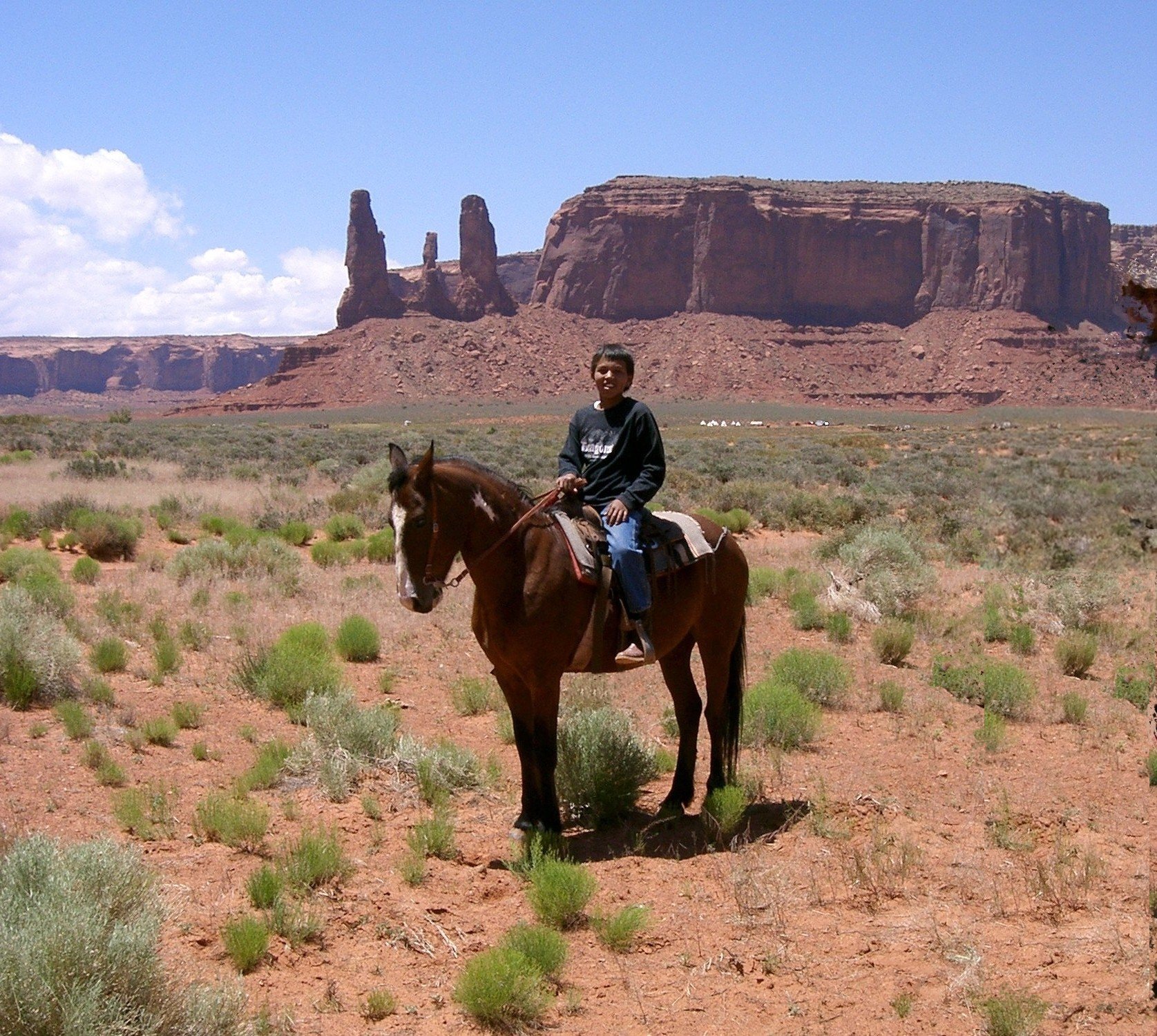 A Navajo boy in the desert in present-day Monument Valley in Arizona with the "Three Sisters" rock formation in the background in 2007 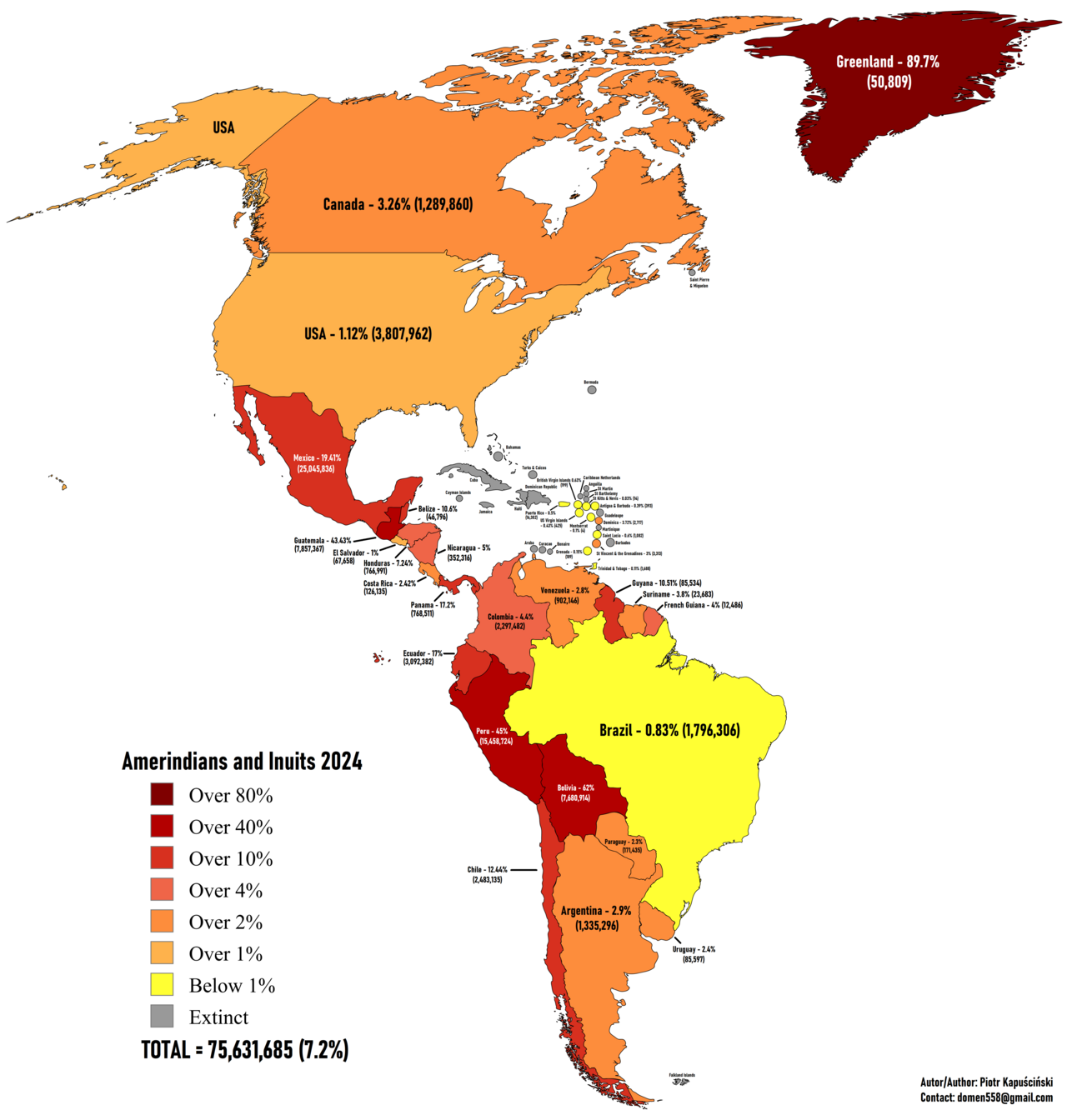 American Indian, Alaska Native, and Inuit populations of the Americas in 2024 Indigenous populations of the Americas in 2024 Application of the term "Indian" originated with Christopher Columbus, who, when searching for India, made landfall in the Americas but thought he had arrived in the East Indies.[47][48][49][50][51][52] The islands came to be known as the "West Indies" (or "Antilles"), a name that is still used to describe the islands. This led to the blanket term "Indies" and "Indians" (Spanish: indios; Portuguese: índios; French: indiens; Dutch: indianen) for the Indigenous inhabitants, which implied some kind of ethnic or cultural unity among the Indigenous peoples of the Americas. This unifying concept, codified in law, religion, and politics, was not originally accepted by the myriad groups of Indigenous peoples themselves but has since been embraced or tolerated by many over the last two centuries.[53] The term First Nations is used in Canada to identify that type of Indigenous people. The term "Indian" (or First Nations in Canada) generally does not include the culturally and linguistically distinct Indigenous peoples of the Arctic regions of the Americas, including the Aleuts, Inuit, or Yupik peoples. These peoples entered the continent as a second, more recent wave of migration several thousand years later and have much more recent genetic and cultural commonalities with the Indigenous peoples of Siberia. However, these groups are nonetheless considered among the "Indigenous peoples of the Americas".[54] The term Amerindian, a portmanteau of "American Indian", was coined in 1902 by the American Anthropological Association. It has been controversial ever since its creation. It was immediately rejected by some leading members of the Association, and, while adopted by many, it was never universally accepted.[55] While never popular in Indigenous communities themselves, it remains a preferred term among some anthropologists, notably in some parts of Canada and the English-speaking Caribbean.[56][57][58][59] "Indigenous peoples in Canada" is used as the collective name for First Nations, Inuit, and Métis.[60][61] The term Aboriginal peoples as a collective noun (also describing First Nations, Inuit, and Métis) is a specific term of art used in some legal documents, including the Constitution Act, 1982.[62] Over time, as societal perceptions and government–indigenous relationships have shifted, many historical terms have changed definitions or been replaced as they have fallen out of favor.[63] The use of the term "Indian" is frowned upon because it represents the imposition and restriction of Indigenous peoples and cultures by the Canadian Government.[63] The terms "Native" and "Eskimo" are generally regarded as disrespectful (in Canada), and so are rarely used unless specifically required.[64] While "Indigenous peoples" is the preferred term, many individuals or communities may choose to describe their identity using a different term.[63][64] The Métis people of Canada can be contrasted, for instance, to the Indigenous-European mixed-race mestizos (or caboclos in Brazil) of Hispanic America whose large populations constitute outright majorities, pluralities, or at the least large minorities in most Latin American countries. They identify largely as an ethnic group distinct from Europeans and Indigenous, but consider themselves a subset of the European-derived Hispanic or Brazilian peoplehood in culture and ethnicity (cf. ladinos). Among Spanish-speaking countries, indígenas or pueblos indígenas ("Indigenous peoples") is a common term, though nativos or pueblos nativos ('native peoples') may also be heard; moreover, aborigen ('aborigine') is used in Argentina and pueblos originarios ('original peoples') is common in Chile. In Brazil, indígenas and povos originários ("Indigenous peoples") are common formal-sounding designations, while índio ('Indian') is still the more often heard term (the noun for the South-Asian nationality being indiano), but since the early 2010s has been considered offensive and pejorative.[citation needed] Aborígene and nativo are rarely used in Brazil in Indigenous-specific contexts (e.g., aborígene is usually understood as the ethnonym for Indigenous Australians). The Spanish and Portuguese equivalents to Indian, nevertheless, could be used to mean any hunter-gatherer or full-blooded Indigenous person, particularly to continents other than Europe or Africa—for example, indios filipinos.[citation needed] Indigenous peoples of the United States are commonly known as Native Americans, Indians, as well as Alaska Natives.[clarification needed] The term "Indian" is still used in some communities and remains in use in the official names of many institutions and businesses in Indian Country.[65] |
用語 西インド諸島(またはアンティル諸島)とアメリカ大陸との関係 詳細情報:ネイティブアメリカンの名称論争  2007年、アリゾナ州モニュメントバレーの砂漠で「三姉妹」岩層を背景に立つナバホ族の少年  2024年におけるアメリカ大陸のアメリカ先住民、アラスカ先住民、イヌイットの人口 2024年におけるアメリカ大陸の先住民人口 「インディアン」という用語の適用は、クリストファー・コロンブスに端を発する。彼はインドを探して航海し、アメリカ大陸に上陸したが、東インドに到着したと思い込んだのである。[47][48][49][50][51][52] 島々は「西インド諸島」(または「アンティル諸島」)と呼ばれるようになり、この名称は現在も島々を指すのに使われている。これが「インド諸島」および 「インディアン」(スペイン語: indios、ポルトガル語: índios、フランス語: indiens、オランダ語: indianen)という包括的な呼称につながり、アメリカ大陸の先住民に何らかの民族的・文化的統一性があることを暗示した。この統一概念は法律、宗 教、政治に規定されたが、元来は数多くの先住民集団自身によって受け入れられていなかった。しかし過去2世紀の間に、多くの集団がこれを容認または受容す るに至った[53]。カナダではこの種の先住民を指す言葉として「ファースト・ネーションズ」が用いられる。 「インディアン」(カナダではファースト・ネーションズ)という用語は、一般的に、アリューシャン、イヌイット、ユピックなど、アメリカ大陸の北極圏に居 住する文化的・言語的に異なる先住民は含まない。これらの民族は、数千年後に第二の、より新しい移住の波として大陸に到達し、シベリアの先住民とは遺伝 的・文化的により近縁である。しかしながら、これらの集団は依然として「アメリカ大陸の先住民」の一員と見なされている。[54] 「アメリカ先住民」を意味する造語「アメリディアン」は、1902年にアメリカ人類学会によって考案された。この用語は誕生以来、議論を呼んできた。協会 内の主要メンバーの一部から即座に拒否され、多くの者によって採用されたものの、普遍的な受容は得られなかった。[55] 先住民族コミュニティ自体では決して普及しなかったが、一部の人類学者、特にカナダの一部地域や英語圏カリブ海地域では、依然として好まれる用語として 残っている。[56][57][58] [59] 「カナダの先住民」は、ファースト・ネーションズ、イヌイット、メティスの総称として用いられる。[60][61] 集合名詞としての「アボリジナル・ピープルズ」(これもファースト・ネーションズ、イヌイット、メティスを指す)は、1982年憲法法を含む一部の法的文 書で使用される特定の専門用語である。[62] 時間の経過とともに、社会の認識や政府と先住民の関係が変化するにつれ、多くの歴史的用語は定義が変更されたり、廃れて置き換えられたりした。[63] 「インディアン」という用語の使用は、カナダ政府による先住民とその文化への強制と制限を表すため、好ましくないとされる. [63] 「ネイティブ」や「エスキモー」という用語は(カナダにおいて)一般的に不敬と見なされ、特に必要でない限りほとんど使用されない。[64] 「先住民」が推奨用語ではあるが、多くの個人やコミュニティは自らのアイデンティティを異なる用語で表現することを選択する場合がある。[63][64] 例えばカナダのメティス民族は、ヒスパニック系アメリカにおける先住民とヨーロッパ人の混血のメスティーソ(ブラジルではカボクロ)と対比できる。後者は ラテンアメリカ諸国の大半で圧倒的多数派、あるいは少なくとも大規模な少数派を形成している。彼らは主にヨーロッパ系や先住民とは異なる民族集団として自 己認識しているが、文化や民族性においてはヨーロッパ系に由来するヒスパニック系またはブラジル人集団の一派と見なしている(ラディーノ参照)。 スペイン語圏では、indígenas(先住民)やpueblos indígenas(先住民族)が一般的な呼称だが、nativos(先住民)やpueblos nativos(先住民族)も用いられる。さらにアルゼンチンではaborigen(先住民)、チリではpueblos originarios(原住民族)が広く使われている。ブラジルでは、インディジェーナスとポボス・オリジナリオス(「先住民」)が正式な呼称として一 般的だが、インディオ(「インディアン」)という呼称が依然として頻繁に聞かれる(南アジアの国民を表す名詞はインディアーノ)。ただし2010年代初頭 以降、この呼称は侮蔑的で差別的と見なされるようになった。[出典必要] ブラジルでは先住民固有の文脈でアボリジネやナティボが使用されることは稀である(例:アボリジネは通常オーストラリア先住民の民族名として理解され る)。しかしながら、スペイン語やポルトガル語におけるインディアンに相当する語は、狩猟採集民や純血の先住民全般を指す場合があり、特にヨーロッパやア フリカ以外の大陸において使用される。例えばフィリピンの先住民を指す「インディオス・フィリピノス」などである。[出典が必要] アメリカ合衆国の先住民は、一般にネイティブ・アメリカン、インディアン、またアラスカ先住民として知られている。[説明が必要] 「インディアン」という用語は、一部のコミュニティでは依然として使用されており、インディアン・カントリー内の多くの機関や企業の正式名称にも残ってい る。[65] |
| Name controversy Main article: Native American name controversy 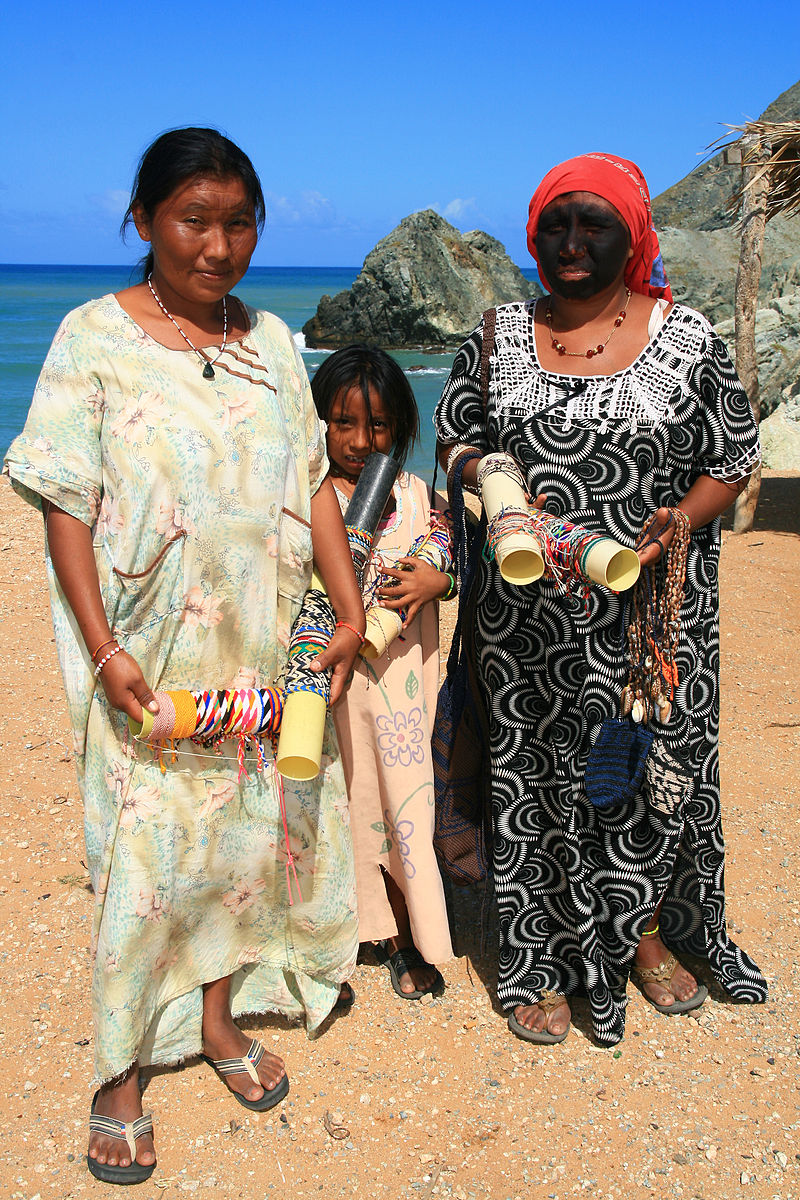 Wayuu women in the Guajira Peninsula, which encompasses parts of Colombia and Venezuela 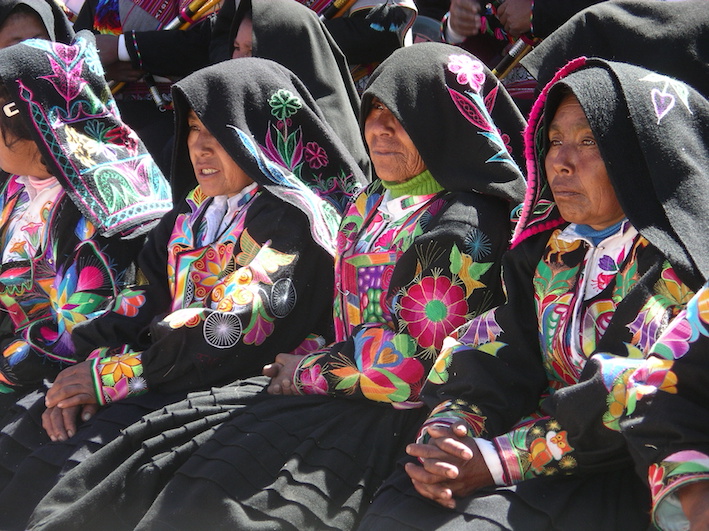 Quechua women in festive dress on Taquile Island on Lake Titicaca, west of Peru The various nations, tribes, and bands of Indigenous peoples of the Americas have differing preferences in terminology for themselves.[66][page needed] While there are regional and generational variations in which umbrella terms are preferred for Indigenous peoples as a whole, in general, most Indigenous peoples prefer to be identified by the name of their specific nation, tribe, or band.[66][67] Early settlers often adopted terms that some tribes used for each other, not realizing these were derogatory terms used by enemies. When discussing broader subsets of peoples, naming has often been based on shared language, region, or historical relationship.[68] Many English exonyms have been used to refer to the Indigenous peoples of the Americas. Some of these names were based on foreign language terms used by earlier explorers and colonists, while others resulted from the colonists' attempts to translate or transliterate endonyms from the native languages. Other terms arose during periods of conflict between the colonists and Indigenous peoples.[69] Since the late 20th century, Indigenous peoples in the Americas have been more vocal about how they want to be addressed, pushing to suppress the use of terms widely considered to be obsolete, inaccurate, or racist. During the latter half of the 20th century and the rise of the Indian rights movement, the United States federal government responded by proposing the use of the term "Native American", to recognize the primacy of Indigenous peoples' tenure in the nation.[70] As may be expected among people of over 400 different cultures in the US alone, not all of the people intended to be described by this term have agreed on its use or adopted it. No single group naming convention has been accepted by all Indigenous peoples in the Americas. Most prefer to be addressed as people of their tribe or nations when not speaking about Native Americans/American Indians as a whole.[71] Since the 1970s, the word "Indigenous", which is capitalized when referring to people, has gradually emerged as a favored umbrella term. The capitalization is to acknowledge that Indigenous peoples have cultures and societies that are equal to Europeans, Africans, and Asians.[67][72] This has recently been acknowledged in the AP Stylebook.[73] Some consider it improper to refer to Indigenous people as "Indigenous Americans" or to append any colonial nationality to the term because Indigenous cultures existed before European colonization. Indigenous groups have territorial claims that are different from modern national and international borders, and when labeled as part of a country, their traditional lands are not acknowledged. Some who have written guidelines consider it more appropriate to describe an Indigenous person as "living in" or "of" the Americas, rather than calling them "American"; or simply calling them "Indigenous" without any addition of a colonial state.[74][75] |
名称論争 詳細記事: ネイティブアメリカンの名称論争  コロンビアとベネズエラにまたがるグアヒラ半島のワユー族女性  ペルー西部のティティカカ湖、タキーレ島で祝祭衣装をまとったケチュア族女性 アメリカ大陸の先住民は、自民族を指す呼称について異なる好みを持つ。[66][出典ページ] 先住民全体を指す包括的呼称については地域や世代による差異があるものの、概して大多数の先住民は自らの特定の国民・部族・集団名で呼ばれることを好む。[66][67] 初期入植者たちは、敵対部族が互いを蔑称として用いていた呼称を、その意図に気づかずに採用することが多かった。より広範な集団を議論する際、名称は共通 言語・地域・歴史的関係に基づいて付けられることが多かった。[68] アメリカ大陸の先住民を指す英語の異称は数多く存在する。これらの名称の一部は、初期の探検家や入植者が用いた外国語に基づくものであり、他は入植者が先 住民の言語から固有名詞を翻訳・音訳しようとした結果である。その他の呼称は、入植者と先住民の対立期に生まれたものである。[69] 20世紀後半以降、アメリカ大陸の先住民は自らの呼称に関する意向をより強く表明し、時代遅れ・不正確・差別的と見なされる呼称の使用抑制を推進してき た。20世紀後半、インディアン権利運動の高まりを受けて、アメリカ合衆国連邦政府は「ネイティブ・アメリカン」という用語の使用を提案した。これは、先 住民がこの国民における最古の居住者であることを認めるためであった[70]。しかし、アメリカ国内だけでも400以上の異なる文化を持つ人々がいる中 で、この用語で指されるべきすべての人々がその使用に同意したり、採用したりしているわけではない。アメリカ大陸の先住民全体が合意した単一の呼称は存在 しない。大多数は、ネイティブ・アメリカン/アメリカン・インディアンという集団全体を指す場合を除き、自らの部族や国民の民として呼ばれることを好む。 [71] 1970年代以降、「先住民」という語(人を指す場合は大文字表記)が徐々に好まれる包括的呼称として定着してきた。大文字表記は、先住民の文化や社会が ヨーロッパ人、アフリカ人、アジア人と同等であることを認めるためである[67][72]。これは最近APスタイルブックでも認められた[73]。先住民 を「先住アメリカ人」と呼ぶことや、植民地時代の国籍を付加することは不適切だと考える者もいる。なぜなら先住文化はヨーロッパの植民地化以前に存在して いたからだ。先住民族集団の領土主張は、現代の国家境界や国際境界とは異なる。彼らが特定の国の一部として分類されると、伝統的な土地が認められない。ガ イドラインを策定した者の中には、先住民族を「アメリカ人」と呼ぶよりも「アメリカ大陸に居住する」あるいは「アメリカ大陸の」と表現する方が適切だと考 える者もいる。あるいは単に植民地国家の名称を付加せずに「先住民族」と呼ぶべきだとする意見もある。[74][75] |
| History Peopling of the Americas This section is an excerpt from Peopling of the Americas.[edit] 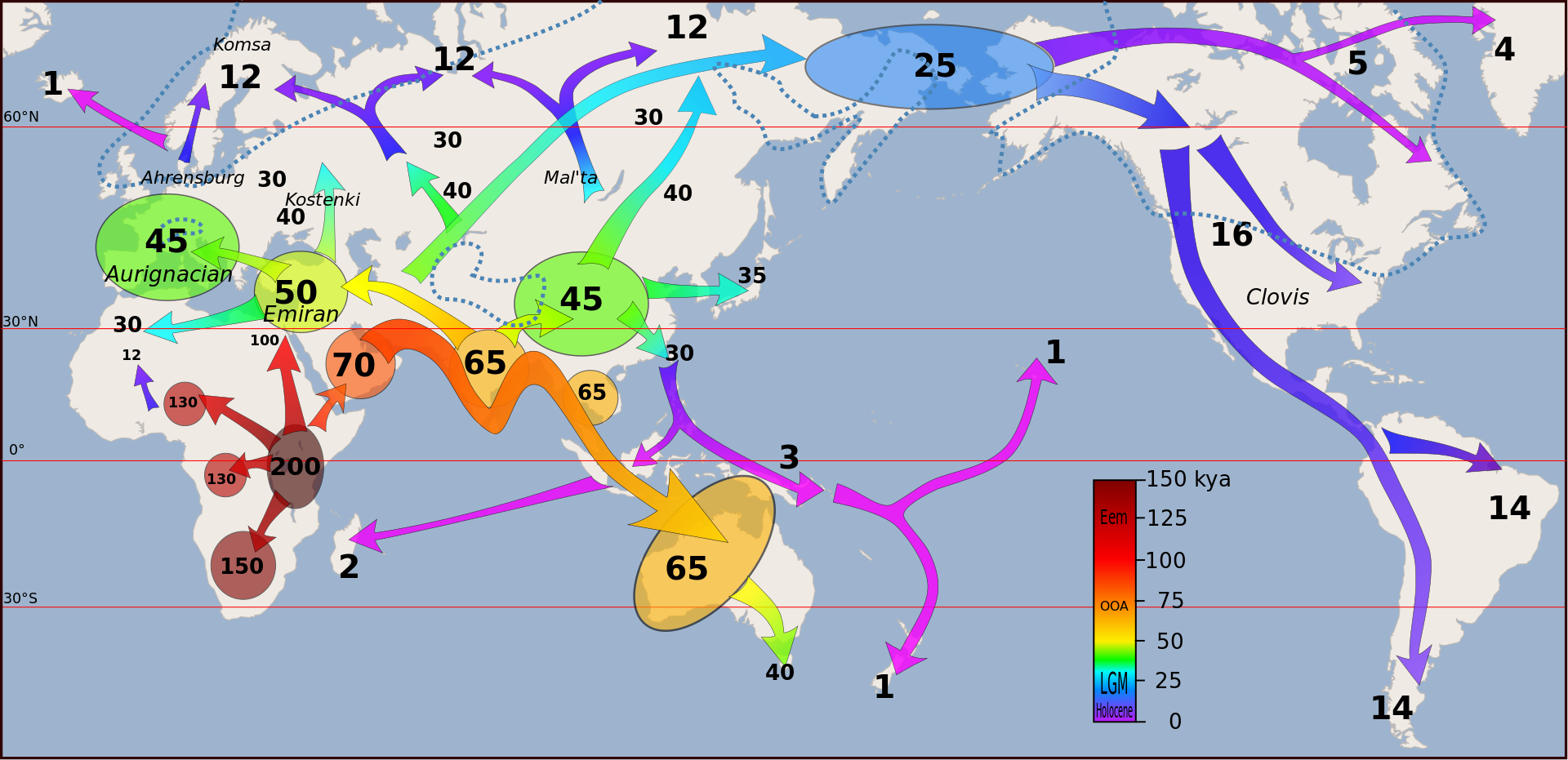 Map of early human migrations based on the Out of Africa theory; figures are in thousands of years ago (kya).[76] It is believed that the peopling of the Americas began when Paleolithic hunter-gatherers (Paleo-Indians) entered North America from the North Asian Mammoth steppe via the Beringia land bridge, which had formed between northeastern Siberia and western Alaska due to the lowering of sea level during the Last Glacial Maximum (26,000 to 19,000 years ago).[77] These populations expanded south of the Laurentide Ice Sheet, either by sea or land, and spread rapidly southward, occupying both North and South America no later than 14,000 years ago, and possibly before 20,000 years ago.[78][79][80][81][82] The earliest populations in the Americas, before roughly 10,000 years ago, are known as Paleo-Indians. Indigenous peoples of the Americas have been linked to Siberian populations by proposed linguistic factors, the distribution of blood types, and in genetic composition as reflected by molecular data, such as DNA.[83][84] While there is general agreement that the Americas were first settled from Asia, the pattern of migration and the place(s) of origin in Eurasia of the peoples who migrated to the Americas remain unclear.[79] The most generally accepted theory is that Ancient Beringians moved when sea levels were significantly lowered due to the Quaternary glaciation,[85][86] following herds of now-extinct Pleistocene megafauna along ice-free corridors that stretched between the Laurentide and Cordilleran ice sheets.[87] Another proposed route has them migrating down the Pacific coast to South America as far as Chile, either on foot or using boats.[88] Any archaeological evidence of coastal occupation during the last Ice Age would now have been covered by the sea level rise, up to a hundred metres since then.[89] The precise date for the peopling of the Americas is a long-standing open question. While advances in archaeology, Pleistocene geology, physical anthropology, and DNA analysis have progressively shed more light on the subject, significant questions remain unresolved.[90][91] The Clovis First theory refers to the hypothesis that the Clovis culture represents the earliest human presence in the Americas about 13,000 years ago.[92] Evidence of pre-Clovis cultures has accumulated and pushed back the possible date of the first peopling of the Americas.[93][94][95][96] Academics generally believe that humans reached North America south of the Laurentide Ice Sheet at some point between 15,000 and 20,000 years ago.[90][93][97][98][99][100] Some new controversial archaeological evidence suggests the possibility that human arrival in the Americas may have occurred prior to the Last Glacial Maximum more than 20,000 years ago.[93][101][102][103][104][105] The Swan Point Archaeological Site located in Alaska has yielded the oldest evidence of human habitation that is not disputed, with artifacts that have radiocarbon dates of 14,000 years, indicating the site was occupied around 12,000 BCE.[106][107][108] |
歴史 アメリカ大陸の定住 この節は『アメリカ大陸の定住』からの抜粋である。[編集]  アフリカ起源説に基づく初期人類移動の地図。数値は数千年前(kya)を示す。[76] アメリカ大陸への移住は、旧石器時代の狩猟採集民(パレオインディアン)が、最終氷期最大期(26,000~19,000年前)の海面低下によりシベリア 北東部とアラスカ西部に形成されたベーリンジア陸橋を経由し、北アジアのマンモス草原から北アメリカへ進入した時に始まったと考えられている。[77] これらの集団は、ローレンタイド氷床の南側へ、海路または陸路で拡大し、急速に南下して、遅くとも14,000年前、おそらくは20,000年前までに南 北アメリカ大陸を占拠した。[78][79][80][81] [82] 約1万年前以前のアメリカ大陸最古の集団は古インディアンとして知られる。アメリカ先住民は、言語学的要因、血液型の分布、DNAなどの分子データに反映 される遺伝的構成から、シベリアの集団との関連性が示唆されている。[83] [84] アメリカ大陸への最初の移住がアジアからであった点については概ね合意があるものの、移住のパターンやユーラシア大陸における移住者の起源地は依然として 不明である。[79] 最も広く受け入れられている説は、第四紀氷河期による海面の大幅な低下[85][86]を機に、古代ベーリング人がローレンタイド氷床とコルディリェラ氷 床の間に広がる無氷回廊を、現在は絶滅した更新世の群畜を追って移動したというものだ[87]。別の説では、太平洋沿岸を南下しチリまで到達したとする。 徒歩か船を使った移動である。[88] 最終氷期における沿岸居住の考古学的証拠は、その後最大100メートル上昇した海面によって現在では水没している。[89] アメリカ大陸への人民到達時期の正確な年代は、長年の未解決問題である。考古学、更新世地質学、自然人類学、DNA分析の進歩により次第に解明が進む一 方、重要な疑問点は未解決のままである。[90][91] クロヴィス・ファースト説とは、クロヴィス文化が約13,000年前のアメリカ大陸最古の人類存在を示すとする仮説を指す。[92] クロヴィス以前の文化の証拠が蓄積され、アメリカ大陸への最初の人類到達時期の可能性はさらに遡った。[93][94][95][96] 学者は一般的に、人類がローレンタイド氷床の南側にある北アメリカ大陸に到達したのは、1万5000年から2万年前の間のどこかの時点だと考えている。 [90][93] [97][98][99][100] 一部新たな論争を呼ぶ考古学的証拠は、人類のアメリカ大陸到達が最終氷期最盛期(2万年以上前)以前に起こった可能性を示唆している。[93][101] [102][103][104] [105] アラスカにあるスワンポイント遺跡からは、放射性炭素年代測定で14,000年前と判定された遺物が発見されており、紀元前12,000年頃に人が居住し ていたことを示す、議論の余地のない最古の人類居住の証拠となっている。[106][107][108] |
| Pre-Columbian era Main articles: Pre-Columbian era and Archaeology of the Americas 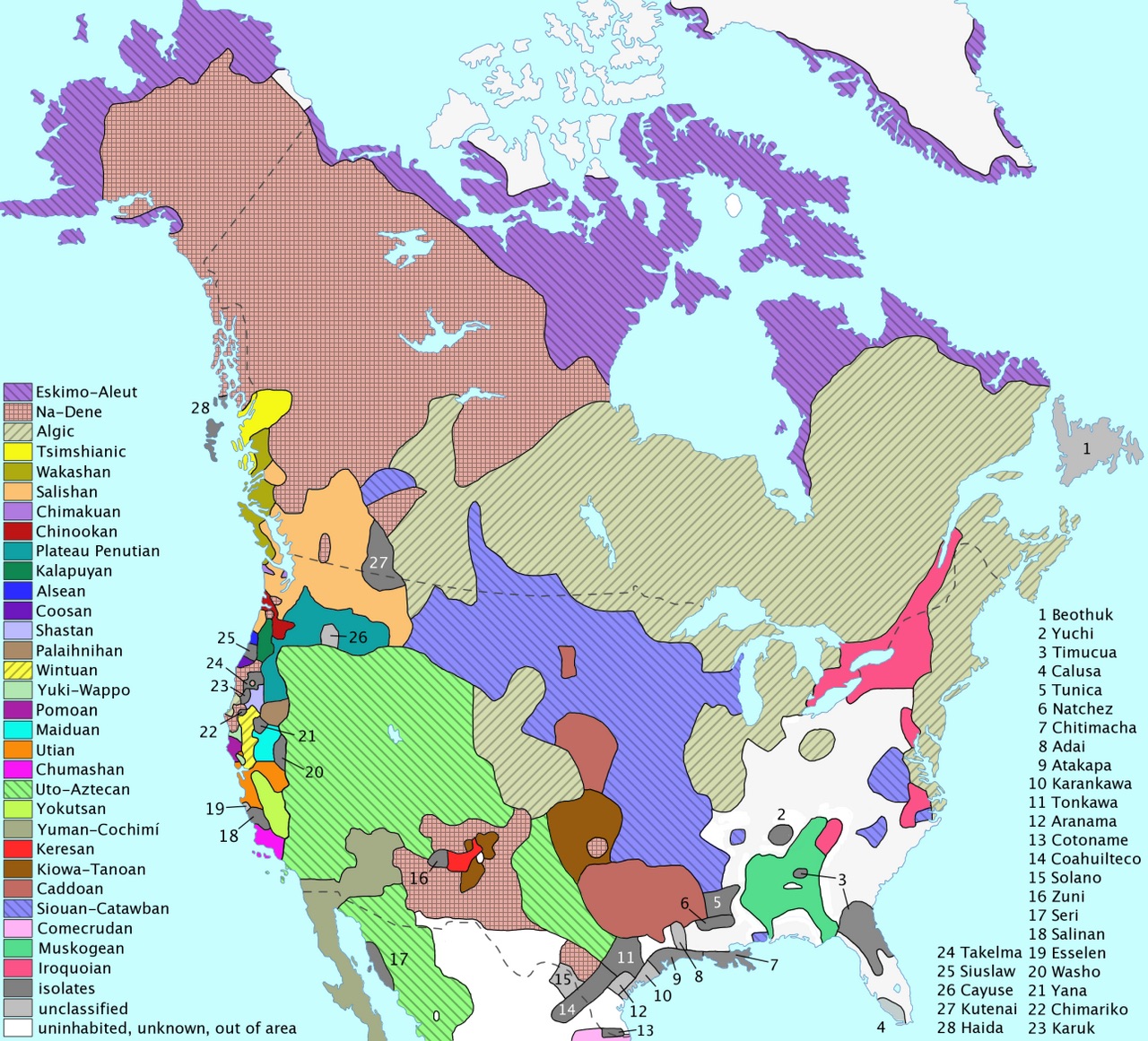 Language families of Indigenous peoples in North America shown across present-day Canada, Greenland, the United States, and northern Mexico 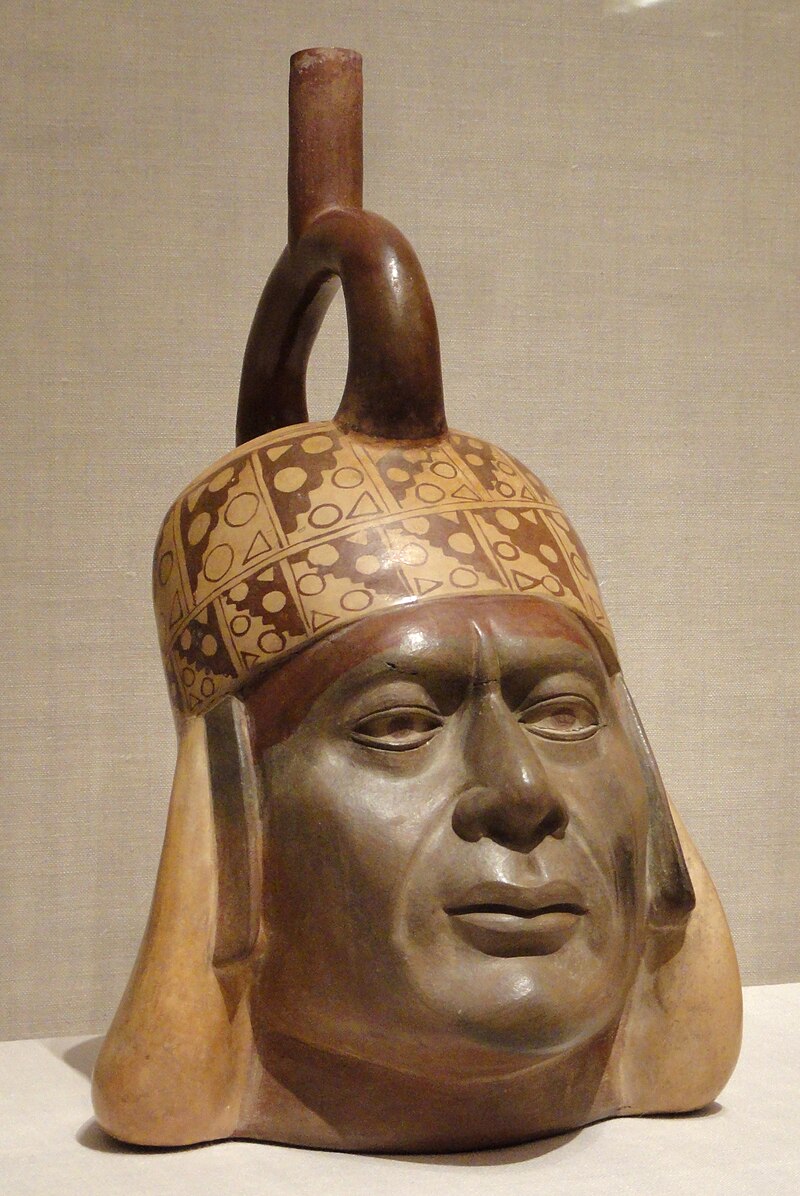 Moche portrait vessel from Peru, 100 BCE–500 CE 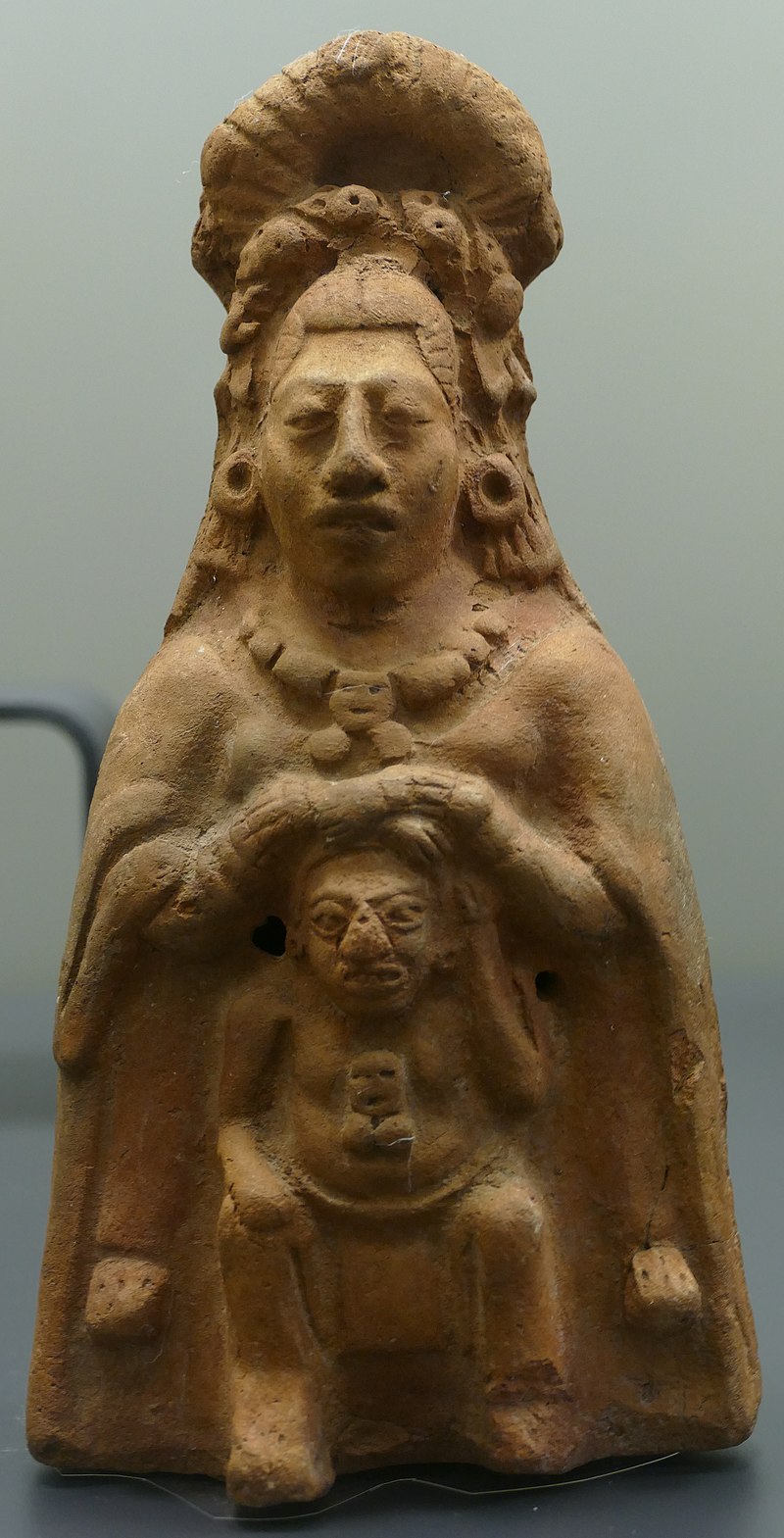 Ceramic portrait of a Maya noblewoman, Jaina Island, Mexico, 600–800 CE While technically referring to the era before Christopher Columbus' voyages of 1492 to 1504, in practice the term usually includes the history of Indigenous cultures until Europeans either conquered or significantly influenced them.[109] "Pre-Columbian" is used especially often in the context of discussing the pre-contact Mesoamerican Indigenous societies: Olmec; Toltec; Teotihuacano' Zapotec; Mixtec; Aztec and Maya civilizations; and the complex cultures of the Andes: Inca Empire, Moche culture, Muisca Confederation, and Cañari. The pre-Columbian era refers to all period subdivisions in the history and prehistory of the Americas before the appearance of significant European and African influences on the American continents, spanning the time of the original arrival in the Upper Paleolithic to European colonization during the early modern period.[110] The Norte Chico civilization (in present-day Peru) is one of the defining six original civilizations of the world, arising independently around the same time as that of Egypt.[111][112] Many later pre-Columbian civilizations achieved great complexity, with hallmarks that included permanent or urban settlements, agriculture, engineering, astronomy, trade, civic and monumental architecture, and complex societal hierarchies. Some of these civilizations had long faded by the time of the first significant European and African arrivals (ca. late 15th–early 16th centuries), and are known only through oral history and through archaeological investigations. Others were contemporary with the contact and colonization period and were documented in historical accounts of the time. A few, such as the Mayan, Olmec, Mixtec, Aztec, and Nahua peoples, had their written languages and records. However, the European colonists of the time worked to eliminate non-Christian beliefs and burned many pre-Columbian written records. Only a few documents remained hidden and survived, leaving contemporary historians with glimpses of ancient culture and knowledge. According to both Indigenous and European accounts and documents, American civilizations before and at the time of European encounter had achieved great complexity and many accomplishments.[113] For instance, the Aztecs built one of the largest cities in the world, Tenochtitlan (the historical site of what would become Mexico City), with an estimated population of 200,000 for the city proper and a population of close to five million for the extended empire.[114] By comparison, the largest European cities in the 16th century were Constantinople and Paris with 300,000 and 200,000 inhabitants respectively.[115] The population in London, Madrid, and Rome hardly exceeded 50,000 people. In 1523, right around the time of the Spanish conquest, the entire population in the country of England was just under three million people.[116] This fact speaks to the level of sophistication, agriculture, governmental procedure, and rule of law that existed in Tenochtitlan, needed to govern over such a large citizenry. Indigenous civilizations also displayed impressive accomplishments in astronomy and mathematics, including the most accurate calendar in the world.[citation needed] The domestication of maize or corn required thousands of years of selective breeding, and continued cultivation of multiple varieties was done with planning and selection, generally by women. Inuit, Yupik, Aleut, and Indigenous creation myths tell of a variety of origins of their respective peoples. Some were "always there" or were created by gods or animals, some migrated from a specified compass point, and others came from "across the ocean".[117] |
コロンブス以前の時代 主な記事:コロンブス以前の時代とアメリカ大陸の考古学  北米先住民の言語族。現在のカナダ、グリーンランド、アメリカ合衆国、メキシコ北部における分布を示す  ペルーのモチェ文化の肖像壺。紀元前100年~紀元500年  メキシコ・ハイナ島出土のマヤ貴族女性の陶器肖像。紀元600年~800年 技術的には1492年から1504年にかけてのクリストファー・コロンブスの航海以前の時代を指すが、実際にはこの用語は通常、ヨーロッパ人が先住民文化 を征服するか、あるいは重大な影響を与えるまでの歴史を含む。[109] 「コロンブス以前」という表現は、特に接触前のメソアメリカ先住民社会について論じる文脈で頻繁に用いられる:オルメカ、トルテカ、テオティワカノ、サポ テカ、ミシュテカ、 アステカ、マヤ文明。そしてアンデス地域の複雑な文化:インカ帝国、モチェ文化、ムイスカ連合、カニャリ。 コロンブス以前の時代とは、アメリカ大陸にヨーロッパやアフリカからの重大な影響が現れる前の、アメリカ大陸の歴史および先史時代の全期間を指す。旧石器 時代後期における最初の到達から、近世におけるヨーロッパの植民地化までの期間に及ぶ。[110] ノルテ・チコ文明(現在のペルー)は、エジプト文明とほぼ同時期に独立して興った、世界を定義する六大原始文明の一つである。[111][112] 後世のコロンブス以前の文明の多くは高度な複雑性を達成し、恒久的あるいは都市的な定住地、農業、工学、天文学、交易、公共建築や記念建造物、複雑な社会 階層といった特徴を備えていた。これらの文明の一部は、ヨーロッパ人およびアフリカ人による最初の重要な到達時(15世紀末~16世紀初頭頃)にはすでに 長く衰退しており、口承歴史や考古学的調査を通じてのみ知られている。他の文明は接触・植民地化期と同時期に存在し、当時の歴史記録に文書化されている。 マヤ、オルメカ、ミシュテカ、アステカ、ナワなどの少数の民族は、独自の文字言語と記録を残していた。しかし当時のヨーロッパ人入植者は非キリスト教的信 仰を消去法による排除に取り組み、多くの先コロンブス期の文書記録を焼却した。ごく一部の文書だけが隠され生き延び、現代の歴史家に古代文化と知識の断片 を残している。 先住民とヨーロッパ双方の記録によれば、ヨーロッパ人との接触前および接触期のアメリカ文明は高度な複雑性と多くの成果を達成していた[113]。例えば アステカは世界最大級の都市テノチティトラン(後のメキシコシティの史跡)を建設し、市街地人口は20万人、帝国全体では500万人近くに達した。 [114] 比較すると、16世紀のヨーロッパで最大規模の都市はコンスタンティノープルとパリで、それぞれ30万人と20万人の住民を擁していた。[115] ロンドン、マドリード、ローマの住民は5万人をわずかに超える程度だった。1523年、スペインによる征服が行われたまさにその頃、イングランド全土の人 民は300万人弱であった。[116] この事実は、テノチティトランに存在した高度な文明、農業技術、統治手続き、法の支配の水準を物語っている。これらは、これほど大規模な市民社会を統治す るために必要だったのだ。先住民文明は天文学や数学の分野でも驚異的な成果を示し、世界最高精度のカレンダーを確立した[出典必要]。トウモロコシの栽培 化には数千年にわたる選択的育種が必要であり、複数の品種の継続的栽培は計画と選別によって行われ、主に女性が担っていた。 イヌイット、ユピック、アレウト、および先住民の創造神話では、それぞれの民族の起源について様々な説が語られている。ある民族は「常にそこに存在してい た」か、神々や動物によって創造された。ある民族は特定の方角から移住してきた。また別の民族は「海の向こうから」来たという。[117] |
| European colonization Main article: European colonization of the Americas See also: Population history of Indigenous peoples of the Americas, Columbian exchange, and Society of the Spanish-Americans in the Spanish Colonial Americas 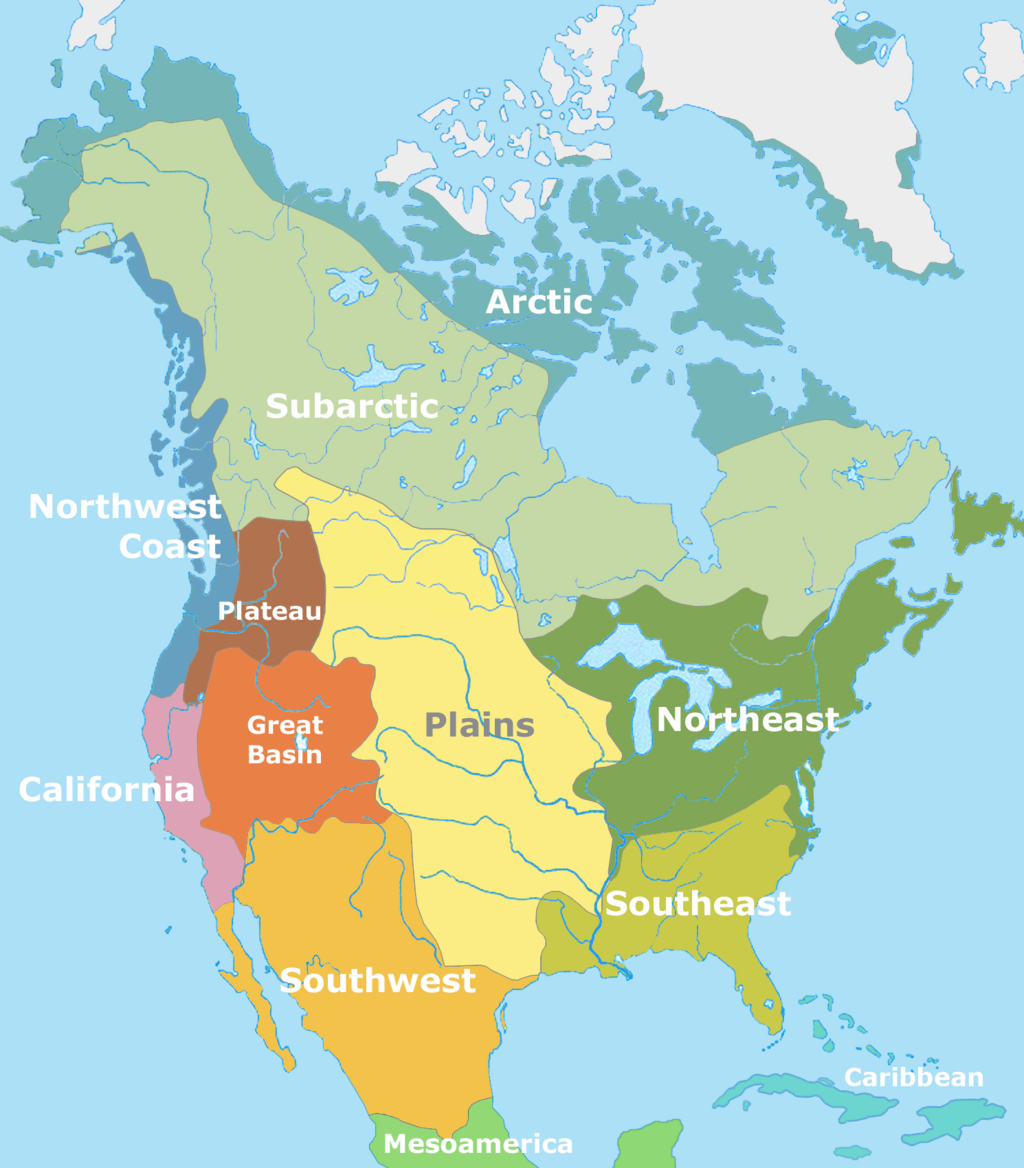 Areas of Indigenous peoples in North America at time of European colonization 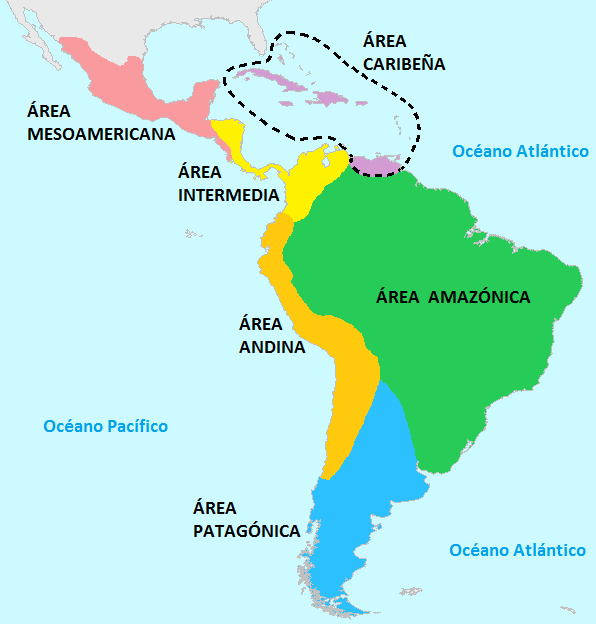 Areas of Indigenous peoples in South and Central America at the time of European colonization (in Spanish) 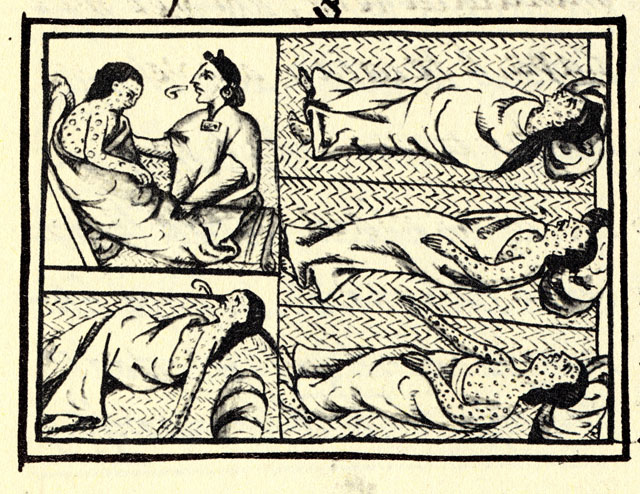 An illustration in Florentine Codex, compiled between 1540 and 1585 CE, depicting the Nahua peoples suffering from smallpox during the conquest-era in central Mexico 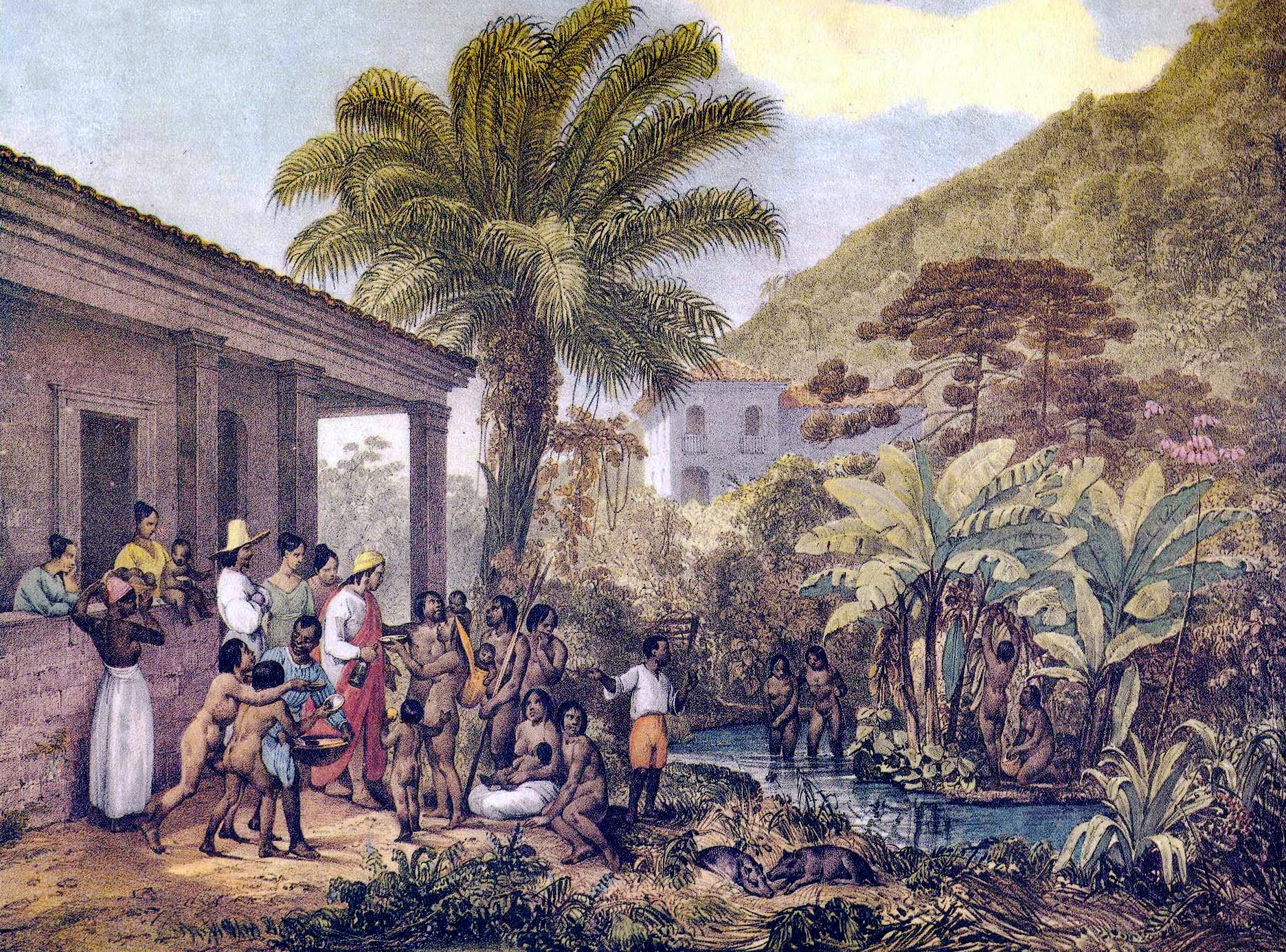 Indigenous people at a farm plantation in Minas Gerais in present-day Brazil, c. 1824 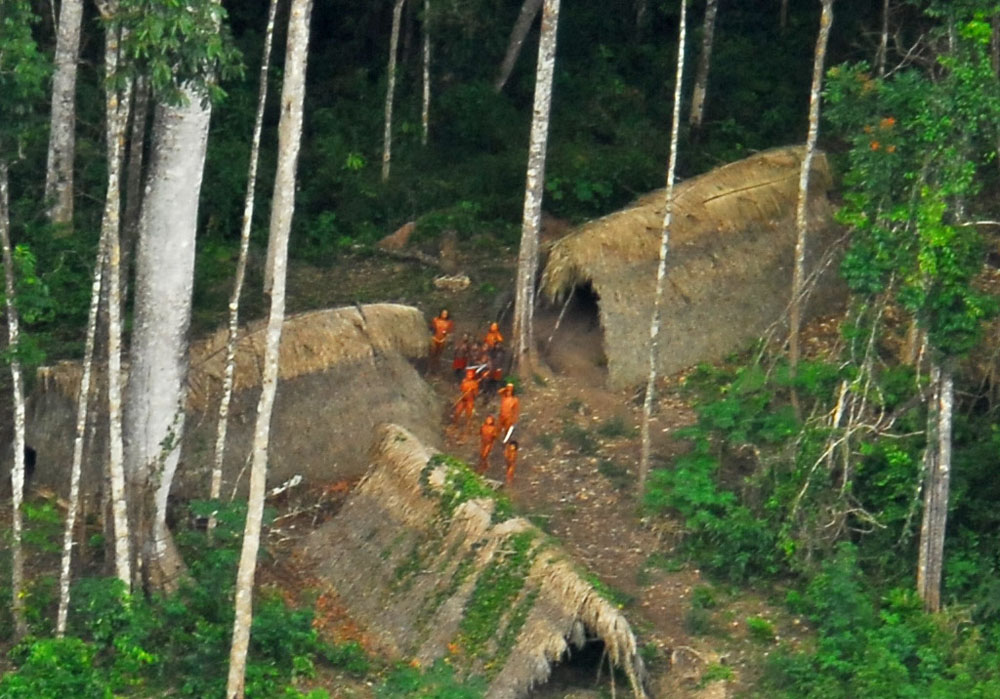 Members of an uncontacted tribe encountered in Acre in Brazil in 2009 The European colonization of the Americas fundamentally changed the lives and cultures of the resident Indigenous peoples. Although the exact pre-colonization population count of the Americas is unknown, scholars estimate that Indigenous populations diminished by between 80% and 90% during the first centuries of European colonization. Most scholars estimate a pre-colonization population of around 50 million, with other scholars arguing for an estimate of 100 million. Estimates reach as high as 145 million.[118][119][120] William Denevan estimates of the pre-contact population range from 8 million to 112 million, falling to under 6 million by 1650.[121] Epidemics ravaged the Americas with diseases, such as smallpox, measles, and cholera, which the early colonists brought from Europe. The spread of infectious diseases was slow initially, as European populations were relatively small. This changed when the Europeans began the trafficking of massive numbers of enslaved Western and Central African people to the Americas, drastically increasing the population. These enslaved Africans carried many of the same diseases as Europeans, such as smallpox, along with many tropical diseases unknown to both the indigenous populations and Europeans. In 1520, an African who had been infected with smallpox had arrived in Yucatán. By 1558, the disease had spread throughout South America and had arrived at the Plata basin.[122] Colonist violence towards Indigenous peoples accelerated the loss of lives. European colonists perpetrated massacres on the Indigenous peoples and enslaved them.[123][124][125] According to the U.S. Bureau of the Census (1894), the North American Indian Wars of the 19th century had a known death toll of about 19,000 Europeans and 30,000 Native Americans, and an estimated total death toll of 45,000 Native Americans.[126] The first Indigenous group encountered by Columbus, the 250,000 Taínos of Hispaniola, represented the dominant culture in the Greater Antilles and the Bahamas. Within thirty years about 70% of the Taínos had died.[127] They had no immunity to European diseases, so outbreaks of measles and smallpox ravaged their population.[128] One such outbreak occurred in a camp of enslaved Africans, where smallpox spread to the nearby Taíno population and reduced their numbers by 50%.[122] Increasing punishment of the Taínos for revolting against forced labor, despite measures put in place by the encomienda, which included religious education and protection from warring tribes,[129] eventually led to the last great Taíno rebellion (1511–1529). Following years of mistreatment, the Taínos began to adopt suicidal behaviors, with women aborting or killing their infants and men jumping from cliffs or ingesting untreated cassava, a violent poison.[127] Eventually, a Taíno Cacique named Enriquillo managed to hold out in the Baoruco Mountain Range for thirteen years, causing serious damage to the Spanish, Carib-held plantations and their Indian auxiliaries.[130][failed verification] Hearing of the seriousness of the revolt, Emperor Charles V (also King of Spain) sent Captain Francisco Barrionuevo to negotiate a peace treaty with the ever-increasing number of rebels. Two months later, after consultation with the Audencia of Santo Domingo, Enriquillo was offered any part of the island to live in peace. The Laws of Burgos, 1512–1513, were the first codified set of laws governing the behavior of Spanish settlers in America, particularly concerning Indigenous peoples. The laws forbade the maltreatment of them and endorsed their conversion to Catholicism.[131] The Spanish crown found it difficult to enforce these laws in distant colonies. Epidemic disease was the overwhelming cause of the population decline of the Indigenous peoples.[132][133] After initial contact with Europeans and Africans, Old World diseases caused the deaths of 90 to 95% of the native population of the New World in the following 150 years.[134] Smallpox killed from one-third to half of the native population of Hispaniola in 1518.[135][136] By killing the Incan ruler Huayna Capac, smallpox caused the Inca Civil War of 1529–1532. Smallpox was only the first epidemic. Typhus (probably) in 1546, influenza and smallpox together in 1558, smallpox again in 1589, diphtheria in 1614, and measles in 1618—all ravaged the remains of Inca culture. Smallpox killed millions of native inhabitants of Mexico.[137][138] Unintentionally introduced at Veracruz with the arrival of Pánfilo de Narváez on 23 April 1520, smallpox ravaged Mexico in the 1520s,[139] possibly killing over 150,000 in Tenochtitlán (the heartland of the Aztec Empire) alone, and aiding in the victory of Hernán Cortés over the Aztec Empire at Tenochtitlan (present-day Mexico City) in 1521.[citation needed][122] There are many factors as to why Indigenous peoples suffered such immense losses from Afro-Eurasian diseases. Many Old World diseases, like cow pox, are acquired from domesticated animals that are not indigenous to the Americas. European populations had adapted to these diseases, and built up resistance, over many generations. Many of the Old World diseases that were brought over to the Americas were diseases, like yellow fever, that were relatively manageable if infected as a child, but were deadly if infected as an adult. Children could often survive the disease, resulting in immunity to the disease for the rest of their lives. But contact with the disease by adults without this childhood or inherited immunity often proved fatal.[122][140] Colonization of the Caribbean led to the destruction of the Arawaks of the Lesser Antilles. Their culture was destroyed by 1650. Only 500 had survived by the year 1550, though the bloodlines continued through to the modern populace. In Amazonia, Indigenous societies weathered centuries of colonization and genocide.[141] Contact with European diseases such as smallpox and measles killed between 50 and 67 percent of the Indigenous population of North America in the first hundred years after the arrival of Europeans.[142] Some 90 percent of the native population near Massachusetts Bay Colony died of smallpox in an epidemic in 1617–1619.[143] In 1633, in Fort Orange (New Netherland), the Native Americans there were exposed to smallpox because of contact with Europeans. As it had done elsewhere, the virus wiped out entire population groups of Native Americans.[144] It reached Lake Ontario in 1636, and the lands of the Iroquois by 1679.[145][146] During the 1770s smallpox killed at least 30% of the West Coast Native Americans.[147] The 1775–82 North American smallpox epidemic and the 1837 Great Plains smallpox epidemic brought devastation and drastic population depletion among the Plains Indians.[148][149] In 1832 the federal government of the United States established a smallpox vaccination program for Native Americans (The Indian Vaccination Act of 1832).[150] The Indigenous peoples in Brazil declined from a pre-Columbian high of an estimated three million[151] to some 300,000 in 1997.[dubious – discuss][failed verification][152] The Spanish Empire and other Europeans re-introduced horses to the Americas. Some of these animals escaped and began to breed and increase their numbers in the wild.[153] The reintroduction of the horse, extinct in the Americas for over 7500 years, had a profound impact on Indigenous cultures in several regions, such as those of the Great Plains, the Northwest Plateau, the Great Basin, Aridoamerica, the Gran Chaco and the Southern Cone. By domesticating horses, some tribes had great success: horses enabled them to expand their territories, exchange more goods with neighboring tribes, and more easily capture game, such as bison. According to Erin McKenna and Scott L. Pratt, the Indigenous population of the Americas was 145 million in the late 15th and by the late 17th century, had been reduced to 15 million due to epidemics, wars, massacres, mass rapes, starvation, and enslavement.[120] |
ヨーロッパによる植民地化 主な記事: ヨーロッパによるアメリカ大陸の植民地化 関連項目: アメリカ先住民の人口史、コロンブス交換、スペイン植民地時代のアメリカにおけるスペイン系アメリカ人社会  ヨーロッパによる植民地化当時の北米先住民の居住地域  ヨーロッパによる植民地化当時の南米・中央アメリカ先住民の居住地域(スペイン語)  1540年から1585年の間に編纂された『フィレンツェ写本』の挿絵。メキシコ中央部における征服時代に天然痘により苦悩するナワ族の人々を描いている  現在のブラジル、ミナスジェライス州の農場プランテーションにおける先住民。約1824年  2009年にブラジル・アクレ州で遭遇した未接触部族のメンバー ヨーロッパによるアメリカ大陸の植民地化は、先住民の生活と文化を根本的に変えた。植民地化前の人口は正確には不明だが、学者らはヨーロッパ植民地化の最 初の数世紀で先住民の人口が80%から90%減少したと推定している。大半の学者は植民地化前の人口を約5000万人と推定しているが、1億人とする見解 もある。推定値は1億4500万人に達することもある[118][119][120]。ウィリアム・デネヴァンの推定では、接触前の人口は800万人から 1億1200万人に及び、1650年までに600万人を下回ったとされる。[121] 天然痘、麻疹、コレラといった疫病がアメリカ大陸を襲った。これらは初期の入植者がヨーロッパから持ち込んだものだ。伝染病の拡散は当初、ヨーロッパの人 口が比較的少なかったため緩やかだった。しかしヨーロッパ人が西・中央アフリカから大量の奴隷をアメリカ大陸へ移送し始めると状況は一変し、人口が急増し た。これらの奴隷となったアフリカ人は、天然痘などヨーロッパ人と同様の疾病に加え、先住民にもヨーロッパ人にも未知の熱帯病を多数持ち込んでいた。 1520年、天然痘に感染したアフリカ人がユカタン半島に到着した。1558年までに、この病気は南アメリカ全域に広がり、プラタ川流域にも到達した [122]。先住民に対する入植者の暴力は、死者の増加を加速させた。ヨーロッパ人入植者は先住民に対して虐殺を行い、奴隷化した。[123][124] [125] 米国国勢調査局(1894年)によれば、19世紀の北米インディアン戦争における確認死者はヨーロッパ人約19,000人、先住民約30,000人で、先 住民の推定総死者数は45,000人に上る。[126] コロンブスが最初に遭遇した先住民集団、イスパニョーラ島の25万人のタイノ族は、大アンティル諸島とバハマ諸島における支配的な文化を代表していた。 30年以内にタイノ族の約70%が死亡した[127]。彼らはヨーロッパの伝染病に対する免疫を持たなかったため、麻疹や天然痘の流行が人口を壊滅させた [128]。そうした流行の一つは奴隷化されたアフリカ人のキャンプで発生し、天然痘が近隣のタイノ族に広がり、その人口を50%減少させた。[122] 強制労働への反乱に対するタイノ族への処罰強化は、宗教教育や他部族からの保護を含むエンコミエンダ制度の導入にもかかわらず[129]、最終的に最後の 大きなタイノ族反乱(1511年~1529年)を引き起こした。 長年の虐待を受けたタイノ族は自殺的行動を取り始めた。女性は流産や乳児殺害を行い、男性は崖から飛び降りたり、猛毒である未処理のキャッサバを摂取した [127]。最終的にエンリキーヨという名のタイノ族首長がバオルコ山脈で13年間抵抗を続け、スペイン人、カリブ族が支配するプランテーション、および 彼らのインディアン補助部隊に深刻な損害を与えた。[130][検証失敗] この反乱の深刻さを知った皇帝カルロス5世(スペイン国王も兼任)は、増え続ける反乱軍との和平交渉のためフランシスコ・バリオンエボ大尉を派遣した。2 か月後、サントドミンゴ高等裁判所との協議を経て、エンリキージョには島の任意の地域に平和に居住する権利が提示された。 1512年から1513年にかけて制定されたブルゴス法は、アメリカ大陸におけるスペイン人入植者の行動、特に先住民に関する初の成文化された法体系で あった。この法律は先住民への虐待を禁じ、カトリックへの改宗を推奨していた[131]。しかしスペイン王室は、遠隔地の植民地でこれらの法律を施行する ことが困難であった。 伝染病が先住民人口減少の圧倒的主因であった[132][133]。ヨーロッパ人・アフリカ人との接触後、旧世界の疾病により新世界先住民人口の 90~95%が、その後150年間で死亡した。[134] 1518年には天然痘がイスパニョーラ島の先住民人口の3分の1から半分を死に至らしめた。[135][136] インカ帝国の統治者ワイナ・カパックを死に至らしめた天然痘は、1529年から1532年にかけてのインカ内戦を引き起こした。天然痘は最初の疫病に過ぎ なかった。1546年には(おそらく)チフス、1558年にはインフルエンザと天然痘の同時流行、1589年には再び天然痘、1614年にはジフテリア、 1618年には麻疹が、インカ文化の残存部分を次々と荒廃させた。 天然痘はメキシコの先住民数百万を死に至らしめた[137][138]。1520年4月23日、パンフィロ・デ・ナルバエスの到着と共にベラクルスへ意図 せず持ち込まれた天然痘は、 天然痘は1520年代にメキシコを荒廃させ[139]、テノチティトラン(アステカ帝国の中心地)だけで15万人以上を死に至らしめ、1521年にエルナ ン・コルテスがテノチティトラン(現在のメキシコシティ)でアステカ帝国に勝利する一因となった[出典必要]。[122] 先住民がアフリカ・ユーラシア由来の疾病によってこれほど甚大な苦悩を蒙った背景には、多くの要因がある。牛痘のような旧世界の疾病の多くは、アメリカ大 陸に自生しない家畜から感染する。ヨーロッパの人々は、何世代にもわたってこれらの病気に適応し、抵抗力を培ってきた。アメリカ大陸に持ち込まれた旧世界 の病気の多くは、黄熱病のように、子供時代に感染すれば比較的対処可能だが、成人後に感染すると致命的となるものだった。子供はしばしばこの病気を生き延 び、生涯にわたる免疫を獲得した。しかし、この幼少期の免疫や獲得免疫を持たない成人が病気と接触すると、しばしば致命的となった。[122] [140] カリブ海の植民地化は小アンティル諸島のアラワク族の壊滅をもたらした。彼らの文化は1650年までに消滅した。1550年までに生き残ったのはわずか 500人だったが、その血筋は現代の人々に受け継がれている。アマゾニアでは、先住民社会が何世紀にもわたる植民地化とジェノサイドを耐え抜いた。 [141] ヨーロッパ人による天然痘や麻疹などの伝染病との接触は、ヨーロッパ人到着後100年間で北米先住民人口の50~67%を死に至らしめた。[142] マサチューセッツ湾植民地周辺の先住民人口の約90%は、1617年から1619年にかけての天然痘の流行で死亡した。[143] 1633年、フォート・オレンジ(ニューネーデルラント)では、先住民がヨーロッパ人との接触により天然痘に感染した。他の地域と同様に、このウイルスは 先住民集団全体を壊滅させた。[144] 1636年にはオンタリオ湖に、1679年までにイロコイ族の居住地に到達した。[145][146] 1770年代には、西海岸の先住民の少なくとも30%が天然痘で死亡した。[147] 1775年から1782年にかけての北米天然痘流行と、1837年のグレートプレーンズ天然痘流行は、平原部族のインディアンに壊滅的な打撃を与え、人口 を激減させた。[148][149] 1832年、アメリカ合衆国連邦政府は先住民向けの天然痘予防接種プログラムを設立した(1832年先住民予防接種法)。[150] ブラジルの先住民の人口は、コロンブス以前の推定300万人[151]から、1997年には約30万人に減少した。[疑わしい – 議論が必要][検証不能][152] スペイン帝国や他のヨーロッパ諸国が馬をアメリカ大陸に再導入した。これらの動物の一部は逃げ出し、野生で繁殖し数を増やした[153]。7500年以上 もアメリカ大陸で絶滅していた馬の再導入は、グレートプレーンズ、北西高原、グレートベイスン、乾燥アメリカ、グランチャコ、南錐体など、いくつかの地域 の先住民文化に深い影響を与えた。馬を家畜化した部族の中には大きな成功を収めた者もいた。馬は彼らの領土拡大を可能にし、近隣部族との物資交換を活発化 させ、バイソンなどの獲物をより容易に捕獲することを可能にした。 エリン・マッケナとスコット・L・プラットによれば、アメリカ大陸の先住民人口は15世紀末に1億4500万人だったが、17世紀末までに疫病、戦争、虐殺、集団強姦、飢餓、奴隷化によって1500万人にまで減少した。 |
| Indigenous historical trauma See also: Historical trauma § Indigenous historical trauma  Map Wikimedia | © OpenStreetMap Map of all Indigenous resident schools in Canada, including gravesites. This map can be expanded and interacted with. Confirmed discoveries of gravesites (24) Investigations underway as of 30 July 2021 (17) Investigations that concluded with no discoveries (2) Resident schools where no investigations have taken place (100) Data Indigenous historical trauma (IHT) is the trauma that can accumulate across generations and develop as a result of the historical ramifications of colonization and is linked to mental and physical health hardships and population decline.[154] IHT affects many different people in a multitude of ways because the Indigenous community and their history are diverse. Many studies (such as Whitbeck et al., 2014;[155] Brockie, 2012; Anastasio et al., 2016;[156] Clark & Winterowd, 2012;[157] Tucker et al., 2016)[158] have evaluated the impact of IHT on health outcomes of Indigenous communities from the United States and Canada. IHT is a difficult term to standardize and measure because of the vast and variable diversity of Indigenous people and their communities. Therefore, it is an arduous task to assign an operational definition and systematically collect data when studying IHT. Many of the studies that incorporate IHT measure it in different ways, making it hard to compile data and review it holistically. This is an important point that provides context for the following studies that attempt to understand the relationship between IHT and potential adverse health impacts. Some of the methodologies to measure IHT include a "Historical Losses Scale" (HLS), "Historical Losses Associated Symptoms Scale" (HLASS), and residential school ancestry studies.[154]: 23 HLS uses a survey format that includes "12 kinds of historical losses", such as loss of language and loss of land and asks participants how often they think about those losses.[154]: 23 The HLASS includes 12 emotional reactions, and asks participants how they feel when they think about these losses.[154] Lastly, the residential school ancestry studies ask respondents if their parents, grandparents, great-grandparents, or "elders from their community" went to a residential school to understand if family or community history in residential schools is associated with negative health outcomes.[154]: 25 In a comprehensive review of the research literature, Joseph Gone and colleagues[154] compiled and compared outcomes for studies using these IHT measures relative to the health outcomes of Indigenous peoples. The study defined negative health outcomes to include such concepts as anxiety, suicidal ideation, suicide attempts, polysubstance abuse, PTSD, depression, binge eating, anger, and sexual abuse.[154] The connection between IHT and health conditions is complicated because of the difficult nature of measuring IHT, the unknown directionality of IHT and health outcomes, and because the term Indigenous people used in the various samples comprises a huge population of individuals with drastically different experiences and histories. That being said some studies such as Bombay, Matheson, and Anisman (2014),[159] Elias et al. (2012),[160] and Pearce et al. (2008)[161] found that Indigenous respondents with a connection to residential schools have more negative health outcomes (e.g., suicide ideation, suicide attempts, and depression) than those who did not have a connection to residential schools. Additionally, Indigenous respondents with higher HLS and HLASS scores had one or more negative health outcomes.[154] While there are many studies[156][162][157][163][158] that found an association between IHT and adverse health outcomes, scholars continue to suggest that it remains difficult to understand the impact of IHT. IHT needs to be systematically measured. Indigenous people also need to be understood in separate categories based on similar experiences, location, and background as opposed to being categorized as one monolithic group.[154] |
先住民の歴史的トラウマ 関連項目:歴史的トラウマ § 先住民の歴史的トラウマ  地図 ウィキメディア | © OpenStreetMap カナダ国内の全先住民寄宿学校(墓地を含む)の地図。この地図は拡大・操作が可能だ。 墓地の発見が確認された場所(24か所) 2021年7月30日現在調査中の場所(17か所) 調査の結果、発見されなかったもの(2件) 調査が行われていない寄宿学校(100件) データ 先住民の歴史的トラウマ(IHT)とは、植民地化の歴史的帰結の結果として蓄積され、発展する可能性のあるトラウマであり、精神的・身体的な健康や人口減 少と関連している[154]。先住民コミュニティとその歴史は多様であるため、IHTはマルチチュードの異なる人々に対して多様な形で影響を及ぼす。 多くの研究(例えばWhitbeck et al., 2014;[155] Brockie, 2012; アナスタシオら、2016年;[156] クラーク&ウィンタロウ、2012年;[157] タッカーら、2016年)[158]は、米国とカナダの先住民コミュニティにおける健康結果へのIHTの影響を評価している。先住民とそのコミュニティの 多様性が広範かつ変動的であるため、IHTは標準化や測定が困難な概念である。したがって、IHTを研究する際に運用上の定義を割り当て、体系的にデータ を収集することは困難な作業である。IHTを取り入れた研究の多くは異なる方法で測定しているため、データをまとめ、包括的に検討することが難しい。これ は、IHTと潜在的な健康への悪影響との関連性を理解しようとする以下の研究に文脈を提供する重要な点である。 IHTを測定する手法には、「歴史的喪失尺度(HLS)」、「歴史的喪失関連症状尺度(HLASS)」、寄宿学校祖先調査などがある[154]: 23。 HLSは「言語喪失」「土地喪失」など「12種類の歴史的喪失」を含む調査形式を採用し、参加者にそれらの喪失についてどの程度頻繁に考えるかを尋ねる。 [154]: 23 HLASSは12種類の感情的反応を含み、参加者にこれらの喪失について考えた際の感情を尋ねる。[154] 最後に、寄宿学校祖先調査は、回答者の両親、祖父母、曾祖父母、または「コミュニティの長老」が寄宿学校に通ったかどうかを尋ね、家族やコミュニティの寄 宿学校歴が健康上の悪影響と関連しているかを理解しようとするものである。[154]: 25 ジョセフ・ゴーンらは研究文献の包括的レビューにおいて[154]、先住民の健康結果に対するこれらのIHT測定値を用いた研究の成果をまとめ比較した。 本研究では、健康上の悪影響を不安、自殺念慮、自殺企図、多剤乱用、PTSD、うつ病、過食、怒り、性的虐待などの概念を含むものと定義した。[154] IHTと健康の関連性は複雑である。その理由は、IHTの測定が困難であること、IHTと健康結果の方向性が不明確であること、そして様々なサンプルで使 用される「先住民」という用語が、経験や歴史が大きく異なる膨大な個人群を包含していることにある。とはいえ、ボンベイ、マセソン、アニスマン (2014)[159]、エリアスら(2012)[160]、ピアースら(2008)[161]などの研究では、寄宿学校との関連性を持つ先住民回答者の 方が、より多くの健康上の悪影響(例:自殺念慮)を示すことが判明している。(2012)[160]、ピアースら(2008)[161]などの研究では、 寄宿学校との関連を持つ先住民回答者は、関連を持たない回答者と比べて、より多くの負の健康結果(自殺念慮、自殺企図、うつ病など)を示していることが判 明している。さらに、HLSおよびHLASSスコアが高い先住民回答者は、一つ以上の健康上の悪影響を有していた[154]。先住民のトラウマ(IHT) と健康上の悪影響との関連性を示す研究は多数存在する[156][162][157][163][158]が、学者は依然としてIHTの影響を理解するこ とは困難であると指摘し続けている。IHTは体系的に測定される必要がある。先住民はまた、単一の画一的な集団として分類されるのではなく、類似した経 験、居住地、背景に基づいて個別のカテゴリーで理解される必要がある。[154] |
| Agriculture See also: Agriculture in Mesoamerica, Incan agriculture, Eastern Agricultural Complex, Prehistoric agriculture on the Great Plains, and Prehistoric agriculture in the Southwestern United States  A bison hunt depicted in a painting by George Catlin (1844) 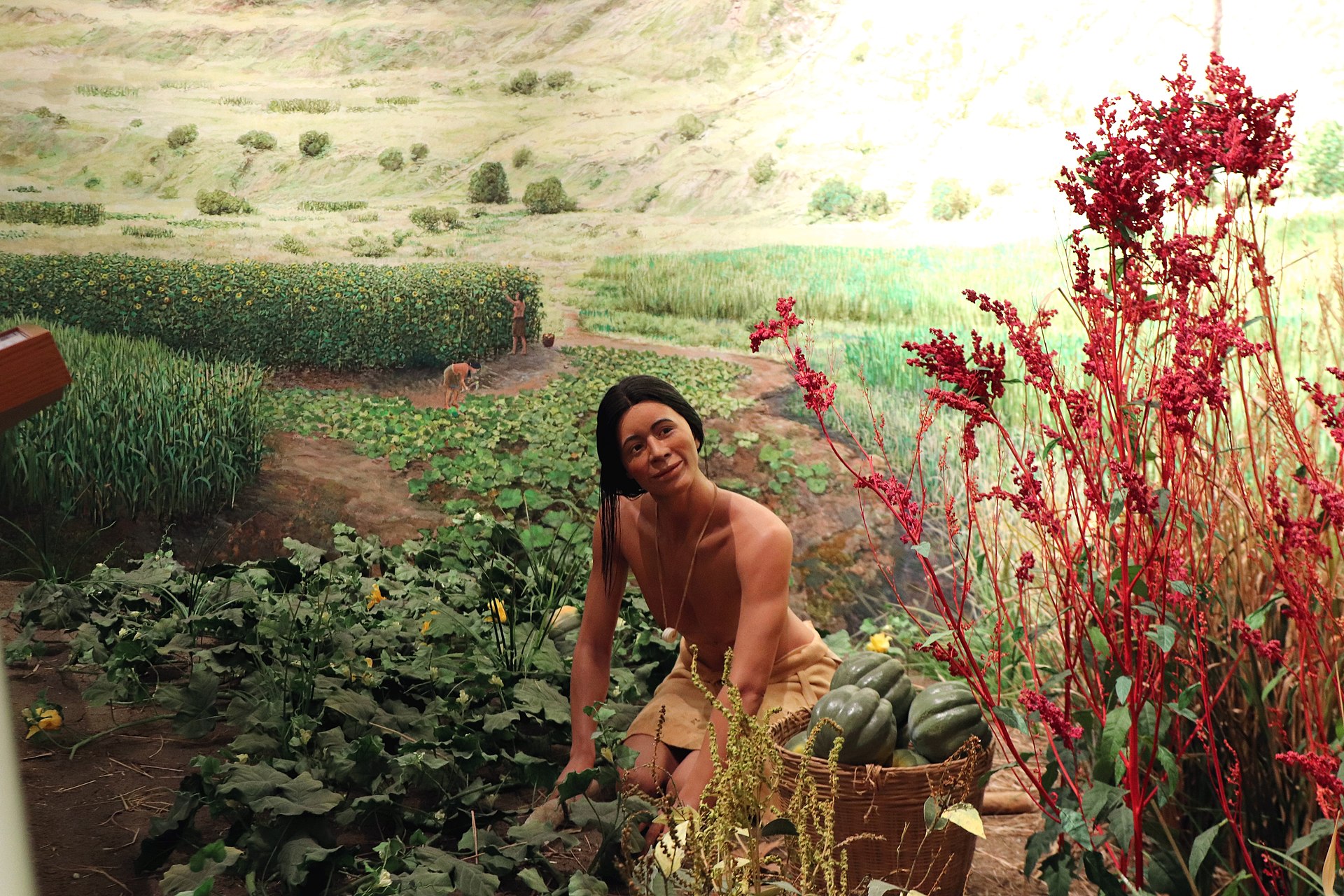 A representation of the domesticated plant species cultivated by Indigenous peoples have influenced the crops that were produced globally. Plants  The ancient Mesoamerican engraving of maize now on display at the National Museum of Anthropology in Mexico For thousands of years, Indigenous peoples domesticated, bred, and cultivated a large array of plant species. These species now constitute between 50% and 60% of all crops in cultivation worldwide.[164] In certain cases, the Indigenous peoples developed entirely new species and strains through artificial selection, as with the domestication and breeding of maize from wild teosinte grasses in the valleys of southern Mexico. Numerous such agricultural products retain their Native names in the English and Spanish lexicons. The South American highlands became a center of early agriculture. Genetic testing of the wide variety of cultivars and wild species suggests that the potato has a single origin in the area of southern Peru,[165] from a species in the Solanum brevicaule complex. Over 99% of all modern cultivated potatoes worldwide are descendants of a subspecies indigenous to south-central Chile,[166] Solanum tuberosum ssp. tuberosum, where it was cultivated as long as 10,000 years ago.[167][168] According to Linda Newson, "It is clear that in pre-Columbian times some groups struggled to survive and often suffered food shortages and famines, while others enjoyed a varied and substantial diet."[169] Persistent drought around AD 850 coincided with the collapse of the Classic Maya civilization, and the famine of One Rabbit (AD 1454) was a major catastrophe in Mexico.[170]  The common bean is native to Mexico and Central America and later began to be cultivated in South America. Indigenous peoples of North America began practicing farming approximately 4,000 years ago, late in the Archaic period of North American cultures. Technology had advanced to the point where pottery had started to become common and the small-scale felling of trees had become feasible. Concurrently, the Archaic Indigenous peoples began using fire in a controlled manner. They carried out the intentional burning of vegetation to mimic the effects of natural fires that tended to clear forest understories. It made travel easier and facilitated the growth of herbs and berry-producing plants, which were important both for food and for medicines.[171] In the Mississippi River valley, Europeans noted that Native Americans managed groves of nut and fruit trees not far from villages and towns and their gardens and agricultural fields. They would have used prescribed burning farther away, in forest and prairie areas.[172]  The tomato (jitomate, in central Mexico) was later cultivated by the pre-Hispanic civilizations of Mexico. Many crops first domesticated by Indigenous peoples are now produced and used globally, most notably maize (or "corn") arguably the most important crop in the world.[173] Other significant crops include cassava; chia; squash (pumpkins, zucchini, marrow, acorn squash, butternut squash); the pinto bean, Phaseolus beans including most common beans, tepary beans, and lima beans; tomatoes; potatoes; sweet potatoes; avocados; peanuts; cocoa beans (used to make chocolate); vanilla; strawberries; pineapples; peppers (species and varieties of Capsicum, including bell peppers, jalapeños, paprika, and chili peppers); sunflower seeds; rubber; brazilwood; chicle; tobacco; coca; blueberries, cranberries, and some species of cotton. Studies of contemporary Indigenous environmental management—including agro-forestry practices among Itza Maya in Guatemala and hunting and fishing among the Menominee of Wisconsin—suggest that longstanding "sacred values" may represent a summary of sustainable millennial traditions.[174] |
農業 関連項目:メソアメリカの農業、インカの農業、東部農業複合体、グレートプレーンズの先史時代農業、南西部アメリカ合衆国の先史時代農業  ジョージ・キャトリンの絵画に描かれたバイソン狩り(1844年)  先住民が栽培した家畜化された植物種の表現は、世界中で生産された作物に影響を与えた。(復元ジオラマ) 植物  メキシコ国立人類学博物館に展示されている古代メソアメリカのトウモロコシの彫刻 何千年もの間、先住民は多種多様な植物種を家畜化し、品種改良し、栽培してきた。これらの種は現在、世界中で栽培されている全作物の50%から60%を占 めている。[164] 特定の事例では、先住民が人工選択によって全く新しい種や品種を開発した。例えばメキシコ南部渓谷の野生トウモロコシ(テオシント)からトウモロコシが家 畜化・品種改良されたケースがそれだ。こうした農産物の多くは、英語やスペイン語の語彙において先住民由来の名称を今なお保持している。 南米高地は初期農業の中心地となった。多様な栽培品種と野生種の遺伝子検査から、ジャガイモはペルー南部地域に単一起源を持つことが示唆されている [165]。その起源はソラヌム・ブレヴィカウレ複合体の種である。現代世界で栽培されるジャガイモの99%以上は、チリ中南部に自生する亜種の子孫であ る。[166] ソラヌム・テュベロサム亜種テュベロサムである。この地域では1万年前から栽培されていた[167][168]。リンダ・ニューソンによれば、「コロンブ ス以前の時代、生存をかけた闘いを強いられ、食糧不足や飢饉という苦悩に直面する集団もあれば、多様で十分な食生活を享受する集団も存在したことは明らか である」[169]。 西暦850年頃の持続的な干ばつは古典期マヤ文明の崩壊と一致し、ウサギの飢饉(西暦1454年)はメキシコにおける大災害であった。[170]  インゲンマメはメキシコと中央アメリカ原産であり、後に南アメリカでも栽培が始まった。 北米先住民は、北米文化の古風期後期にあたる約4000年前に農耕を始めた。技術は陶器が普及し始め、小規模な伐採が可能になるほど進歩していた。同時 に、古風期の先住民は火を制御して使うようになった。彼らは意図的に植生を焼き払い、森林の下層を清掃する自然火災の効果を模倣したのである。これにより 移動が容易になり、薬草やベリー類を実らせる植物の生育が促進された。これらは食料としても薬としても重要であった。[171] ミシシッピ川流域では、ヨーロッパ人が先住民が村や町、菜園や農地の近くでナッツや果樹の林を管理していることに気づいた。彼らはより遠くの森林や草原地帯では計画焼却を行っていたはずだ。[172]  トマト(中央メキシコでは「jitomate」)は後に、ヒスパニック以前のメキシコ文明によって栽培された。 多くの作物は、最初に先住民によって栽培化されたが、現在では世界中で生産・利用されている。最も顕著なのはトウモロコシ(または「コーン」)であり、お そらく世界で最も重要な作物である。[173] その他の重要な作物には、キャッサバ、チア、カボチャ類(カボチャ、ズッキーニ、マーロウ、アコーンカボチャ、バターナットカボチャ)、ピント豆、インゲ ン豆(一般的な豆類、テパリ豆、リマ豆を含む)、トマト、ジャガイモ、サツマイモ、アボカド、落花生、カカオ豆(チョコレート製造用)、 バニラ、イチゴ、パイナップル、トウガラシ(パプリカ、ハラペーニョ、パプリカ、チリペッパーを含むカプシカム属の種と品種)、ヒマワリの種、ゴム、ブラ ジルの木、チクル、タバコ、コカ、ブルーベリー、クランベリー、そしていくつかの綿花種がある。 グアテマラのイツァ・マヤにおける農林業実践やウィスコンシン州メノミニー族の狩猟・漁労など、現代先住民の環境管理に関する研究は、長年にわたる「神聖な価値」が、持続可能な千年単位の伝統の集約を表している可能性を示唆している。[174] |
| Animals Numerous Native American dog breeds have been used by the people of the Americas, such as the Canadian Eskimo dog, the Carolina dog, and the Chihuahua. Some Indigenous peoples in the Great Plains used dogs for pulling travois, while others like the Tahltan bear dog were bred to hunt larger game. Some Andean cultures also bred the Chiribaya to herd llamas. The vast majority of indigenous dog breeds in the Americas went extinct, due to being replaced by dogs of European origin.[175] The Fuegian dog was a domesticated variation of the culpeo that was raised by several cultures in Tierra del Fuego, like the Selkʼnam and the Yahgan.[176] It was exterminated by Argentine and Chilean settlers, due to supposedly posing as a threat to livestock.[177] Several bird species, such as turkeys, Muscovy ducks, Puna ibis, and neotropic cormorants were domesticated by various peoples in Mesoamerica and South America to be used for poultry. In the Andean region, Indigenous peoples domesticated llamas and alpacas to produce fiber and meat. The llama was the only beast of burden in the Americas before European colonization. Guinea pigs were domesticated from wild cavies to be raised for meat consumption in the Andean region. Guinea pigs are now widely raised in Western society as household pets. In Oasisamerica, several cultures raised scarlet macaws imported from Mesoamerica for their feathers.[178][179] In the Maya civilization, stingless bees were domesticated to produce balché.[180] Cochineal were harvested by Mesoamerican and Andean civilizations for coloring fabrics via carminic acid.[181][182][183] |
動物 アメリカ大陸では、カナディアン・エスキモー・ドッグ、カロライナ・ドッグ、チワワなど、数多くの先住民犬種が利用されてきた。グレートプレーンズの先住 民の中には、トラヴォワ(荷曳き用そり)を引くために犬を使った者もいれば、タールタン・ベア・ドッグのように大型の獲物を狩るために飼育された犬種も あった。アンデス地方の文化では、ラマの群れを群畜するためにチリバヤを飼育した。アメリカ大陸の先住民犬種の大半は、ヨーロッパ原産の犬に取って代わら れたため絶滅した。[175] フエゴ島犬は、セルクナム族やヤガン族などフエゴ島諸文化で飼育されたクルペオの飼い犬種だった。[176] 家畜への脅威とされるため、アルゼンチンとチリの入植者によって絶滅させられた。[177] 七面鳥、マスコビ鴨、プーナイビス、新熱帯区鵜など、いくつかの鳥類は、家禽として利用するために、メソアメリカや南アメリカの様々な民族によって家畜化された。 アンデス地域では、先住民が繊維と肉を得るためにラマとアルパカを家畜化した。ラマは、ヨーロッパによる植民地化以前、アメリカ大陸で唯一の荷役動物であった。 モルモットはアンデス地域で肉食目的として野生カビィから家畜化された。現在では西洋社会で広く家庭用ペットとして飼育されている。 オアシスアメリカでは、いくつかの文化圏が羽根を得るためにメソアメリカから輸入されたスカーレットマコーを飼育していた[178][179]。 マヤ文明では、バルチェを生産するために刺さない蜂が家畜化された[180]。 コチニールは、カルミン酸による布地の染色を目的として、メソアメリカとアンデスの文明圏で採取されていた[181][182][183]。 |
| Culture Further information: Classification of Indigenous peoples of the Americas, Mythologies of the Indigenous peoples of the Americas, Category:Archaeological cultures of North America, and Category:Archaeological cultures of South America Cultural practices in the Americas seem to have been shared mostly within geographical zones where distinct ethnic groups adopt shared cultural traits, similar technologies, and social organizations. An example of such a cultural area is Mesoamerica, where millennia of coexistence and shared development among the peoples of the region produced a fairly homogeneous culture with complex agricultural and social patterns. Another well-known example is the North American plains where until the 19th century several peoples shared the traits of nomadic hunter-gatherers based primarily on bison hunting. Languages Main article: Indigenous languages of the Americas 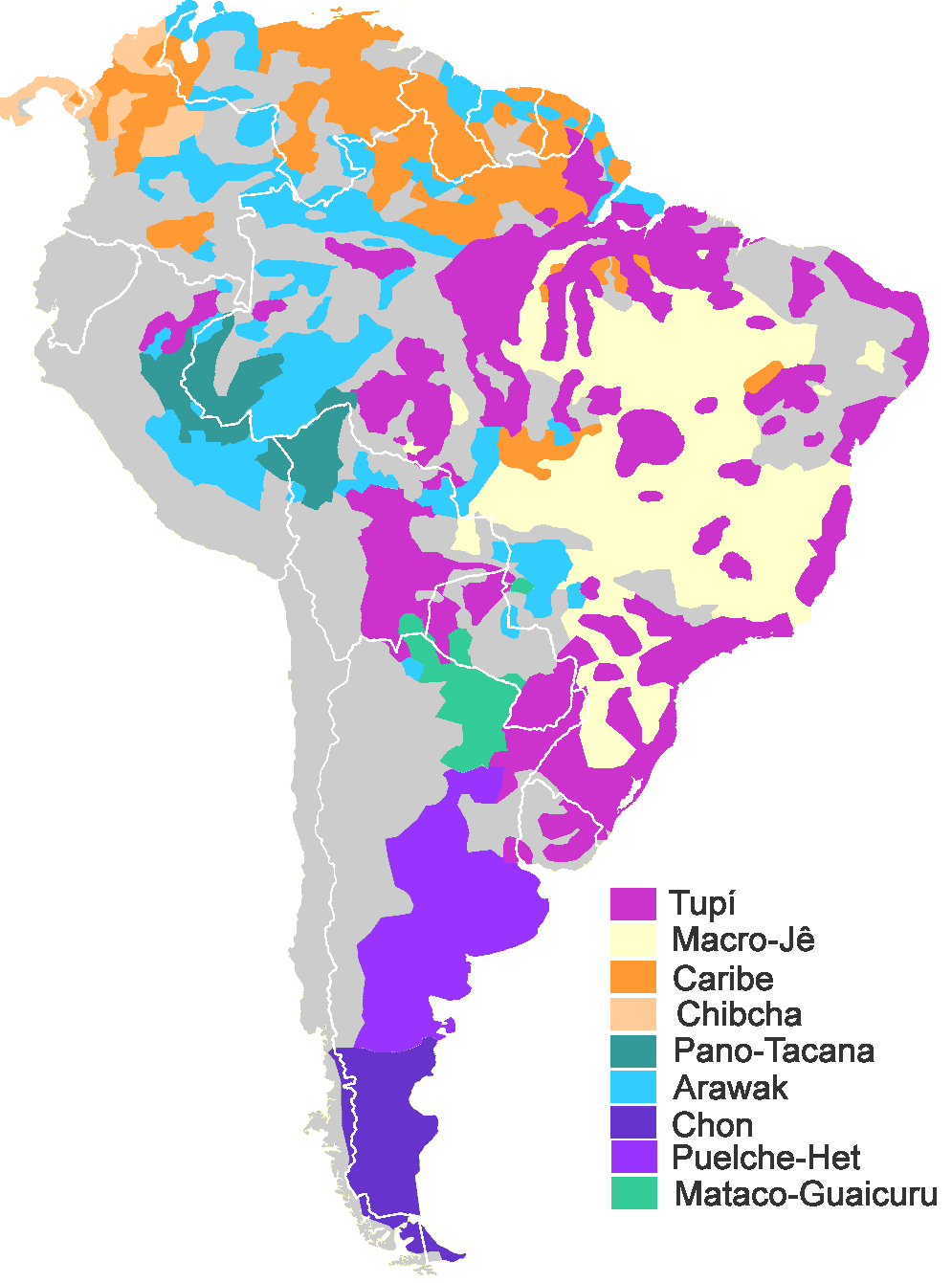 The major indigenous language families of much of present-day South America and Panama Indigenous languages in North America have been classified into 56 groups or stock tongues, in which the spoken languages of the various nations may be said to center. In connection with speech, reference may be made to gesture language which was highly developed in parts of this area. Of equal interest is the picture writing especially well developed among the Anishinaabe and Lenape nations.[184] |
文化 詳細情報: アメリカ先住民の分類、アメリカ先住民の神話体系、カテゴリ:北アメリカの考古学的文化、カテゴリ:南アメリカの考古学的文化 アメリカ大陸における文化的慣行は、主に地理的領域内で共有されていたようだ。そこでは、異なる民族集団が共通の文化的特徴、類似の技術、社会組織を採用 していた。そうした文化圏の一例がメソアメリカである。この地域では、数千年にわたる共存と共同発展が、複雑な農業・社会構造を備えた比較的均質な文化を 生み出した。もう一つの有名な例は北米平原で、19世紀まで複数の人民がバイソン狩りを主とする遊牧的狩猟採集民の特性を共有していた。 言語 詳細記事: アメリカ先住民言語  現在の南アメリカとパナマの大部分を占める主要な先住民言語族 北アメリカの先住民言語は56のグループまたは語族に分類されており、各国民の話し言葉はこれらを中心に発展したと言える。言語に関連して、この地域の一 部で高度に発達したジェスチャー言語に言及できる。同様に興味深いのは、特にアニシナベ族とレナペ族の間で高度に発達した絵文字である。[184] |
| Writing systems See also: Syllabics used by Indigenous peoples living in Canada, Cherokee syllabary, and Quipu  Maya glyphs in stucco now on display at Museo de sitio in Palenque, Mexico Beginning in the 1st millennium BCE, pre-Columbian cultures in Mesoamerica developed several Indigenous writing systems (independent of any influence from the writing systems that existed in other parts of the world). The Cascajal Block is perhaps the earliest-known example in the Americas of what may be an extensive written text. The Olmec hieroglyphs tablet has been indirectly dated (from ceramic shards found in the same context) to approximately 900 BCE which is around the same time that the Olmec occupation of San Lorenzo Tenochtitlán began to weaken.[185] The Maya writing system was logosyllabic (a combination of phonetic syllabic symbols and logograms). It is the only pre-Columbian writing system known to have completely represented the spoken language of its community. It has more than a thousand different glyphs, but a few are variations on the same sign or have the same meaning, many appear only rarely or in particular localities, no more than about five hundred were in use in any given time, and, of those, it seems only about two hundred (including variations) represented a particular phoneme or syllable.[186][187][188] The Zapotec writing system, one of the earliest in the Americas,[189] was logographic and presumably syllabic.[189] There are remnants of Zapotec writing in inscriptions on some of the monumental architecture of the period, but so few inscriptions are extant that it is difficult to fully describe the writing system. The oldest example of the Zapotec script, dating from around 600 BCE, is on a monument that was discovered in San José Mogote.[190][full citation needed] Aztec codices (singular codex) are books that were written by pre-Columbian and colonial-era Aztecs. These codices are some of the best primary sources for descriptions of Aztec culture. The pre-Columbian codices are largely pictorial; they do not contain symbols that represent spoken or written language.[191] By contrast, colonial-era codices contain not only Aztec pictograms, but also writing that uses the Latin alphabet in several languages: Classical Nahuatl, Spanish, and occasionally Latin. Spanish mendicants in the sixteenth century taught Indigenous scribes in their communities to write their languages using Latin letters, and there are a large number of local-level documents in Nahuatl, Zapotec, Mixtec, and Yucatec Maya from the colonial era, many of which were part of lawsuits and other legal matters. Although Spaniards initially taught Indigenous scribes alphabetic writing, the tradition became self-perpetuating at the local level.[192] The Spanish crown gathered such documentation, and contemporary Spanish translations were made for legal cases. Scholars have translated and analyzed these documents in what is called the New Philology to write histories of Indigenous peoples from Indigenous viewpoints.[193] The Wiigwaasabak, birch bark scrolls on which the Ojibwa, an Anishinaabe) people, wrote complex geometrical patterns and shapes, can also be considered a form of writing, as can Mi'kmaq hieroglyphics. Aboriginal syllabic writing, or simply syllabics, is a family of abugidas used to write some Indigenous languages of the Algonquian, Inuit, and Athabaskan language families. |
文字体系 関連項目:カナダ先住民が使用する音節文字、チェロキー音節文字、キプ  メキシコ・パレンケの現地博物館で展示中の漆喰製マヤ文字 紀元前1千年紀から、メソアメリカの先コロンブス期文化は複数の独自文字体系を発展させた(世界の他の地域で存在した文字体系の影響とは無関係に)。カス カハール石碑は、おそらくアメリカ大陸で現存する最古の、大規模な文字記録の例である。オルメカ象形文字碑文は間接的に(同一遺跡から出土した陶片の年代 測定により)紀元前900年頃と推定される。これはオルメカ文明がサン・ロレンソ・テノチティトランでの支配力を弱め始めた時期とほぼ一致する。 マヤ文字体系はロゴシラビック(音節記号と表語文字の組み合わせ)であった。これは、その共同体の話し言葉を完全に表現した唯一の先コロンブス期文字体系 として知られている。千を超える異なる文字を持つが、同じ記号の変形や同義の文字も存在する。多くの文字は稀にしか現れないか特定地域限定であり、同時に 使用されていたのは約500文字に過ぎない。そのうち特定の音素や音節を表すのは(変形を含めて)約200文字程度と見られる。[186][187] [188] サポテック文字体系は、アメリカ大陸で最も古い文字体系の一つであり、表語文字であり、おそらく音節文字であったと考えられている。当時の記念碑的建造物 に刻まれた碑文にサポテック文字の痕跡が残っているが、現存する碑文が極めて少ないため、文字体系を完全に記述することは困難である。ザポテク文字の最古 の例は紀元前600年頃のもので、サン・ホセ・モゴテで発見された記念碑に刻まれている。[190][詳細な出典が必要] アステカ・コデックス(単数形はcodex)は、コロンブス以前および植民地時代のアステカ人によって書かれた書物である。これらのコデックスはアステカ 文化を記述する最良の一次資料の一部だ。コロンブス以前のコデックスは主に絵文字で構成されており、話し言葉や書き言葉を表す記号は含まれていない [191]。これに対し、植民地時代のコデックスにはアステカの絵文字だけでなく、ラテン文字を用いた複数の言語(古典ナワトル語、スペイン語、時にラテ ン語)の文字も記されている。 16世紀、スペインの修道僧たちは現地の書記官たちに、ラテン文字を用いて自国語を記す方法を教えた。その結果、植民地時代にはナワトル語、サポテカ語、 ミシュテカ語、ユカテコ・マヤ語で書かれた地方レベルの文書が大量に存在する。その多くは訴訟やその他の法的問題に関連するものだった。スペイン人が当初 はアルファベット表記を教えたものの、この伝統は地域レベルで自律的に継承された[192]。スペイン王室はこうした文書を収集し、法廷案件向けに当時の スペイン語訳を作成した。学者たちは「新文献学」と呼ばれる手法でこれらの文書を翻訳・分析し、先住民の視点から先住民の歴史を記述している[193]。 ウィグワサバック(Wiigwaasabak)は、アニシナベ(Anishinaabe)族の一派であるオジブワ(Ojibwa)人民が複雑な幾何学模様 や図形を記した樺の樹皮巻物であり、ミクマク(Mi'kmaq)族の象形文字と同様に、一種の文字体系と見なすことができる。 先住民音節文字、あるいは単に音節文字は、アルゴンキン語族、イヌイット語族、アサバスカ語族に属するいくつかの先住民言語を記述するために用いられるアブギダ文字の一群である。 |
| Music and art Main articles: Visual arts by Indigenous peoples of the Americas and Indigenous music 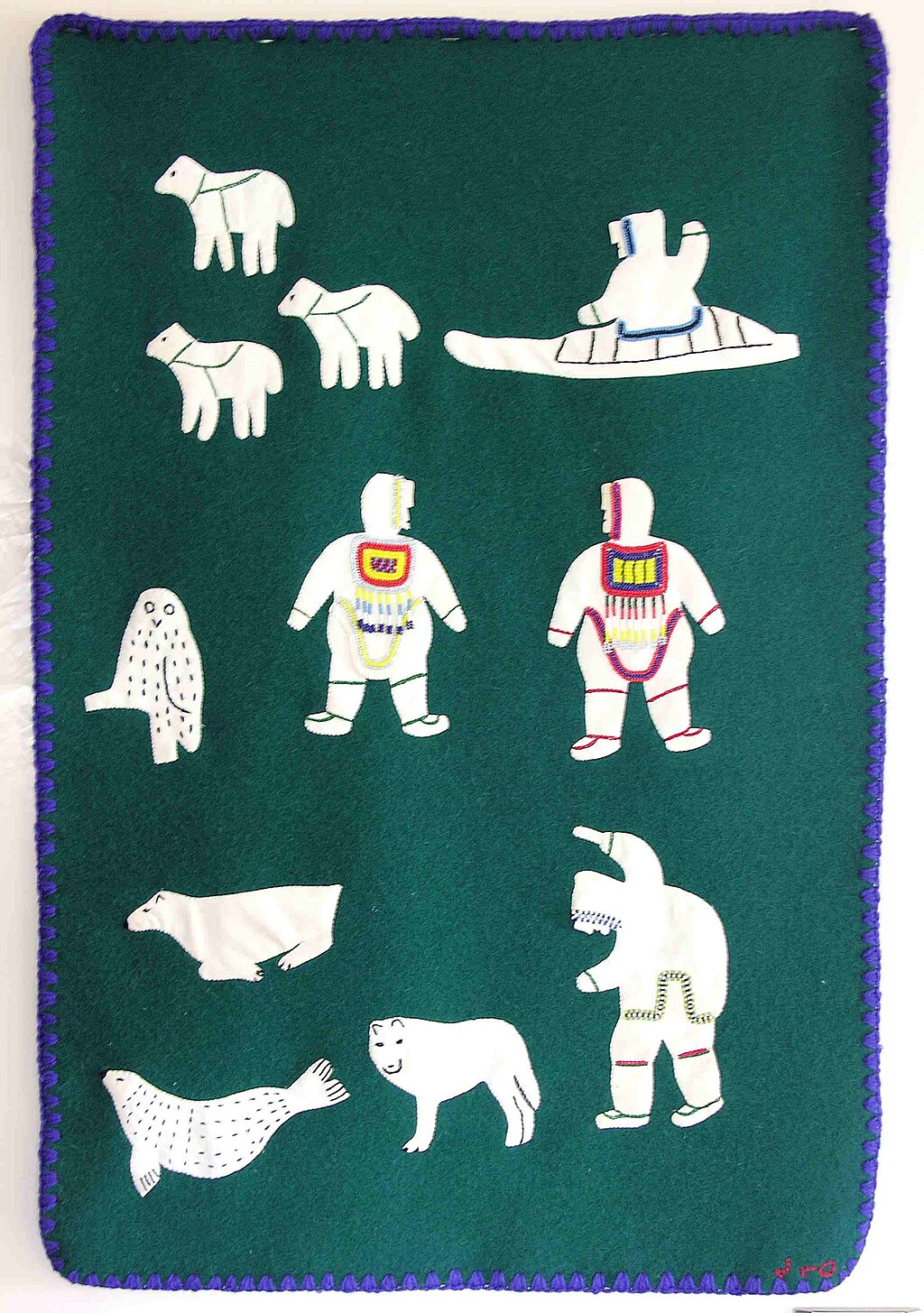 Indigenous peoples textile art in 1995 by Julia Pingushat, including Inuk, Arviat, Nunavut, Canada, wool, and embroidery floss 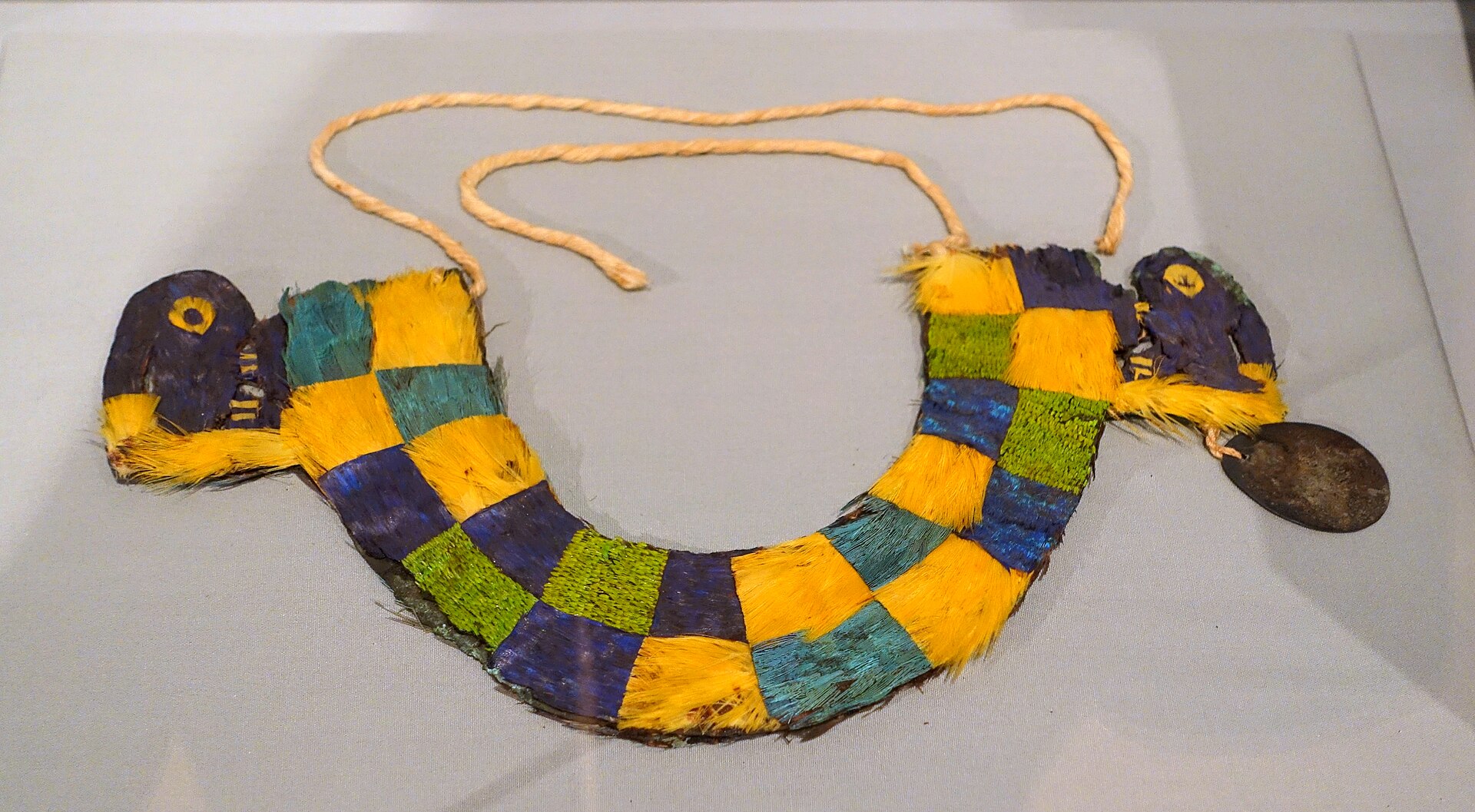 Chimu culture feather pectoral, feathers, reed, copper, silver, hide, cordage, c. 1350–1450 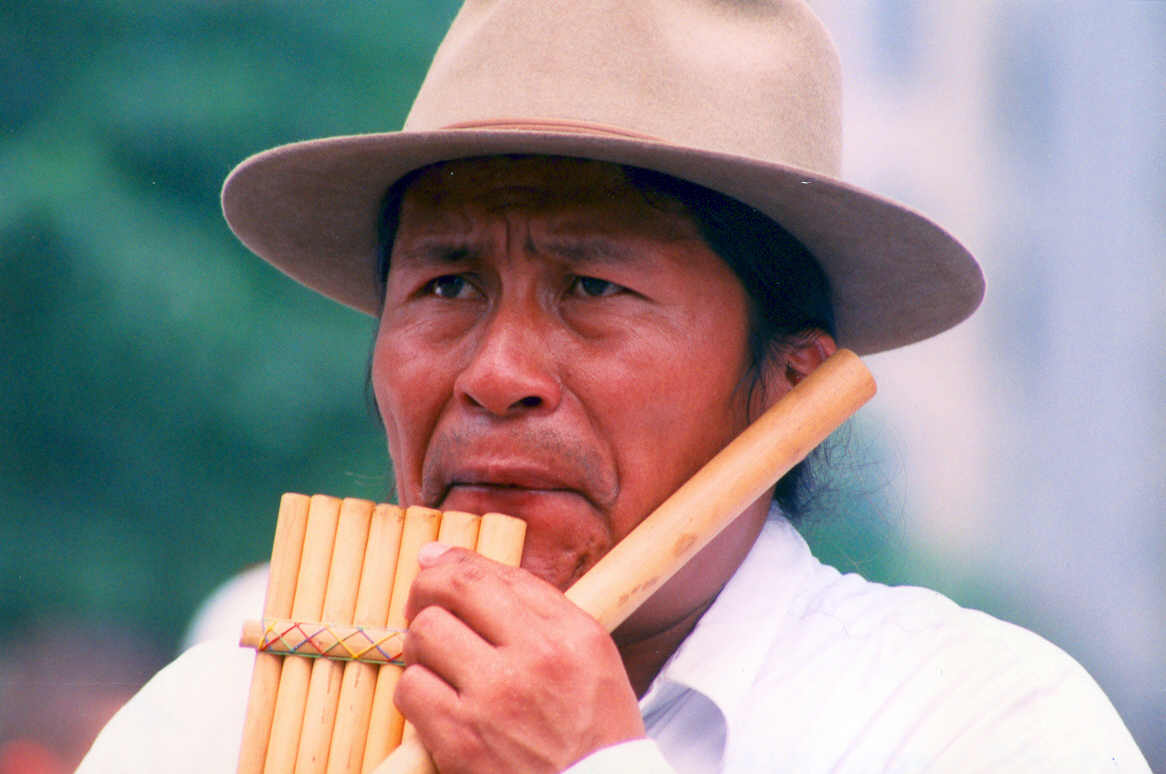 An Indigenous man playing a panpipe, antara, or siku Indigenous music can vary between cultures, however, there are significant commonalities. Traditional music often centers around drumming and singing. Rattles, clapper sticks, and rasps are also popular percussive instruments, both historically and in contemporary cultures. Flutes are made of river cane, cedar, and other woods. The Apache have a type of fiddle, and fiddles are also found many First Nations and Métis cultures. The music of the Indigenous peoples of Central Mexico and Central America, like that of the North American cultures, tends to be spiritual ceremonies. It traditionally includes a large variety of percussion and wind instruments such as drums, flutes, sea shells (used as trumpets), and "rain" tubes. No remnants of pre-Columbian stringed instruments were found until archaeologists discovered a jar in Guatemala, attributed to the Maya of the Late Classic Era (600–900 CE); this jar was decorated with imagery depicting a stringed musical instrument, which has since been reproduced. This instrument is one of the very few stringed instruments known in the Americas before the introduction of European musical instruments; when played, it produces a sound that mimics a jaguar's growl.[194] Visual arts by Indigenous peoples of the Americas comprise a major category in the world art collection. Contributions include pottery, paintings, jewelry, weavings, sculptures, basketry, carvings, and beadwork.[195] Because too many artists were posing as Native Americans and Alaska Natives[196] to profit from the cachet of Indigenous art in the United States, the U.S. passed the Indian Arts and Crafts Act of 1990, requiring artists to prove that they were enrolled in a state or federally recognized tribe. To support the ongoing practice of American Indian, Alaska Native, and Native Hawaiian arts and cultures in the United States,[197] the Ford Foundation, arts advocates, and American Indian tribes created an endowment seed fund and established a national Native Arts and Cultures Foundation in 2007.[198][199] After the entry of the Spaniards, the process of spiritual conquest was favored, among other things, by the liturgical musical service to which the natives, whose musical gifts came to surprise the missionaries, were integrated. The musical gifts of the natives were of such magnitude that they soon learned the rules of counterpoint and polyphony and even the virtuous handling of the instruments. This helped to ensure that it was not necessary to bring more musicians from Spain, which significantly annoyed the clergy.[200] The solution that was proposed was not to employ but a certain number of Indigenous people in the musical service, not to teach them counterpoint, not to allow them to play certain instruments (brass breaths, for example, in Oaxaca, Mexico) and, finally, not to import more instruments so that the Indigenous people would not have access to them. The latter was not an obstacle to the musical enjoyment of the natives, who experienced the making of instruments, particularly rubbed strings (violins and double basses) or plucked (third). It is there where we can find the origin of what is now called traditional music whose instruments have their tuning and a typical Western structure.[201] |
音楽と芸術 主な記事:アメリカ先住民の視覚芸術と先住民音楽  1995年ジュリア・ピンガシャット作、イヌク、アルヴィアット、ヌナブト準州、カナダ、羊毛、刺繍糸を用いた先住民のテキスタイルアート  チムー文化の羽根胸飾り、羽根、葦、銅、銀、皮革、縄、約1350–1450年  パンスフルート(アンタラ、シク)を演奏する先住民の男性 先住民の音楽は文化によって異なるが、重要な共通点もある。伝統音楽はしばしば打楽器と歌唱を中心とする。ガラガラ、クラッパースティック、ラスペも、歴 史的にも現代文化においても人気の打楽器だ。フルートは川竹、杉、その他の木材で作られる。アパッチ族にはバイオリンの一種があり、バイオリンは多くの先 住民族やメティス文化でも見られる。 メキシコ中部と中央アメリカの先住民の音楽は、北米の文化と同様に、霊的な儀式に用いられる傾向がある。伝統的には、太鼓、笛、貝殻(トランペットとして 使用)、雨音管など、多種多様な打楽器や管楽器が含まれる。コロンブス以前の弦楽器の痕跡は、考古学者がグアテマラで発見した壺が確認されるまで見つから なかった。この壺は後期古典期(西暦600~900年)のマヤ文化に属するとされ、弦楽器を描いた装飾が施されていた。この楽器は後に再現されている。こ の楽器は、ヨーロッパの楽器が導入される前にアメリカ大陸で知られていた数少ない弦楽器の一つだ。演奏すると、ジャガーの唸り声を模した音を発する。 [194] アメリカ先住民による視覚芸術は、世界の美術コレクションにおいて主要なカテゴリーを構成している。その貢献には、陶器、絵画、宝飾品、織物、彫刻、籠細 工、木彫り、ビーズ細工などが含まれる。[195] 米国では先住民芸術の威信を利用して利益を得ようとする、自称ネイティブアメリカンやアラスカ先住民の芸術家があまりにも多すぎたため[196]、 1990年に「インディアン芸術工芸法」が制定された。これにより芸術家は、州または連邦政府が認定する部族に登録されていることを証明することが義務付 けられた。アメリカインディアン、アラスカインディアン、ハワイインディアン の芸術と文化を米国で継続的に支援するため[197]、フォード財団、芸術支援団体、アメリカインディアン部族は2007年に基金の種銭を創設し、全国的 なネイティブ・アーツ・アンド・カルチャーズ財団を設立した[198][199]。 スペイン人の到来後、精神的征服のプロセスは、とりわけ典礼音楽奉仕によって促進された。この奉仕には、その音楽的才能が宣教師たちを驚かせた先住民たち が組み込まれたのである。先住民の音楽的才能は極めて高く、彼らはすぐに対位法やポリフォニーの規則、さらには楽器の高度な演奏技法さえも習得した。これ により、スペインから追加の音楽家を連れてくる必要がなくなり、聖職者たちを大いに苛立たせた。[200] 提案された解決策は、音楽奉仕に一定数の先住民を雇用すること、彼らに対位法を教えないこと、特定の楽器(例えばメキシコ・オアハカ州の金管楽器など)を 演奏させないこと、そして最後に、先住民がそれらにアクセスできないように、これ以上楽器を輸入しないことだった。後者の措置は、楽器製作、特に摩擦弦楽 器(ヴァイオリンやコントラバス)や撥弦楽器(第三弦楽器)の製作を体験する先住民の音楽的楽しみを妨げるものではなかった。現代で伝統音楽と呼ばれるも のの起源はここにあり、その楽器は独自の調律と典型的な西洋的構造を有しているのだ。[201] |
| History and status by continent and country North America Canada Main article: Indigenous peoples in Canada 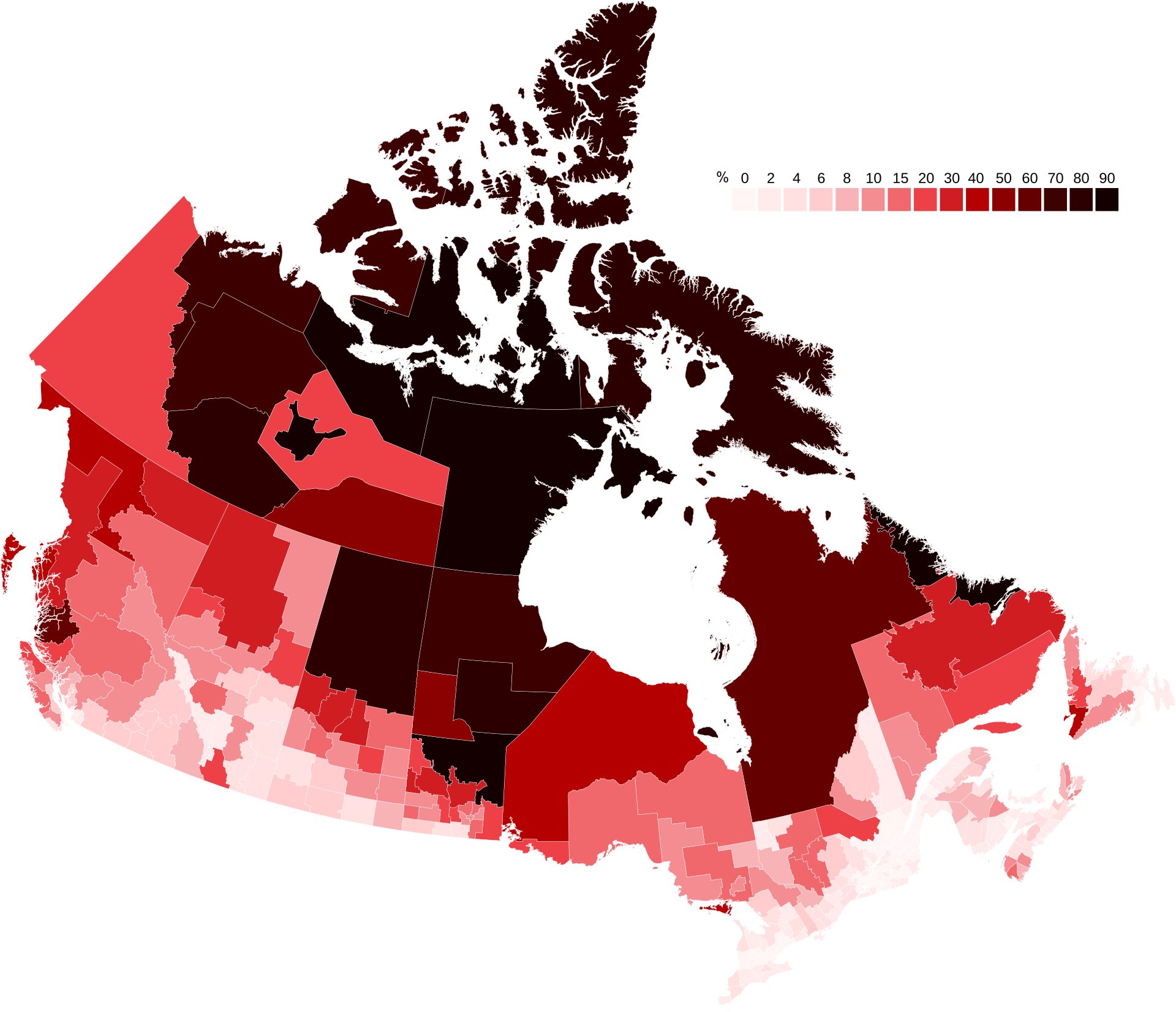 A map of Canada showing the percent of self-reported Indigenous identity (First Nations, Inuit, Métis) by census division, according to the 2021 Canadian census[202] These paragraphs are an excerpt from Indigenous peoples in Canada.[edit] Indigenous peoples in Canada (also known as Aboriginals)[203] are the Indigenous peoples within the boundaries of Canada. They comprise the First Nations,[204] Inuit,[205] and Métis,[206] representing roughly 5.0% of the total Canadian population. There are over 600 recognized First Nations governments or bands with distinctive cultures, languages, art, and music.[207][208] Old Crow Flats and Bluefish Caves are some of the earliest known sites of human habitation in Canada.[209] The characteristics of Indigenous cultures in Canada prior to European colonization included permanent settlements,[210] agriculture,[211] civic and ceremonial architecture,[212] complex societal hierarchies, and trading networks.[213] Métis nations of mixed ancestry originated in the mid-17th century when First Nations and Inuit married Europeans, primarily French settlers.[214] First Nations and Métis peoples played a critical part in the development of European colonies in Canada, particularly for their role in assisting Europeans during the North American fur trade. Various Aboriginal laws, treaties, and legislation have been enacted between European immigrants and Indigenous groups across Canada. The impact of settler colonialism in Canada can be seen in its culture, history, politics, laws, and legislatures.[215] Historically, this included assimilationist policies affecting Indigenous languages, traditions, religion and the degradation of Indigenous communities that has contemporarily been described by some, including academics and politicians, as a cultural genocide, or genocide.[216] The modern Indigenous right to self-government provides for Indigenous self-government in Canada and the management of cultural, political, health and economic responsibilities within Indigenous communities. National Indigenous Peoples Day recognizes the vast cultures and contributions of Indigenous peoples to the history of Canada.[217] First Nations, Inuit, and Métis peoples of all backgrounds have become prominent figures in Canada and have helped shape the Canadian cultural identity.[218] |
大陸および国別の歴史と現状 北アメリカ カナダ 詳細記事: カナダの先住民  2021年カナダ国勢調査に基づく、国勢調査区分ごとの自己申告による先住民(ファースト・ネーションズ、イヌイット、メティス)の割合を示すカナダ地図[202] これらの段落は「カナダの先住民」からの抜粋である。[編集] カナダの先住民(アボリジナルとも呼ばれる)[203]は、カナダ国内に居住する先住民族である。ファースト・ネーションズ[204]、イヌイット [205]、メティス[206]で構成され、カナダ総人口の約5.0%を占める。600以上の公認ファースト・ネーションズ政府またはバンドが存在し、そ れぞれ独自の文化、言語、芸術、音楽を有する[207]。[208] オールド・クロウ・フラッツやブルーフィッシュ洞窟は、カナダにおける人類居住の最古の遺跡として知られている。[209] ヨーロッパ人による植民地化以前のカナダ先住民文化の特徴には、恒久的な集落、[210] 農業、[211] 公共建築や儀式用建築、[212] 複雑な社会階層、交易ネットワークなどが含まれていた。[213] 混血のメティス国民は、17世紀半ばに先住民やイヌイットが主にフランス人入植者であるヨーロッパ人と結婚したことで生まれた。[214] 先住民とメティス人民は、特に北米毛皮交易においてヨーロッパ人を支援した役割から、カナダにおけるヨーロッパ植民地の発展に重要な役割を果たした。 カナダ全土で、ヨーロッパ系移民と先住民族グループの間で様々な先住民法、条約、立法が制定されてきた。カナダにおける入植者植民地主義の影響は、その文 化、歴史、政治、法律、立法府に見られる。[215] 歴史的には、先住民の言語、伝統、宗教に影響を及ぼす同化政策や、先住民コミュニティの衰退が含まれ、現代では学者や政治家を含む一部の人々によって文化 的ジェノサイド、あるいはジェノサイドと表現されている。[216] 現代の先住民自治権は、カナダにおける先住民自治と、先住民コミュニティ内での文化的・政治的・健康・経済的責任の管理を規定している。全国先住民の日 は、先住民の多様な文化とカナダ史への貢献を認めるものである。[217]あらゆる背景を持つファースト・ネーションズ、イヌイット、メティスの人々は、 カナダで著名な存在となり、カナダの文化的アイデンティティ形成に貢献してきた。[218] |
| Greenland Main article: Greenlandic Inuit 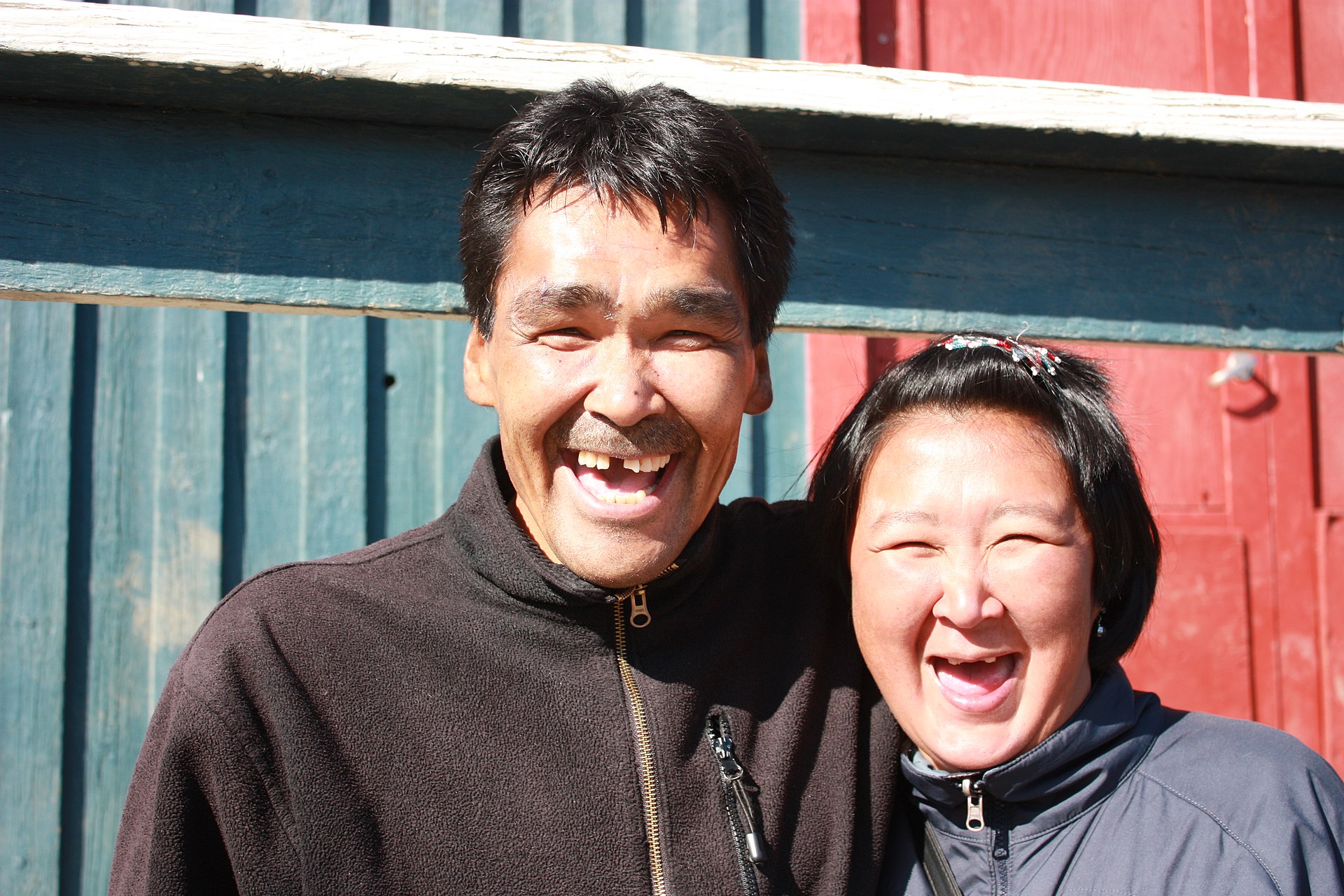 Tunumiit Inuit couple from Kulusuk, Greenland The Greenlandic Inuit (Kalaallisut: kalaallit, Tunumiisut: tunumiit, Inuktun: inughuit) are the Indigenous and most populous ethnic group in Greenland.[219] This means that Denmark has one officially recognized Indigenous group. the Inuit – the Greenlandic Inuit of Greenland and the Greenlandic people in Denmark (Inuit residing in Denmark). Approximately 89 percent of Greenland's population of 57,695 is Greenlandic Inuit, or 51,349 people as of 2012.[36][220] Ethnographically, they consist of three major groups: the Kalaallit of west Greenland, who speak Kalaallisut the Tunumiit of Tunu (east Greenland), who speak Tunumiit oraasiat ("East Greenlandic") the Inughuit of north Greenland, who speak Inuktun ("Polar Inuit") |
グリーンランド 主な記事: グリーンランド・イヌイット  クルスク出身のトゥヌミット・イヌイットの夫婦 グリーンランド・イヌイット(カラアルリート語: カラアルリット、トゥヌミート語: トゥヌミート、イヌクトゥン語: イヌグイット)は、グリーンランドの先住民族であり、最も人口の多い民族集団である。[219] これはデンマークが公式に認める先住民が1つだけであることを意味する。イヌイットである――グリーンランドのグリーンランド・イヌイットと、デンマーク 在住のグリーンランド人(デンマーク居住イヌイット)だ。 2012年時点で、グリーンランドの人口57,695人の約89%がグリーンランド・イヌイットであり、51,349人に上る。[36][220] 民族誌的には、彼らは三つの主要なグループから成る: 西グリーンランドのカラリット(Kalaallit)。カラアリスート(Kalaallisut)を話す。 東グリーンランド(トゥヌ)のトゥヌミット(Tunumiit)。トゥヌミット・オラアシート(Tunumiit oraasiat、いわゆる「東グリーンランド語」)を話す。 北グリーンランドのイヌイット(Inughuit)。イヌクトゥン(Inuktun、いわゆる「極地イヌイット語」)を話す。 |
| Mexico Main article: Indigenous peoples of Mexico  Proportion of Native Mexicans in each municipalities in 2020. 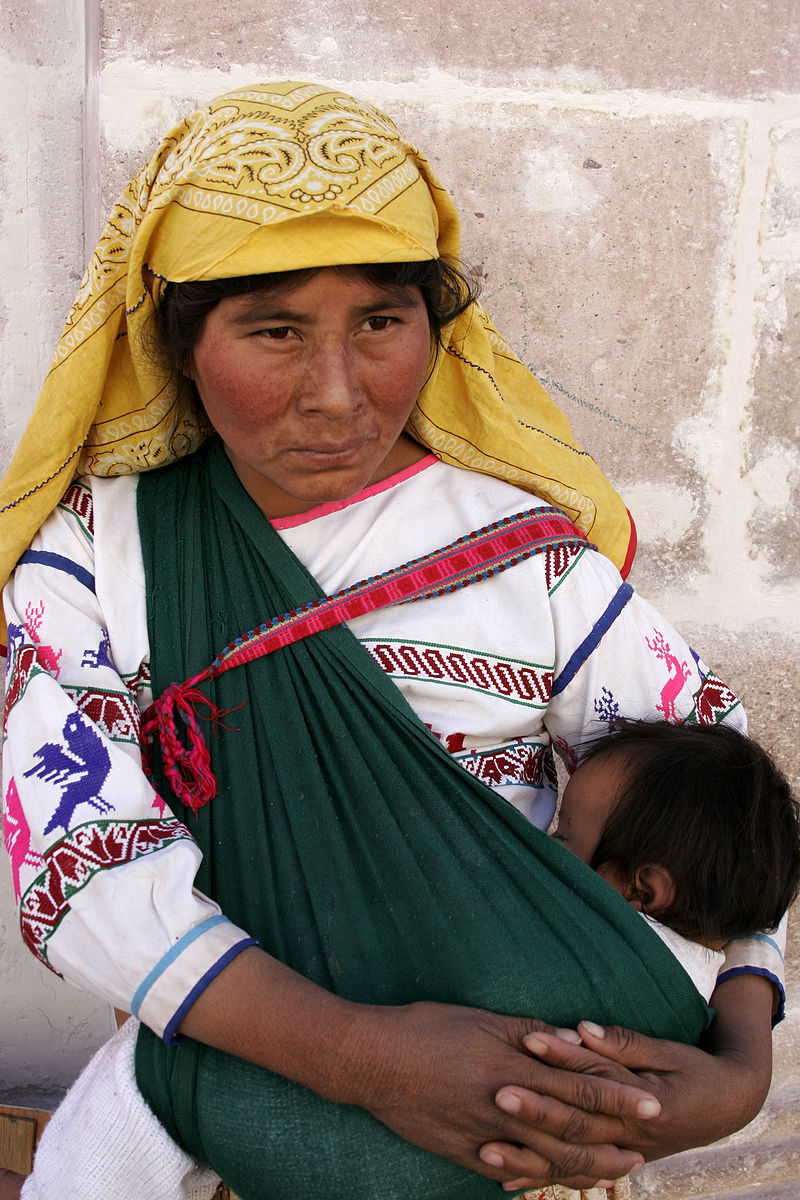 A Huichol woman from Zacatecas, Mexico 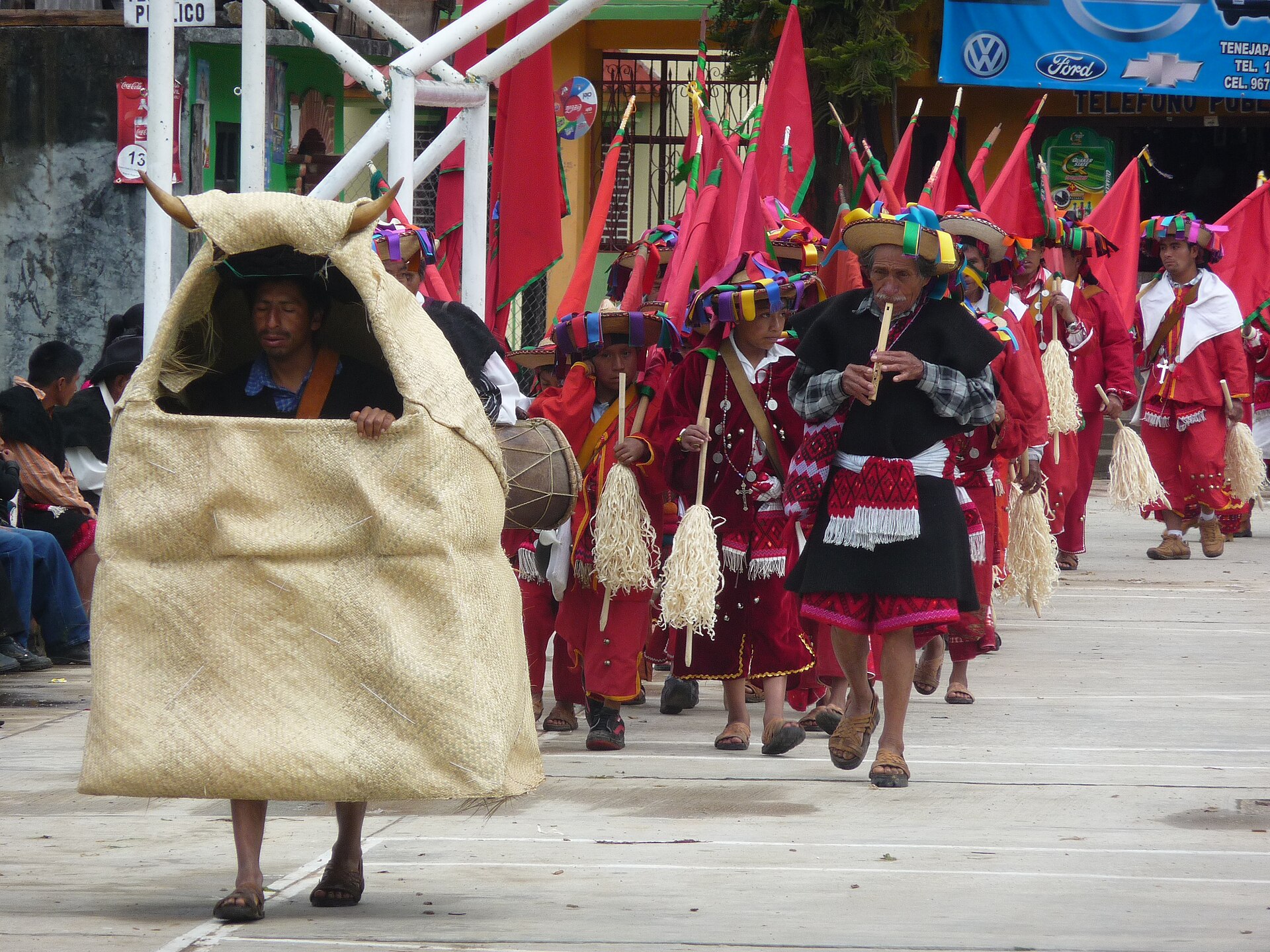 A carnival with Tzeltal people in Tenejapa Municipality, Chiapas The territory of modern-day Mexico was home to numerous Indigenous civilizations before the arrival of the Spanish conquistadores: The Olmecs, who flourished from between 1200 BCE to about 400 BCE in the coastal regions of the Gulf of Mexico; the Zapotecs and the Mixtecs, who held sway in the mountains of Oaxaca and the Isthmus of Tehuantepec; the Maya in the Yucatán (and into neighboring areas of contemporary Central America); the Purépecha in present-day Michoacán and surrounding areas, and the Aztecs/Mexica, who, from their central capital at Tenochtitlan, dominated much of the center and south of the country (and the non-Aztec inhabitants of those areas) when Hernán Cortés first landed at Veracruz. In contrast to what was the general rule in the rest of North America, the history of the colony of New Spain was one of racial intermingling (mestizaje). Mestizos, which in Mexico designate people who do not identify culturally with any Indigenous grouping, quickly came to account for a majority of the colony's population. Today, Mestizos in Mexico of mixed Indigenous and European ancestry (with a minor African contribution) are still a majority of the population. Genetic studies vary over whether Indigenous or European ancestry predominates in the Mexican Mestizo population.[221][222] In the 2020 INEGI census, 23.2 million people (19.4% of the Mexican population aged 3 years and older) self-identified as Indigenous.[2] Somewhat contradictorily, in the same 2020 census, 11.8 million people (9.3% of the Mexican population) were determined to be Indigenous by the Mexican government based on the language spoken in their households.[1] The Indigenous population is distributed throughout the territory of Mexico but is especially concentrated in the Sierra Madre del Sur, the Yucatán Peninsula, and the most remote and difficult-to-access areas, such as the Sierra Madre Oriental, the Sierra Madre Occidental, and neighboring areas.[223] The CDI identifies 62 Indigenous groups in Mexico, each with a unique language.[224][225] In the states of Chiapas and Oaxaca and the interior of the Yucatán Peninsula, a large amount of the population is of Indigenous descent with the largest ethnic group being Maya with a population of 900,000.[226] Large Indigenous minorities, including Aztecs or Nahua, Purépechas, Mazahua, Otomi, and Mixtecs are also present in the central regions of Mexico. In the Northern and Bajio regions of Mexico, Indigenous people are a small minority. The General Law of Linguistic Rights of the Indigenous Peoples grants all Indigenous languages spoken in Mexico, regardless of the number of speakers, the same validity as Spanish in all territories in which they are spoken, and Indigenous peoples are entitled to request some public services and documents in their native languages.[227] Along with Spanish, the law has granted them—more than 60 languages—the status of "national languages". The law includes all Indigenous languages of the Americas regardless of origin; that is, it includes the Indigenous languages of ethnic groups non-native to the territory. The National Commission for the Development of Indigenous Peoples recognizes the language of the Kickapoo, who immigrated from the United States[228] and recognizes the languages of the Indigenous refugees from Guatemala.[229] The Mexican government has promoted and established bilingual primary and secondary education in some Indigenous rural communities. Nonetheless, of the Indigenous peoples in Mexico, 93% are either native speakers or bilingual second-language speakers of Spanish with only about 62.4% of them (or 5.4% of the country's population) speaking an Indigenous language and about a sixth do not speak Spanish (0.7% of the country's population).[230] 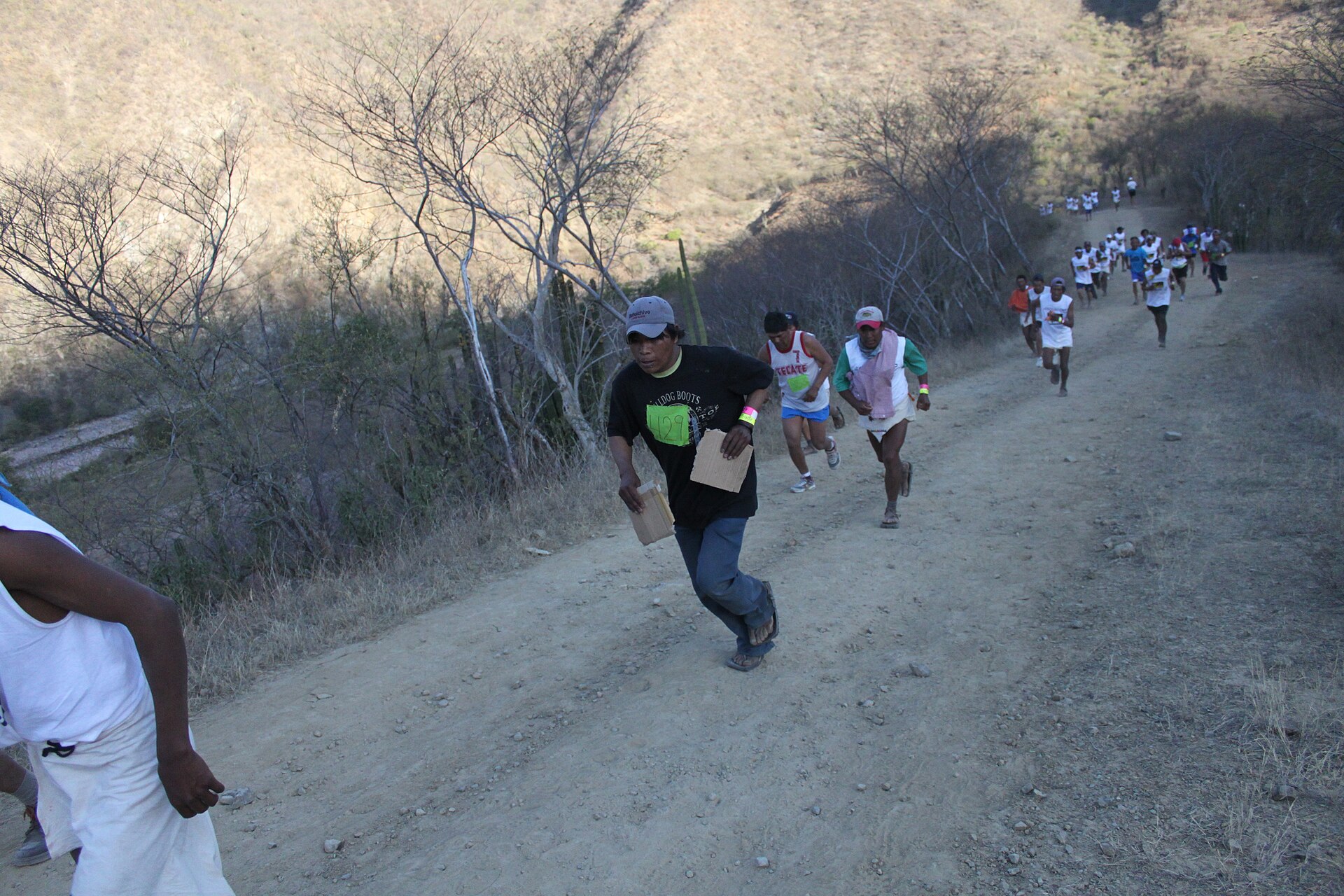 The Rarámuri marathon in Urique The Indigenous peoples in Mexico have the right of free determination under the second article of the constitution. According to this article, the Indigenous peoples are granted:[231] the right to decide the internal forms of social, economic, political, and cultural organization; the right to apply their normative systems of regulation as long as human rights and gender equality are respected; the right to preserve and enrich their languages and cultures; the right to elect representatives before the municipal council in which their territories are located; amongst other rights. |
メキシコ 主な記事: メキシコの先住民  2020年における各自治体ごとの先住民比率。  メキシコ・サカテカス州出身のウィチョル族の女性  チアパス州テネハパ自治体におけるツェルタル族のカーニバル 現代のメキシコ領土には、スペインの征服者が到来する以前から数多くの先住民文明が存在していた。メキシコ湾沿岸地域で紀元前1200年から紀元前400 年頃にかけて栄えたオルメカ文明、オアハカ山地とテワントペック地峡を支配したサポテカ族とミシュテカ族、 ユカタン半島(及び現代の中米に隣接する地域)のマヤ、現在のミチョアカン州及び周辺地域にいたプレペチャ、そしてテノチティトランを中心の都として、エ ルナン・コルテスがベラクルスに初めて上陸した当時、国内の中部及び南部の大部分(及びそれらの地域の非アステカ系住民)を支配していたアステカ/メシカ である。 北米の他の地域における一般的な傾向とは対照的に、ヌエバ・エスパーニャ植民地の歴史は人種的混交(メスティサヘ)の歴史であった。メスティソとは、メキ シコにおいて先住民集団のいずれにも文化的帰属意識を持たない人民を指す言葉であり、彼らは植民地人口の過半数を占めるまでに急速に増加した。今日でも、 メキシコでは先住民とヨーロッパ人の混血のメスティソ(アフリカ系の寄与は少ない)が人口の大多数を占めている。メキシコのメスティソ集団において、先住 民系とヨーロッパ系のどちらの祖先が優勢かについては、遺伝子研究によって結果が異なる。[221][222] 2020年のINEGI国勢調査では、2320万人(3歳以上のメキシコ人民の19.4%)が自らを先住民と認識した[2]。やや矛盾するが、同じ 2020年の国勢調査では、1180万人(メキシコ人民の9.3%)が、家庭で話される言語に基づいてメキシコ政府により先住民と認定された。[1] 先住民人口はメキシコ全土に分布しているが、特にシエラ・マドレ・デル・スル、ユカタン半島、そしてシエラ・マドレ・オリエンタル、シエラ・マドレ・オク シデンタル及びその周辺地域など、最も辺境でアクセス困難な地域に集中している。[223] CDIはメキシコ国内に62の先住民集団を特定しており、それぞれが固有の言語を有している。[224][225] チアパス州、オアハカ州、ユカタン半島内陸部では、人口の多くが先住民の血を引いており、最大民族グループは人口90万人のマヤ系である。[226] アステカ(ナワ)、プレペチャ、マサワ、オトミ、ミステクなど、大規模な先住民少数民族もメキシコ中部地域に存在する。メキシコ北部およびバヒオ地域で は、先住民は少数派である。 先住民言語権利基本法は、メキシコ国内で話される全ての先住民言語に対し、話者数に関わらず、その言語が話される全地域においてスペイン語と同等の効力を 認めている。また先住民は、公的サービスや文書を母語で要求する権利を有する[227]。同法はスペイン語に加え、60以上の言語に「国民言語」の地位を 付与している。この法律は、起源を問わずアメリカ大陸の全ての先住民言語を対象とする。つまり、その地域に元々住んでいなかった民族グループの先住民言語 も含まれる。先住民開発国家委員会は、アメリカ合衆国から移住したキカプー族の言語を認定している[228]。またグアテマラからの先住民難民の言語も認 定している[229]。メキシコ政府は、一部の先住民農村地域において二言語による初等・中等教育を推進し確立してきた。しかしながら、メキシコの先住民 のうち93%はスペイン語の母語話者もしくはバイリンガルの第二言語話者であり、先住民言語を話すのは約62.4%(国内人口の5.4%)に過ぎない。ま た約6分の1はスペイン語を話さない(国内人口の0.7%)。[230]  ウリケのララムリ族マラソン メキシコの先住民は、憲法第2条に基づき自由な決定権を有する。同条により先住民には以下の権利が認められる: [231] 社会的・経済的・政治的・文化的組織の内部形態を決定する権利 人権と男女平等が尊重される限り、自らの規範的規制システムを適用する権利 自らの言語と文化を保存し豊かにする権利 自らの領土が所在する市町村議会に代表者を選出する権利 その他の権利 |
| United States Main articles: Native Americans in the United States and Alaska Natives 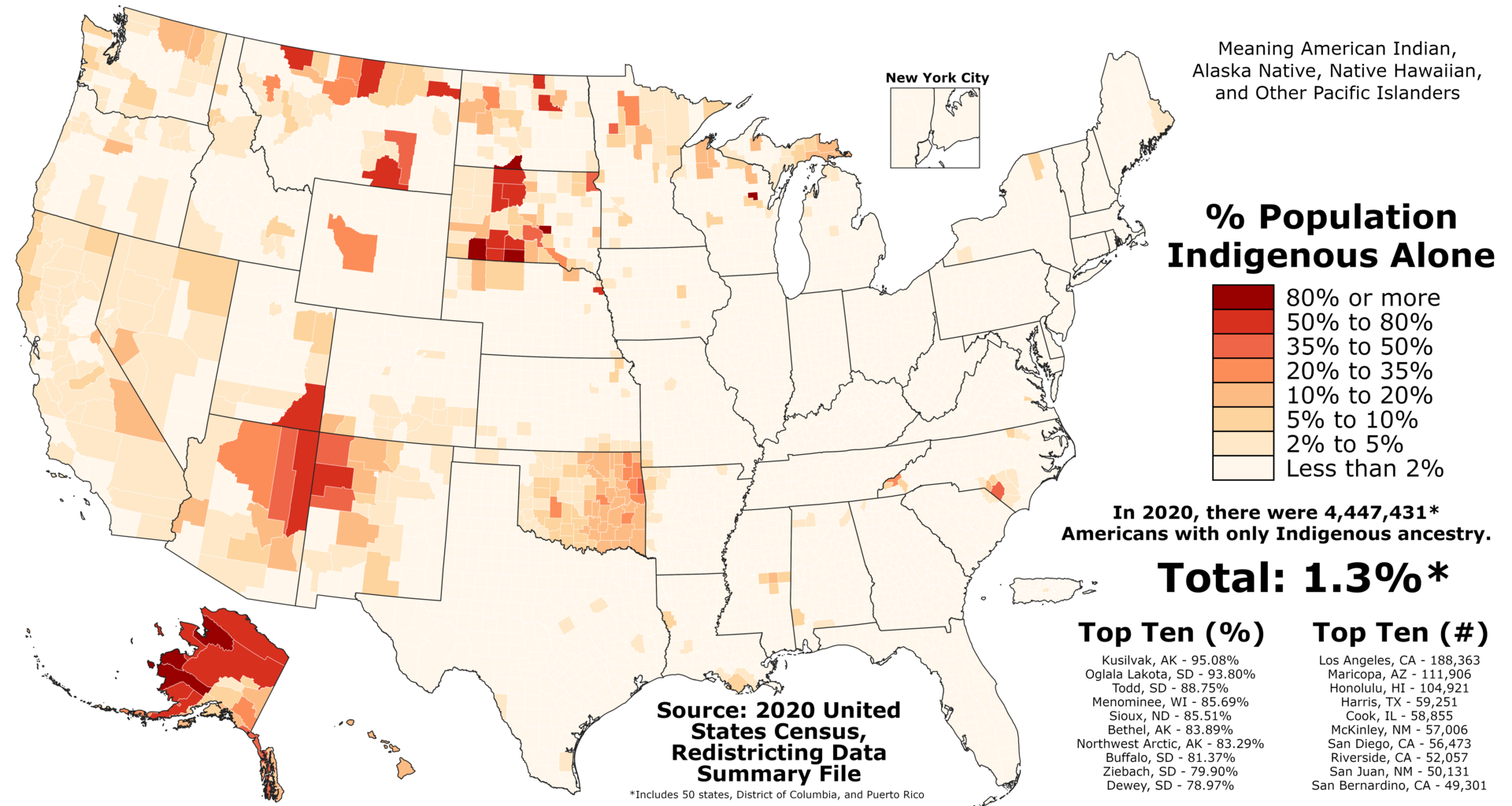 Proportion of Native Americans in each county in 2020.  A Choctaw artist in present-day Oklahoma 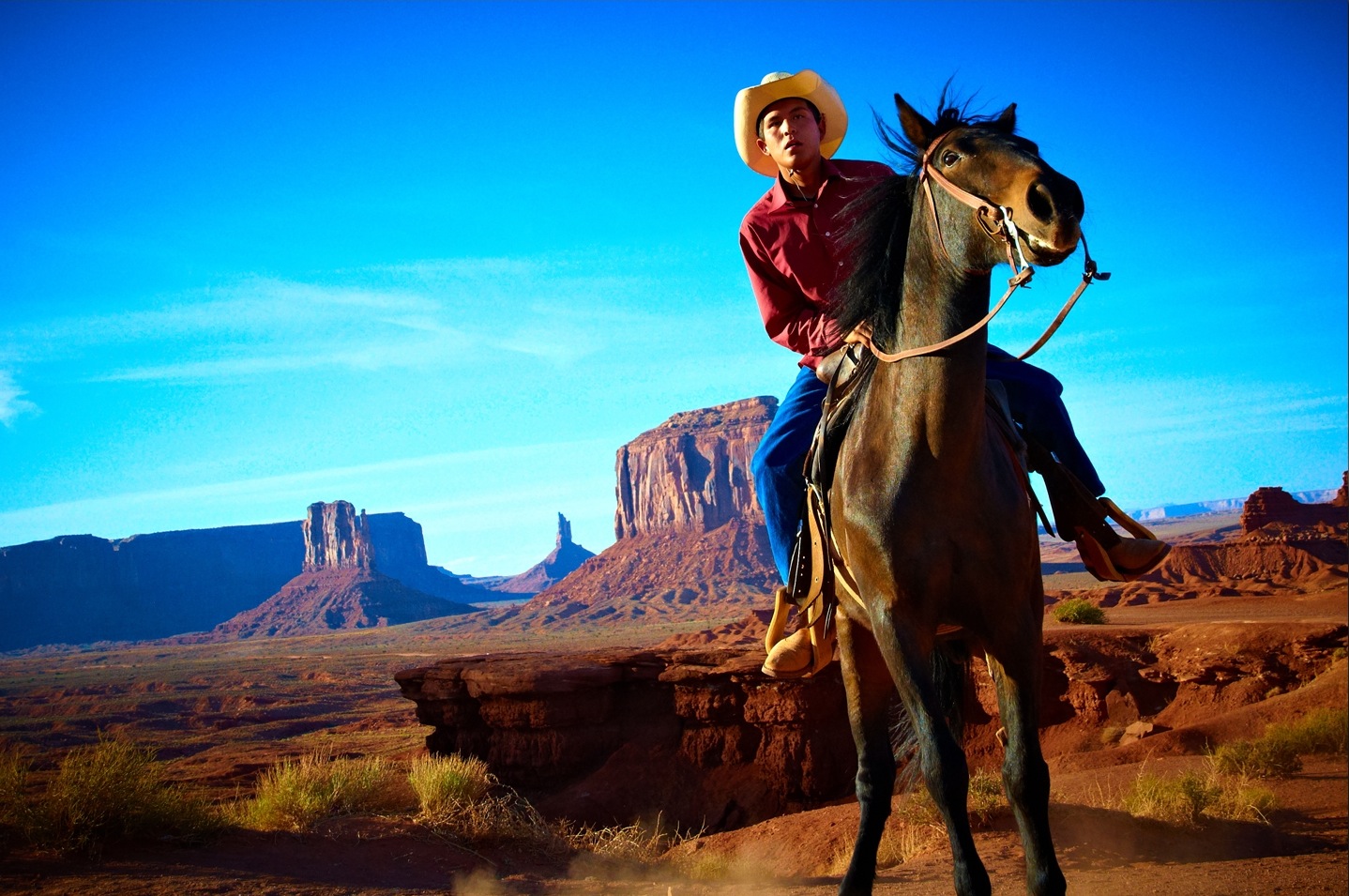 A Navajo man on horseback in present-day Monument Valley in Arizona Indigenous peoples in what is now the contiguous United States, including their descendants, were commonly called American Indians, or simply Indians domestically and since the late 20th century the term Native American came into common use. In Alaska, Indigenous peoples belong to 11 cultures with 11 languages. These include the St. Lawrence Island Yupik, Iñupiat, Athabaskan, Yup'ik, Cup'ik, Unangax, Alutiiq, Eyak, Haida, Tsimshian, and Tlingit,[232] and are collectively called Alaska Natives. They include Native American peoples as well as Inuit, who are distinct but occupy areas of the region. The United States has authority over Indigenous Polynesian people, which include Hawaiians, Marshallese (Micronesian), and Samoan; politically they are classified as Pacific Islander Americans. They are geographically, genetically, and culturally distinct from Indigenous peoples of the mainland continents of the Americas. In the 2020 census 2.9% of the U.S. population claimed to have some degree of Native American heritage. When answering a question about racial background, 3.7 million people identified solely as "American Indian or Alaska Native", while another 5.9 million did so in combination with other races.[233] Aztecs were the largest single Native American group in the 2020 census, while Cherokee was the largest group in combination with any other race.[234] Tribes have established their criteria for membership, which are often based on blood quantum, lineal descent, or residency. A minority of Native Americans live in land units called Indian reservations. Some California and Southwestern tribes, such as the Kumeyaay, Cocopa, Pascua Yaqui, Tohono O'odham, and Apache, span both sides of the US–Mexican border. By treaty, Haudenosaunee people have the legal right to freely cross the US–Canada border. Athabascan, Tlingit, Haida, Tsimshian, Iñupiat, Blackfeet, Nakota, Cree, Anishinaabe, Huron, Lenape, Mi'kmaq, Penobscot, and Haudenosaunee, among others, live in both Canada and the United States, whose international border intersects their common cultural territory. |
アメリカ合衆国 主な記事: アメリカ合衆国の先住民とアラスカ先住民  2020年時点の各郡における先住民の割合。  現在のオクラホマ州におけるチョクトー族の芸術家  現在のアリゾナ州モニュメントバレーにおける馬に乗ったナバホ族の男性 現在のアメリカ本土48州に居住する先住民とその子孫は、国内では一般的にアメリカン・インディアン、あるいは単にインディアンと呼ばれてきた。20世紀 後半以降、「ネイティブ・アメリカン」という呼称が広く使われるようになった。アラスカ州の先住民は11の文化圏に属し、11の言語を有する。これにはセ ントローレンス島ユピック、イヌピアット、アサバスカン、ユピック、クピック、ウナングアックス、アルティーク、イーヤック、ハイダ、ツィムシアン、トリ ンギットが含まれ[232]、総称してアラスカ先住民と呼ばれる。これにはアメリカ先住民に加え、別個の民族ながら同地域に居住するイヌイットも含まれ る。 アメリカ合衆国は、ハワイアン、マーシャル諸島人(ミクロネシア系)、サモア人を含むポリネシア系先住民に対する管轄権を有する。政治的には太平洋諸島系アメリカ人として分類される。彼らは地理的、遺伝的、文化的にアメリカ大陸本土の先住民とは異なる。 2020年の国勢調査では、米国人口の2.9%が何らかのネイティブアメリカンの血筋を自認した。人種的背景に関する質問に対し、370万人が単独で「ア メリカンインディアンまたはアラスカ先住民」と回答し、さらに590万人が他の人種と組み合わせて回答した。[233] 2020年国勢調査ではアステカ系が単一先住民グループとして最大規模であり、チェロキー系は他の人種と組み合わせたグループとして最大だった。 [234] 各部族は血統比率、直系血統、居住地などを基準とした部族員資格を定めている。少数派の先住民はインディアン居留地と呼ばれる土地単位で生活している。 クメヤイ族、ココパ族、パスクア・ヤキ族、トホノ・オードハム族、アパッチ族など、カリフォルニア州や南西部の部族の一部は、米墨国境の両側にまたがって いる。条約により、ハウデノソーニーの人々は米加国境を自由に越える法的権利を有している。アサバスカン族、トリンギット族、ハイダ族、ツィムシアン族、 イヌピアット族、ブラックフィート族、ナコタ族、クリー族、アニシナベ族、ヒューロン族、レナペ族、ミクマク族、ペノブスコット族、ハウデノソーニー族な どは、カナダとアメリカ合衆国の両国に居住している。両国の国境は、彼らの共通の文化的領域を横切っているのだ。 |
| Central America Belize Mestizos (mixed European-Indigenous) number about 34% of the population; unmixed Maya make up another 10.6% (Kekchi, Mopan, and Yucatec). The Garifuna, who came to Belize in the 19th century from Saint Vincent and the Grenadines, have mixed African, Carib, and Arawak ancestry and make up another 6% of the population.[235] Costa Rica Main article: Indigenous peoples of Costa Rica There are over 114,000 inhabitants of Native American origins, representing 2.4% of the population. Most of them live in secluded reservations, distributed among eight ethnic groups: Quitirrisí (In the Central Valley), Matambú or Chorotega (Guanacaste), Maleku (Northern Alajuela), Bribri (Southern Atlantic), Cabécar (Cordillera de Talamanca), Boruca (Southern Costa Rica) and Ngäbe (Southern Costa Rica along the Panamá border). These native groups are characterized by their work in wood, like masks, drums, and other artistic figures, as well as fabrics made of cotton. El Salvador Main articles: Demographics of El Salvador and La Matanza 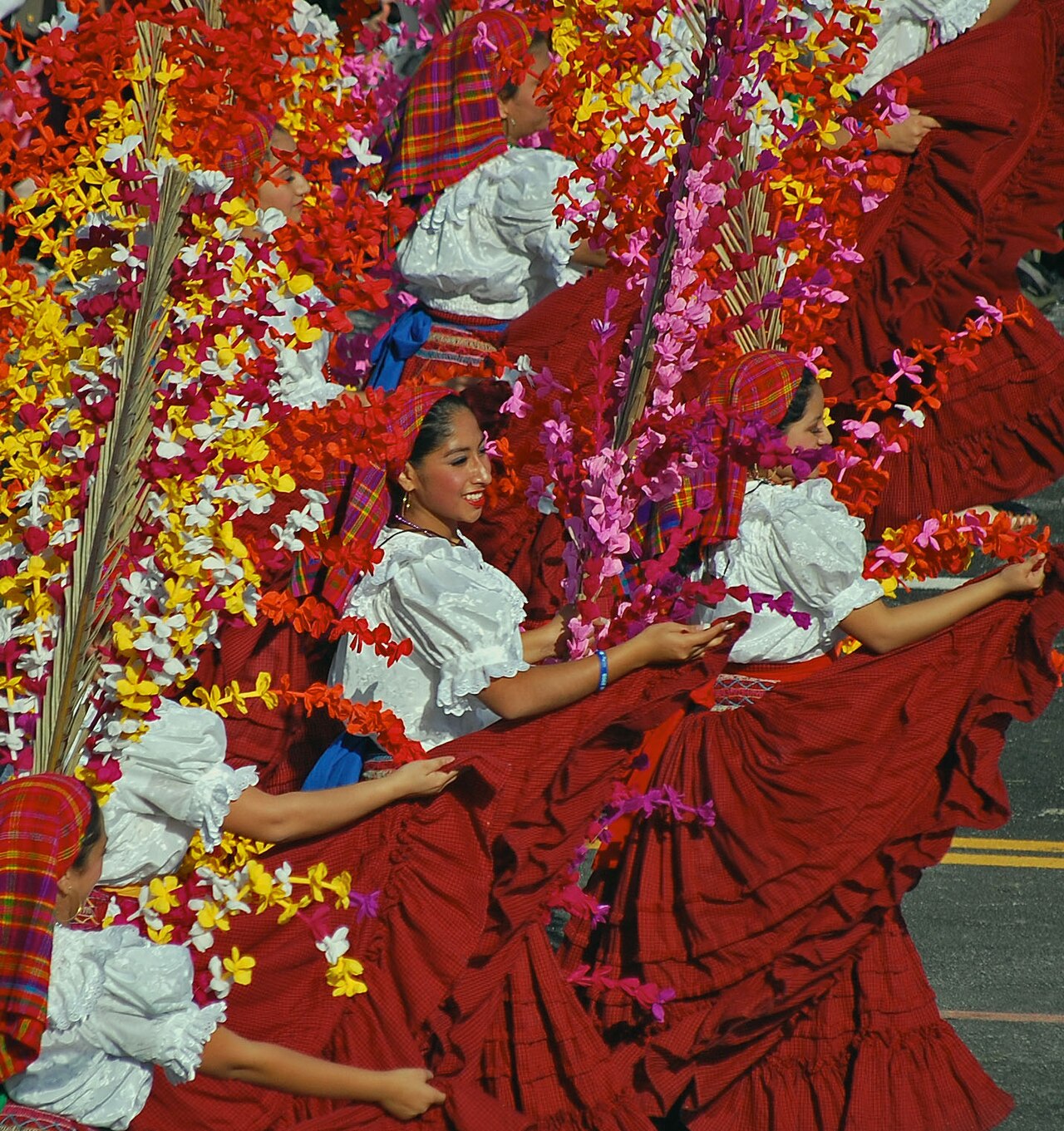 Indigenous Pipil women dancing in the traditional Procession of Palms in Panchimalco, El Salvador Estimates for El Salvador's Indigenous population vary. The 2024 census found that 1.2% of the population, or 68,148 people identified as Indigenous.[21] Historically, estimates have claimed higher amounts. A 1930 census stated that 5.6% were Indigenous.[236] By the mid-20th century, there may have been as much as 20% (or 400,000) that would qualify as "Indigenous". Another estimate stated that by the late 1980s, 10% of the population was Indigenous, and another 89% was mestizo (or people of mixed European and Indigenous ancestry).[237] Much of El Salvador was home to various Indigenous groups like the Pipil, the Lenca, Mayas (Chorti and Poqomam), Chorotegas, and Xincas. The Pipil lived in western El Salvador, spoke Nawat, and had many settlements there, most notably Cuzcatlan. The Pipil had no precious mineral resources, but they did have rich and fertile land that was good for farming. The Spaniards were disappointed not to find gold or jewels in El Salvador as they had in other lands like Guatemala or Mexico, but upon learning of the fertile land in El Salvador, they attempted to conquer it. Noted Meso-American Indigenous warriors to rise militarily against the Spanish included Princes Atonal and Atlacatl of the Pipil people in central El Salvador and Princess Antu Silan Ulap of the Lenca people in eastern El Salvador, who saw the Spanish not as gods but as barbaric invaders. After fierce battles, the Pipil successfully fought off the Spanish army led by Pedro de Alvarado along with their Indigenous allies (the Tlaxcalas), sending them back to Guatemala. After many other attacks with an army reinforced with Indigenous allies, the Spanish were able to conquer Cuzcatlan. After further attacks, the Spanish also conquered the Lenca people. Eventually, the Spaniards intermarried with Pipil and Lenca women, resulting in the mestizo population that would make up the vast majority of the Salvadoran people. Today many Pipil and other Indigenous populations live in the many small towns of El Salvador like Izalco, Panchimalco, Sacacoyo, and Nahuizalco. Guatemala Main article: Indigenous peoples in Guatemala See also: Demographics of Guatemala 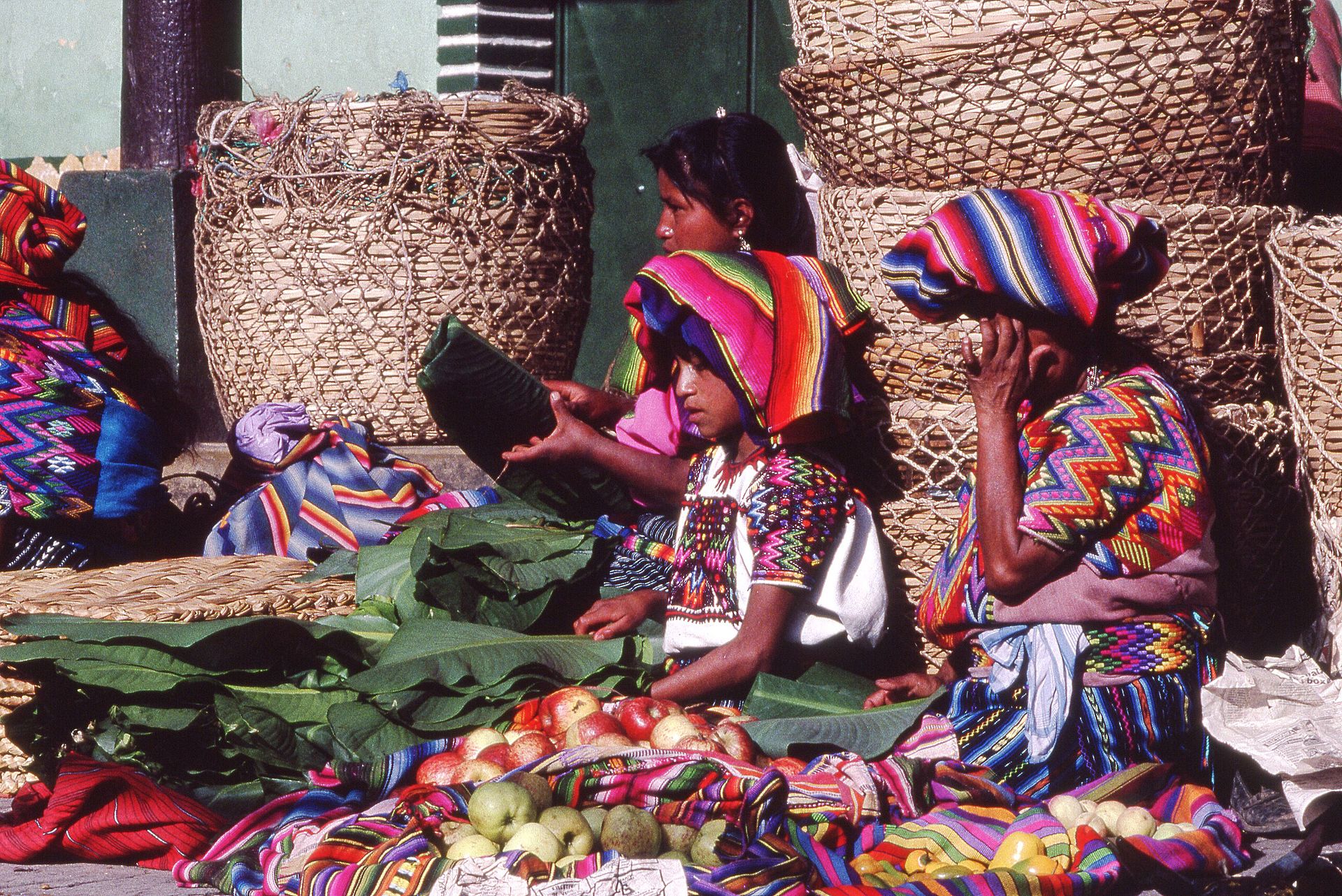 Modern Maya people in Sololá, Guatemala 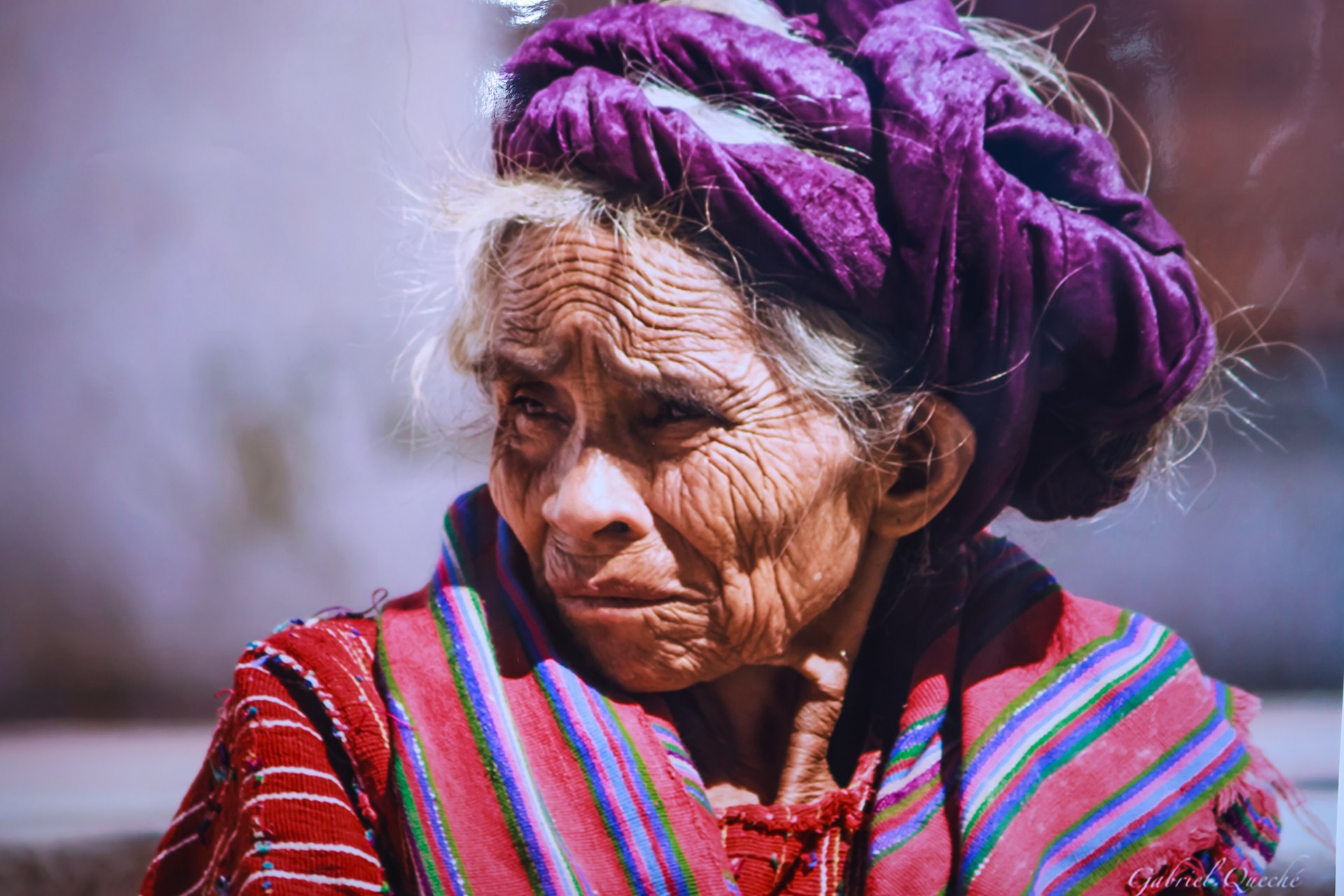 An elderly Maya woman Guatemala has one of the largest Indigenous populations in Central America, with approximately 43.6% of the population considering themselves Indigenous.[238] The Indigenous demographic portion of Guatemala's population consists of a majority of Maya groups and one non-Maya group. The Mayan language-speaking portion makes up 29.7% of the population and is distributed into 23 groups namely Q'eqchi' 8.3%, K'iche 7.8%, Mam 4.4%, Kaqchikel 3%, Q'anjob'al 1.2%, Poqomchi' 1%, and Other 4%.[238] The non-Maya group consists of the Xinca who are another set of Indigenous people making up 1.8% of the population.[238] Other sources indicate that between 50% and 60% of the population could be Indigenous because part of the Mestizo population is predominantly Indigenous. The Maya peoples cover a vast geographic area throughout Central America and expand beyond Guatemala into other countries. One could find vast groups of Maya people in Boca Costa, in the Southern portions of Guatemala, as well as the Western Highlands living together in close communities.[239] Within these communities and outside of them, around 23 Indigenous languages (or Native American Indigenous languages) are spoken as a first language. Of these 23 languages, they only received official recognition by the Government in 2003 under the Law of National Languages.[238] The Law on National Languages recognizes 23 Indigenous languages including Xinca, enforcing that public and government institutions not only translate but also provide services in said languages.[240] It would provide services in Cakchiquel, Garifuna, Kekchi, Mam, Quiche, and Xinca.[241] The Law of National Languages has been an effort to grant and protect Indigenous peoples' rights not afforded to them previously. Along with the Law of National Languages passed in 2003, in 1996 the Guatemalan Constitutional Court had ratified the ILO Convention 169 on Indigenous and Tribal Peoples.[242] The ILO Convention 169 on Indigenous and Tribal Peoples, is also known as Convention 169. Which is the only International Law regarding Indigenous peoples that Independent countries can adopt. The convention establishes that governments like Guatemala must consult with Indigenous groups before any projects occur on tribal lands.[243] Honduras Main article: Indigenous peoples of Honduras About 5 percent of the population is of full-blooded Indigenous descent, but as much as 80 percent of Hondurans are mestizo or part-Indigenous with European admixture, and about 10 percent are of Indigenous or African descent.[244] The largest concentrations of Indigenous communities in Honduras are in the westernmost areas facing Guatemala and along the coast of the Caribbean Sea, as well as on the border with Nicaragua.[244] The majority of Indigenous people are Lencas, Miskitos to the east, Mayas, Pech, Sumos, and Tolupan.[244] Nicaragua About 5 percent of the Nicaraguan population is Indigenous. The largest Indigenous group in Nicaragua is the Miskito people. Their territory extended from Cabo Camarón, Honduras, to La Cruz de Rio Grande, Nicaragua along the Mosquito Coast. There is a native Miskito language, but large numbers speak Miskito Coast Creole, Spanish, Rama, and other languages. Their use of Creole English came about through frequent contact with the British, who colonized the area. Many Miskitos are Christians. Traditional Miskito society was highly structured, politically and otherwise. It had a king, but he did not have total power. Instead, the power was split between himself, a Miskito Governor, a Miskito General, and by the 1750s, a Miskito Admiral. Historical information on Miskito kings is often obscured by the fact that many of the kings were semi-mythical. Another major Indigenous culture in eastern Nicaragua is the Mayangna (or Sumu) people, counting some 10,000 people.[245] A smaller Indigenous culture in southeastern Nicaragua is the Rama. Other Indigenous groups in Nicaragua are located in the central, northern, and Pacific areas and they are self-identified as follows: Chorotega, Cacaopera (or Matagalpa), Xiu-Subtiaba, and Nicarao.[246] Panama See also: Indigenous peoples of Panama  Embera girl in the Darién Province, 2006. Indigenous peoples of Panama, or Native Panamanians, are the Native peoples of Panama. As of the 2023 census, Indigenous peoples constitute 17.2% of Panama's population of 4.5 million, totaling just over 698,000 individuals. The Ngäbe and Buglé comprise half of the Indigenous peoples of Panama.[247] Many of the Indigenous Peoples live on comarca indígenas,[248] which are administrative regions for areas with substantial Indigenous populations. Three comarcas (Comarca Emberá-Wounaan, Guna Yala, Ngäbe-Buglé) exist as equivalent to a province, with two smaller comarcas (Guna de Madugandí and Guna de Wargandí) subordinate to a province and considered equivalent to a corregimiento (municipality). |
中央アメリカ ベリーズ メスティソ(ヨーロッパ系と先住民の混血の)は人口の約34%を占める。純血のマヤ系はさらに10.6%を占める(ケクチ族、モパン族、ユカテク族)。 19世紀にセントビンセント・グレナディーン諸島からベリーズに移住したガリフナ族は、アフリカ系、カリブ系、アラワク系の混血の ancestry を有し、人口の6%を占める[235]。 コスタリカ 主な記事:コスタリカの先住民 先住民系の住民は11万4千人以上おり、人口の2.4%を占める。彼らの大半は隔離された保留地に住み、8つの民族グループに分かれている:キティリシ (中央谷地)、マタンブまたはチョロテガ(グアナカステ)、マレク(アラフエラ北部)、 ブリブリ族(南大西洋岸)、カベカル族(タランカ山脈)、ボルカ族(コスタリカ南部)、ンガベ族(パナマ国境沿いのコスタリカ南部)である。 これらの先住民グループは、仮面や太鼓、その他の芸術的な造形物といった木工品や、綿で作られた織物で知られる。 エルサルバドル 主な記事:エルサルバドルの人口統計とラ・マタンサ  エルサルバドル、パンチマルコにおける伝統的な棕櫚の行進で踊る先住民ピピル族の女性たち エルサルバドルの先住民人口に関する推定値は様々である。2024年の国勢調査では、人口の1.2%にあたる68,148人が先住民と自認していた [21]。歴史的に見ると、より高い数値が主張されてきた。1930年の国勢調査では5.6%が先住民とされた[236]。20世紀半ばには、最大20% (40万人)が「先住民」に該当する可能性があった。別の推定では、1980年代後半には人口の10%が先住民であり、さらに89%がメスティーソ(ヨー ロッパ系と先住民の混血の)であったとされる。[237] エルサルバドルの大部分は、ピピル族、レンカ族、マヤ族(チョルティ族とポコマム族)、チョロテガ族、シンカ族など様々な先住民集団の居住地であった。ピ ピル族はエルサルバドル西部に居住し、ナワト語を話し、クスカトランをはじめとする多くの集落を有していた。ピピル族は貴金属資源を持たなかったが、農業 に適した肥沃な土地を豊富に有していた。スペイン人はグアテマラやメキシコのような他の土地で見つけた金や宝石をエルサルバドルで見つけられず失望した が、その肥沃な土地を知ると征服を試みた。スペイン軍に対して軍事的に立ち上がった著名なメソアメリカ先住民の戦士には、エルサルバドル中部のピピル人民 の王子アトナルとアトラカトル、東部レンカ人民の王女アントゥ・シラン・ウラップがいた。彼らはスペイン人を神ではなく野蛮な侵略者と見なした。激しい戦 闘の末、ピピル族はペドロ・デ・アルバラード率いるスペイン軍とその先住民同盟者(トラスカラ族)を撃退し、グアテマラへ追い返した。その後、スペイン軍 は先住民同盟者を増強した軍隊で何度も攻撃を仕掛け、クスカトランを征服した。さらに攻撃を重ね、レンカ族も征服した。やがてスペイン人はピピル族やレン カ族の女性と結婚し、メスティソ(混血)人口が生まれた。このメスティソがエルサルバドルの人民の大多数を占めるようになった。今日、多くのピピル族や他 の先住民は、イサルコ、パンチマルコ、サカコヨ、ナウイサルコといったエルサルバドルの多くの小さな町に住んでいる。 グアテマラ 主な記事:グアテマラの先住民 関連項目:グアテマラの人口統計  グアテマラ、ソロラ県の現代マヤ人  マヤ族の高齢女性 グアテマラは中央アメリカで最大級の先住民人口を抱え、国民の約43.6%が自らを先住民と認識している[238]。グアテマラの先住民人口構成は、マヤ 系集団が多数派を占め、非マヤ系集団が1つ存在する。マヤ語を話す人口は全体の29.7%を占め、23のグループに分かれる。具体的にはケクチ族 8.3%、キチェ族7.8%、マム族4.4%、カクチケル族3%、カンホバル族1.2%、ポコムチ族1%、その他4%である。[238] 非マヤ系集団はシンカ族であり、彼らは別の先住民で人口の1.8%を占める。[238] 他の情報源によれば、メスティソ人口の一部が主に先住民であるため、人口の50%から60%が先住民である可能性がある。 マヤ民族は中央アメリカ全域に広がる広大な地理的領域をカバーし、グアテマラを越えて他国にも拡大している。グアテマラ南部のボカ・コスタや西部高地に は、緊密な共同体を形成して暮らす大規模なマヤ人民が存在する。[239] これらの共同体内外では、約23の先住民言語(またはネイティブアメリカン先住民言語)が第一言語として話されている。この23言語のうち、政府による公 式認定を受けたのは2003年の「国家言語法」施行以降である。[238] 国民言語法はシンカ語を含む23の先住民言語を認定し、公共機関や政府機関がこれらの言語で翻訳だけでなくサービスを提供することを義務付けている。 [240] カクチケル語、ガリフナ語、ケクチ語、マム語、キチェ語、シンカ語でのサービス提供が規定されている。[241] 国家言語法は、先住民がこれまで享受できなかった権利を付与し保護する取り組みである。2003年に制定された国家言語法に加え、1996年にはグアテマ ラ憲法裁判所がILO第169号条約(先住民族及び部族民に関する条約)を批准した。[242] ILO第169号条約(先住民族及び部族民に関する条約)は、条約169としても知られる。これは独立国が採用可能な唯一の先住民に関する国際法である。 同条約は、グアテマラのような政府が部族の土地で事業を行う前に先住民族グループと協議することを定めている。[243] ホンジュラス 主な記事:ホンジュラスの先住民 人口の約5%が純血の先住民である。しかしホンジュラス人の最大80%はメスティソ(ヨーロッパ系との混血)もしくは先住民とヨーロッパ系の混血であり、 約10%が先住民またはアフリカ系である。[244] ホンジュラスにおける先住民コミュニティの最大の集住地域は、グアテマラと国境を接する最西端地域、カリブ海沿岸地域、およびニカラグアとの国境地域であ る。[244] 先住民の大半はレンカ族、東部にはミスキート族、マヤ族、ペチ族、スモ族、トルパン族がいる。[244] ニカラグア ニカラグア人口の約5%が先住民である。最大の先住民集団はミスキート族だ。彼らの領域はホンジュラスのカボ・カマロンからニカラグアのラ・クルス・デ・ リオ・グランデまで、モスキート海岸沿いに広がっていた。ミスキート語という固有の言語は存在するが、多くの者がミスキート・コースト・クレオール語、ス ペイン語、ラマ語その他の言語を話す。クレオール英語の使用は、この地域を植民地化したイギリス人との頻繁な接触によって生まれた。多くのミスキートはキ リスト教徒である。伝統的なミスキート社会は政治的にもその他の面でも高度に構造化されていた。王は存在したが、絶対的な権力を持っていなかった。代わり に権力は、王自身、ミスキート総督、ミスキート将軍、そして1750年代にはミスキート提督の間で分担されていた。ミスキート王に関する歴史情報は、多く の王が半神話的な存在であったため、しばしば不明瞭である。 ニカラグア東部におけるもう一つの主要な先住民文化は、約1万人を数えるマヤンナ(またはスム)人民である。[245] ニカラグア南東部の小規模な先住民文化はラマ族である。 ニカラグアの中部、北部、太平洋沿岸地域には他の先住民集団が居住しており、彼らは自らを以下のように識別している:チョロテガ族、カカオペラ族(またはマタガルパ族)、シウ・スブティアバ族、ニカラオ族。[246] パナマ 関連項目:パナマの先住民  2006年、ダリエン州のエンベラ族の少女。 パナマの先住民、すなわち先住パナマ人は、パナマの先住民である。2023年の国勢調査によると、先住民はパナマの人口450万人の17.2%を占め、総数は69万8千人をわずかに超える。ンガベ族とブグレ族はパナマの先住民の半数を占める。[247] 多くの先住民は、先住民地域(comarca indígenas)[248]に居住している。これは先住民が多数居住する地域の行政区分である。3つのコミャルカ(エンベラ・ウナアン、グナ・ヤラ、 ンガベ・ブグレ)は州に相当する存在であり、2つの小規模コミャルカ(グナ・デ・マドゥガンディ、グナ・デ・ワルガンディ)は州に属し、コレヒミエント (自治体)に相当すると見なされている。 |
| South America Main article: Indigenous peoples of South America Argentina See also: Indigenous peoples in Argentina and List of Indigenous languages in Argentina  Proportion of Native Argentines in each department in 2022.  Owners of a roadside cafe near Cachi, Salta Province, Argentina In 2005, the Indigenous population living in Argentina (known as pueblos originarios) numbered about 600,329 (1.6% of the total population); this figure includes 457,363 people who self-identified as belonging to an Indigenous ethnic group and 142,966 who identified themselves as first-generation descendants of an Indigenous people.[249] The ten most populous Indigenous peoples are the Mapuche (113,680 people), the Kolla (70,505), the Toba (69,452), the Guaraní (68,454), the Wichi (40,036), the Diaguita–Calchaquí (31,753), the Mocoví (15,837), the Huarpe (14,633), the Comechingón (10,863) and the Tehuelche (10,590). Minor but important peoples are the Quechua (6,739), the Charrúa (4,511), the Pilagá (4,465), the Chané (4,376), and the Chorote (2,613). The Selkʼnam (Ona) people are now virtually extinct in its pure form. The languages of the Diaguita, Tehuelche, and Selkʼnam nations have become extinct or virtually extinct: the Cacán language (spoken by Diaguitas) in the 18th century and the Selkʼnam language in the 20th century; one Tehuelche language (Southern Tehuelche) is still spoken by a handful of elderly people. Bolivia This article's factual accuracy may be compromised due to out-of-date information. Please help update this article to reflect recent events or newly available information. (April 2012) Main article: Indigenous peoples in Bolivia 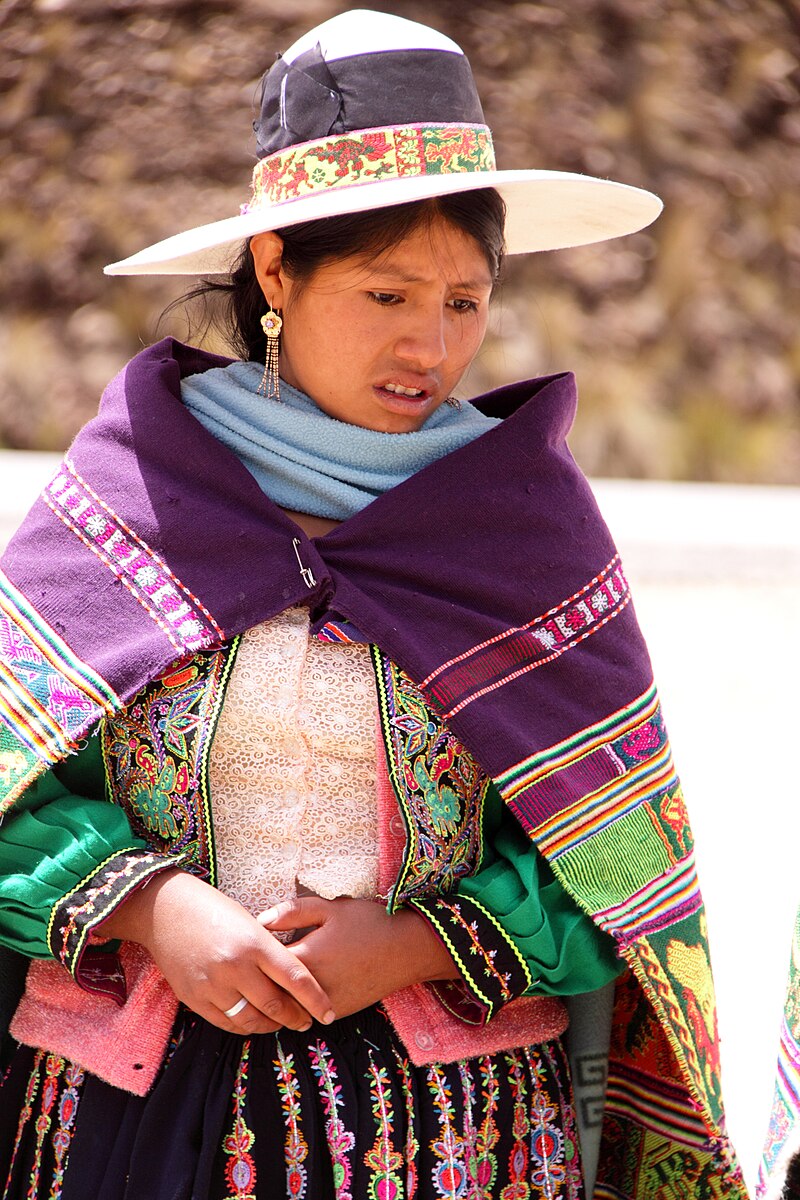 An Indigenous woman in traditional dress near Cochabamba, Bolivia In Bolivia, the 2012 National Census reported that 41% of residents over the age of 15 are of Indigenous origin. Some 3.7% report growing up with an Indigenous mother tongue but do not identify as Indigenous.[250] When both of these categories are totaled, and children under 15, some 66.4% of Bolivia's population was recorded as Indigenous in the 2001 Census.[251] The 2021 National Census, recognizes 38 cultures, each with its language, as part of a pluri-national state. Some groups, including CONAMAQ (the National Council of Ayllus and Markas of Qullasuyu), draw ethnic boundaries within the Quechua- and Aymara-speaking population, resulting in a total of 50 Indigenous peoples native to Bolivia. The largest Indigenous ethnic groups are Quechua, about 2.5 million people; Aymara, 2 million; Chiquitano, 181,000; Guaraní, 126,000; and Mojeño, 69,000. Some 124,000 belong to smaller Indigenous groups.[252] The Constitution of Bolivia, enacted in 2009, recognizes 36 cultures, each with its language, as part of a pluri-national state. Some groups, including CONAMAQ (the National Council of Ayllus and Markas of Qullasuyu), draw ethnic boundaries within the Quechua- and Aymara-speaking population, resulting in a total of 50 Indigenous peoples native to Bolivia. Large numbers of Bolivian highland peasants retained Indigenous language, culture, customs, and communal organization throughout the Spanish conquest and the post-independence period. They mobilized to resist various attempts at the dissolution of communal landholdings and used legal recognition of "empowered caciques" to further communal organization. Indigenous revolts took place frequently until 1953.[253] While the National Revolutionary Movement government began in 1952 and discouraged people identifying as Indigenous (reclassifying rural people as campesinos, or peasants), renewed ethnic and class militancy re-emerged in the Katarista movement beginning in the 1970s.[254] Many lowland Indigenous peoples, mostly in the east, entered national politics through the 1990 March for Territory and Dignity organized by the CIDOB confederation. That march successfully pressured the national government to sign the ILO Convention 169 and to begin the still-ongoing process of recognizing and giving official titles to Indigenous territories. The 1994 Law of Popular Participation granted "grassroots territorial organizations;" these are recognized by the state and have certain rights to govern local areas. Some radio and television programs are produced in the Quechua and Aymara languages. The constitutional reform in 1997 recognized Bolivia as a multi-lingual, pluri-ethnic society and introduced education reform. In 2005, for the first time in the country's history, an Indigenous Aymara, Evo Morales, was elected as president. Morales began work on his "Indigenous autonomy" policy, which he launched in the eastern lowlands department on 3 August 2009. Bolivia was the first nation in the history of South America to affirm the right of Indigenous people to self-government.[255] Speaking in Santa Cruz Department, the President called it "a historic day for the peasant and Indigenous movement", saying that, though he might make errors, he would "never betray the fight started by our ancestors and the fight of the Bolivian people".[255] A vote on further autonomy for jurisdictions took place in December 2009, at the same time as general elections to office. The issue divided the country.[256] At that time, Indigenous peoples voted overwhelmingly for more autonomy: five departments that had not already done so voted for it;[257][258] as did Gran Chaco Province in Taríja, for regional autonomy;[259] and 11 of 12 municipalities that had referendums on this issue.[257] |
南アメリカ 主な記事: 南アメリカの先住民 アルゼンチン 関連項目: アルゼンチンの先住民およびアルゼンチンの先住民言語一覧  2022年時点の各県における先住民比率。  アルゼンチン、サルタ州カチ近郊の道端カフェの経営者 2005年時点で、アルゼンチンに居住する先住民(プエブロス・オリヒナリオとして知られる)の人口は約600,329人(総人口の1.6%)であった。 この数字には、自らを先住民民族に属すると認識した457,363人と、先住民の第一世代の子孫であると認識した142,966人が含まれている。 [249] 人口上位10の先住民は、マプチェ族(113,680人)、コジャ族(70,505人)、トバ族(69,452人)、グアラニー族(68,454人)、 ウィチ族(40,036人)、 ディアグイタ・カルチャキ族(31,753人)、モコビ族(15,837人)、ワルペ族(14,633人)、コメチンゴン族(10,863人)、テウェル チェ族(10,590人)である。少数ながら重要な人民として、ケチュア人民(6,739人)、チャルア人民(4,511人)、ピラガ人民(4,465 人)、チャネ人民(4,376人)、チョロテ人民(2,613人)がいる。セルクナム人民(オナ族)は純粋な形態ではほぼ絶滅した。ディアグイタ族、テ ウェルチェ族、セルクナム族の言語は絶滅したか、ほぼ絶滅状態にある。カカン語(ディアグイタ族が使用)は18世紀に、セルクナム語は20世紀に消滅し た。テウェルチェ語の一方(南部テウェルチェ語)は、ごく少数の高齢の人民が今も使用している。 ボリビア この記事の事実関係は、情報が古くなっているため正確性を欠いている可能性がある。最近の出来事や新たに得られた情報を反映させるため、この記事の更新にご協力ください(2012年4月)。 主な記事:ボリビアの先住民  ボリビア、コチャバンバ近郊で伝統衣装をまとった先住民の女性 ボリビアでは、2012年の国勢調査により、15歳以上の住民の41%が先住民の血筋を持つと報告された。約3.7%は先住民の母語で育ったと報告してい るが、自らを先住民とは認識していない[250]。これらのカテゴリーを合計し、15歳未満の子供を含めると、2001年の国勢調査ではボリビア人口の約 66.4%が先住民として記録された。[251] 2021年の国勢調査では、多民族国家の一部として、それぞれ独自の言語を持つ38の文化が認められている。クッラスユのアイユス・マルカス全国評議会 (CONAMAQ)を含む一部の団体は、ケチュア語とアイマラ語を話す人口の中に民族的な境界線を引いており、その結果、ボリビアに固有の先住民は合計 50民族となっている。 最大の先住民民族集団はケチュア族(約250万人)、アイマラ族(200万人)、チキタノ族(18万1千人)、グアラニー族(12万6千人)、モヘニョ族 (6万9千人)である。その他12万4千人が小規模先住民集団に属する。[252] 2009年に制定されたボリビア憲法は、多民族国家の一部として、それぞれ独自の言語を持つ36の文化を認めている。クッラスユのアイリュとマルカ全国評 議会(CONAMAQ)を含む一部の団体は、ケチュア語とアイマラ語を話す人口の中に民族的な境界線を引いており、その結果、ボリビアに固有の先住民は合 計50に上る。 スペインによる征服期から独立後にかけて、ボリビア高地の農民の大多数は先住民の言語・文化・慣習・共同組織を維持した。彼らは共同所有地の解体を図る様 々な試みに抵抗し、「権限付与された首長」の法的承認を利用して共同組織を強化した。先住民の反乱は1953年まで頻繁に発生した[253]。1952年 に始まった国民革命運動政権は先住民としての自認を抑制し(農村住民をカンペシーノ=農民と再分類)、民族的・階級的闘争意識は1970年代のカタリスタ 運動で再燃した。東部を中心とした低地の先住民の多くは、先住民組織連合(CIDOB)が主催した1990年の「領土と尊厳のための行進」を通じて国家政 治に参加した。この行進は政府に圧力をかけ、ILO第169号条約の批准と、現在も継続中の先住民領土の認定・正式な権利付与プロセスを開始させることに 成功した。1994年の「人民参加法」は「草の根の地域組織」を認めた。これらは国家によって承認され、地域を統治する一定の権利を有する。 一部のラジオ・テレビ番組はケチュア語とアイマラ語で制作されている。1997年の憲法改正はボリビアを多言語・多民族社会と認め、教育改革を導入した。2005年、同国史上初めて先住民アイマラ族のエボ・モラレスが大統領に選出された。 モラレスは「先住民自治」政策に着手し、2009年8月3日に東部低地州でこれを発足させた。ボリビアは南米史上初めて、先住民の自治権を認めた国民と なった。[255] サンタクルス県で演説した大統領はこれを「農民・先住民運動にとって歴史的な日」と呼び、過ちを犯すことはあっても「先祖たちが始めた闘い、そしてボリビ アの人民の闘いを決して裏切らない」と述べた。[255] 2009年12月、地方自治体のさらなる自治権に関する投票が総選挙と同時に実施された。この問題は国を二分した。[256] 当時、先住民は圧倒的多数で自治拡大を支持した。未実施の5県が賛成票を投じ[257][258]、タリハ県のグラン・チャコ州も地域自治を支持[259]、この問題で住民投票を実施した12自治体中11が賛成した[257]。 |
| Brazil See also: Indigenous peoples in Brazil 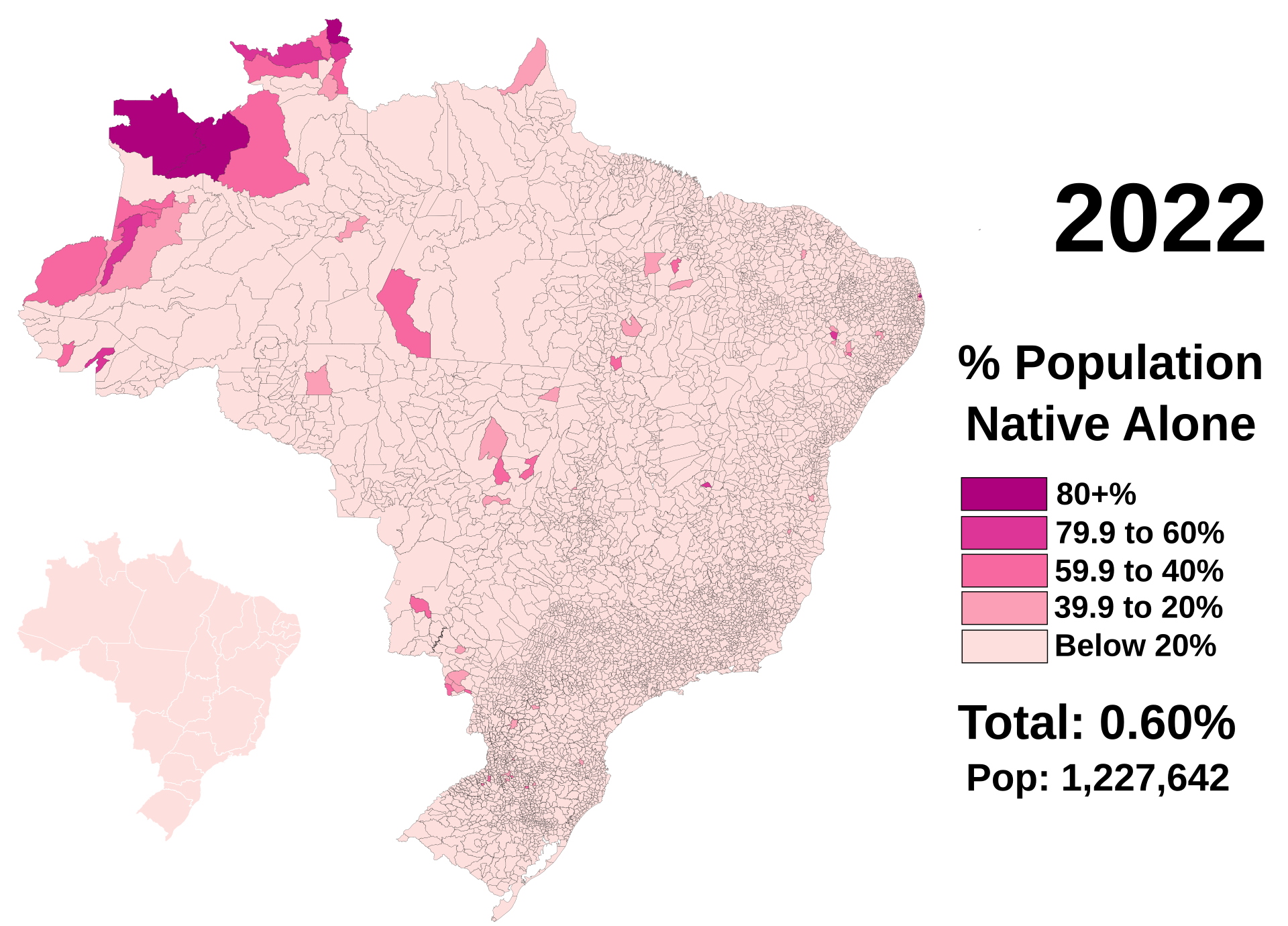 Proportion of Native Brazilians in each department in 2022. 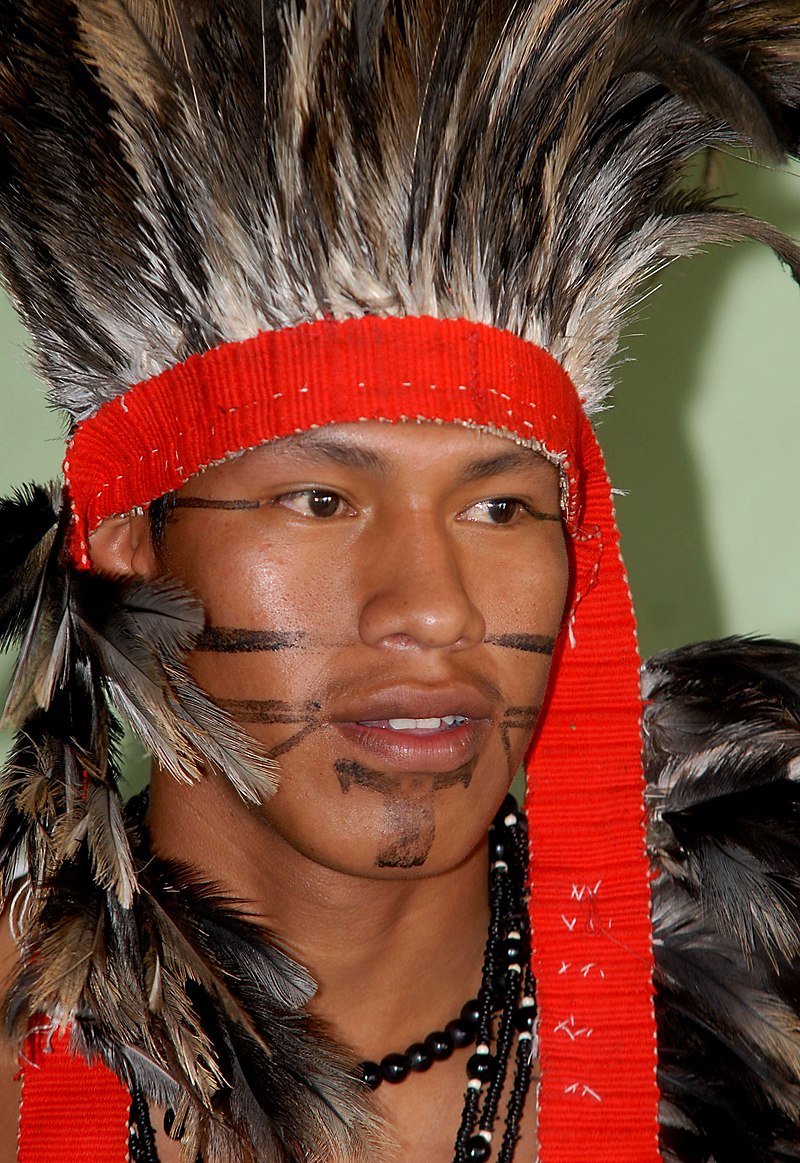 An Indigenous Terena man from present-day Brazil Indigenous peoples of Brazil make up 0.4% of Brazil's population, or about 817,000 people, but millions of Brazilians are mestizo or have some Indigenous ancestry.[260] Indigenous peoples are found in the entire territory of Brazil, although in the 21st century, the majority of them live in Indigenous territories in the North and Center-Western parts of the country. On 18 January 2007, Fundação Nacional do Índio (FUNAI) reported that it had confirmed the presence of 67 different uncontacted tribes in Brazil, up from 40 in 2005. Brazil is now the nation that has the largest number of uncontacted tribes, and the island of New Guinea is second.[260] The Washington Post reported in 2007, "As has been proved in the past when uncontacted tribes are introduced to other populations and the microbes they carry, maladies as simple as the common cold can be deadly. In the 1970s, 185 members of the Panara tribe died within two years of discovery after contracting such diseases as flu and chickenpox, leaving only 69 survivors."[261] Chile Main article: Indigenous peoples in Chile 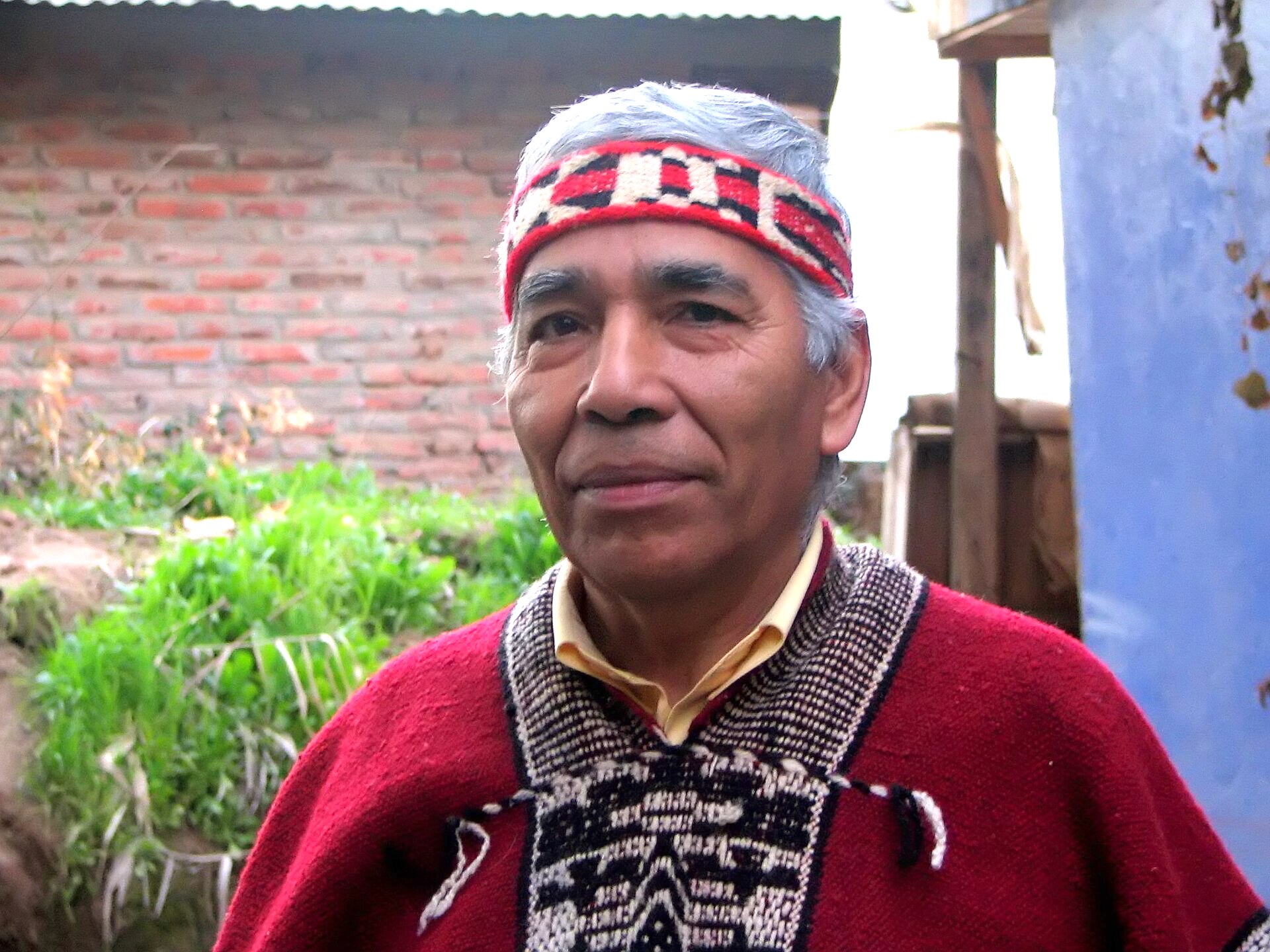 A Mapuche man in present-day Chile  A Mapuche man and woman; the Mapuche make up about 85% of Indigenous population that live in Chile. According to the 2012 Census, 10% of the Chilean population, including the Rapa Nui (a Polynesian people) of Easter Island, was Indigenous, although most show varying degrees of mixed heritage.[262] Many are descendants of the Mapuche and live in Santiago, Araucanía, and Los Lagos Region. The Mapuche successfully fought off defeat in the first 300–350 years of Spanish rule during the Arauco War. Relations with the new Chilean Republic were good until the Chilean state decided to occupy their lands. During the Occupation of Araucanía, the Mapuche surrendered to the country's army in the 1880s. Their land was opened to settlement by Chileans and Europeans. Conflict over Mapuche land rights continues to the present. Other groups include the Aymara, the majority of whom live in Bolivia and Peru, with smaller numbers in the Arica-Parinacota and Tarapacá regions, and the Atacama people (Atacameños), who reside mainly in El Loa. Colombia Main article: Indigenous peoples in Colombia  Guambía people relaxing in Colombia A minority today within Colombia's mostly mestizo and White Colombian population, Indigenous peoples living in Colombia, consist of around 85 distinct cultures and around 1,905,617 people, however, it is likely much higher.[263][264] A variety of collective rights for Indigenous peoples are recognized in the 1991 Constitution. One of the influences is the Muisca culture, a subset of the larger Chibcha ethnic group, famous for their use of gold, which led to the legend of El Dorado. At the time of the Spanish conquest, the Muisca were the largest Indigenous civilization geographically between the Inca and the Aztec empires. Ecuador Main article: Indigenous peoples in Ecuador 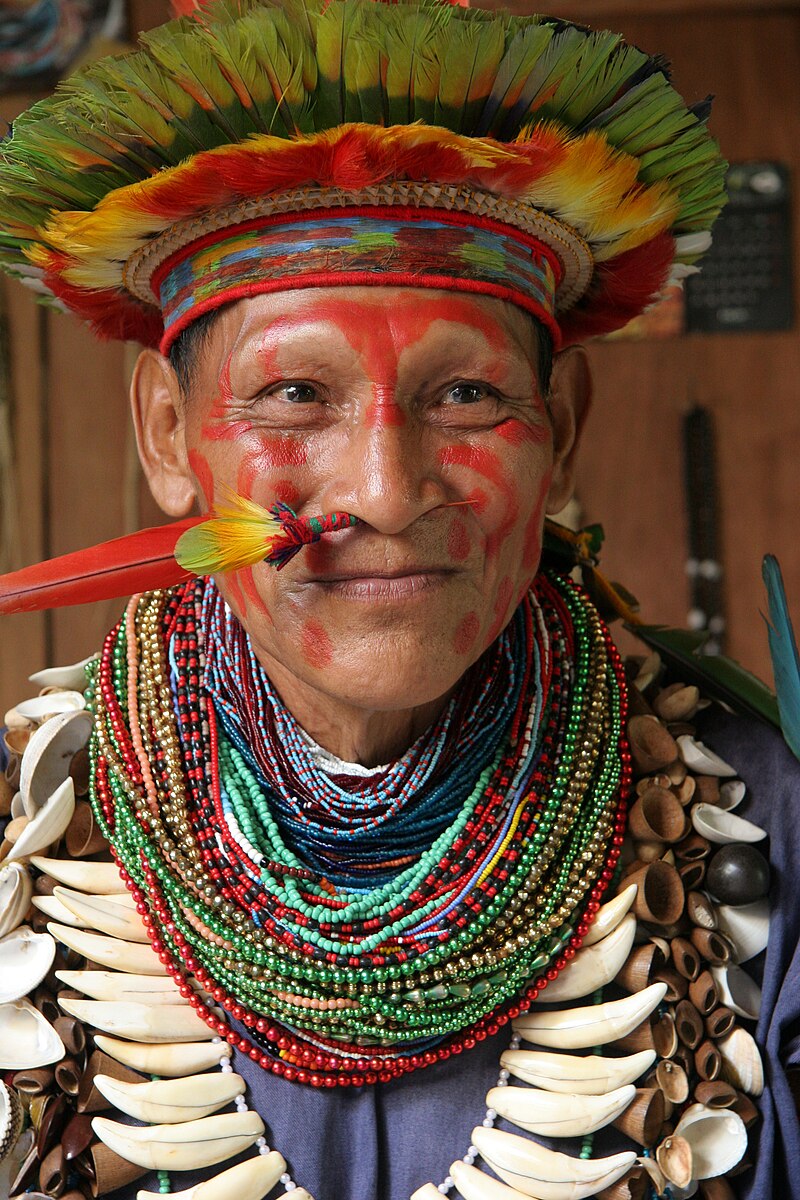 Shaman of the Cofán people from the Amazonian forest in present-day Ecuador Ecuador was the site of many Indigenous cultures and civilizations of different proportions. An early sedentary culture, known as the Valdivia culture, developed in the coastal region, while the Caras and the Quitus unified to form an elaborate civilization that ended at the birth of the Capital Quito. The Cañaris near Cuenca were the most advanced, and most feared by the Inca, due to their fierce resistance to the Incan expansion. Their architectural remains were later destroyed by the Spaniards and the Incas. Between 55% and 65% of Ecuador's population consists of Mestizos of mixed Indigenous and European ancestry, while Indigenous people comprise about 25%.[265] Genetic analysis indicates that Ecuadorian Mestizos are of predominantly Indigenous ancestry.[266] Approximately 96.4% of Ecuador's Indigenous population are Highland Quichuas living in the valleys of the Sierra region. Primarily consisting of the descendants of peoples conquered by the Incas, they are Kichwa speakers and include the Caranqui, the Otavalos, the Cayambe, the Quitu-Caras, the Panzaleo, the Chimbuelo, the Salasacan, the Tugua, the Puruhá, the Cañari, and the Saraguro. Linguistic evidence suggests that the Salascan and the Saraguro may have been the descendants of Bolivian ethnic groups transplanted to Ecuador as mitimaes. Coastal groups, including the Awá, Chachi, and the Tsáchila, make up 0.24% percent of the Indigenous population, while the remaining 3.35 percent live in the Oriente and consist of the Oriente Kichwa (the Canelo and the Quijos), the Shuar, the Huaorani, the Siona-Secoya, the Cofán, and the Achuar. In 1986, Indigenous peoples in Ecuador formed the first "truly" national political organization. The Confederation of Indigenous Nationalities of Ecuador (CONAIE) has been the primary political institution of Indigenous peoples since then and is now the second-largest political party in the nation. It has been influential in national politics, contributing to the ouster of presidents Abdalá Bucaram in 1997 and Jamil Mahuad in 2000. French Guiana French Guiana is home to approximately 10,000 Indigenous peoples, such as the Kalina and Lokono. Over time, the Indigenous population has protested against various environmental issues, such as illegal gold mining, pollution, and a drastic decrease in wild game. Guyana Main article: Indigenous peoples in Guyana During the early stages of colonization, the Indigenous peoples in Guyana partook in trade relations with Dutch settlers and assisted in militia services such as hunting down escaped slaves for the British, which continued until the 19th century. Indigenous Guyanese people are responsible for the invention of the Guyanese pepperpot and the foundation of the Alleluia church. Guyana's Indigenous peoples have been recognized under the Constitution of 1965 and comprise 9.16% of the overall population. Paraguay Main article: Indigenous peoples in Paraguay The vast majority of Indigenous peoples in Paraguay are concentrated in the Gran Chaco region in the northwest of the country, with the Guaraní making up the majority of the Indigenous population in Paraguay. The Guaraní language is recognized as an official language alongside Spanish, with approximately 90% of the population speaking Guaraní. The Indigenous population in Paraguay faces challenges such as low literacy rates and lack of safe drinking water or electricity. Peru Main article: Indigenous peoples in Peru 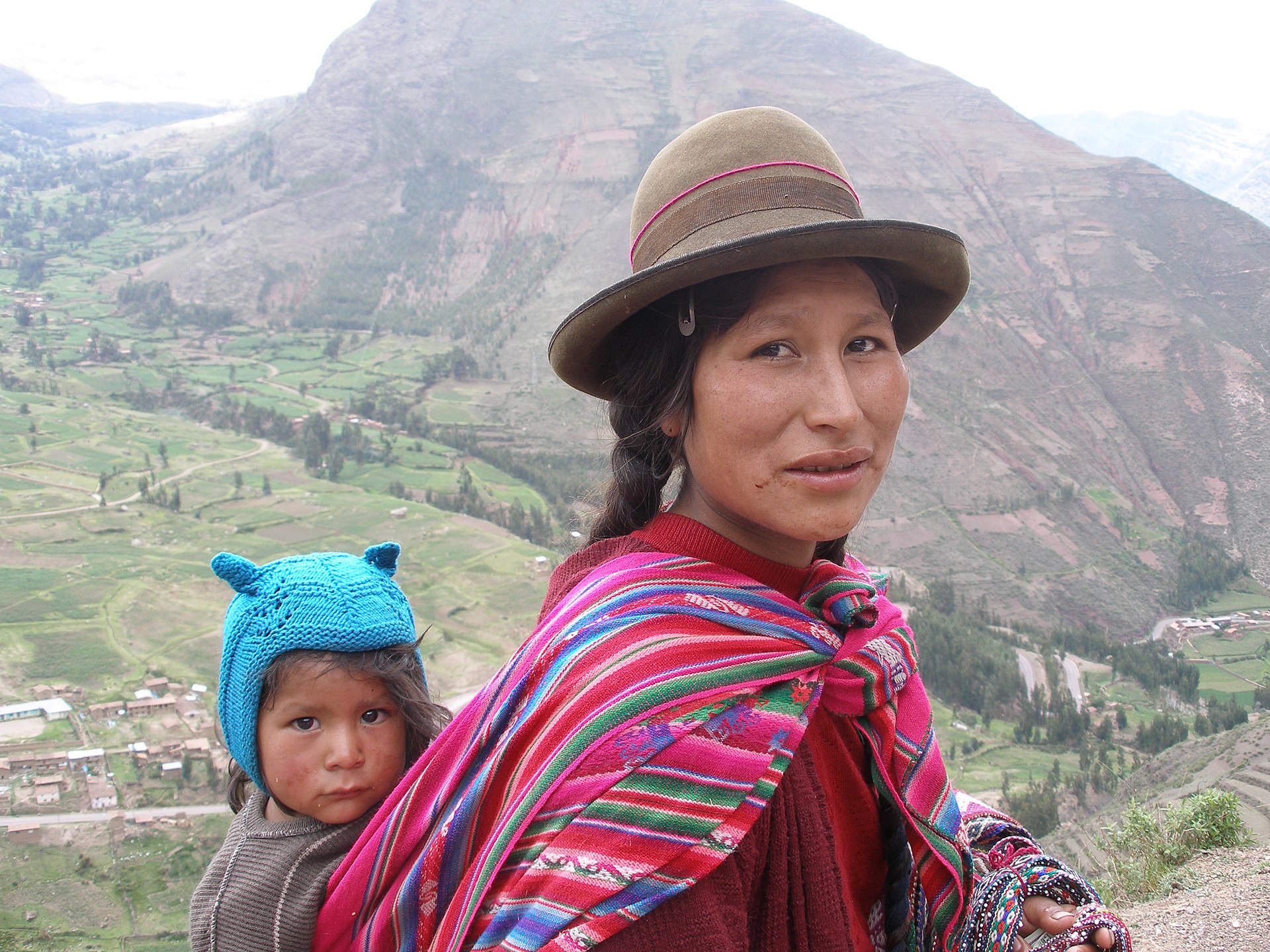 A Quechua woman and child in the Sacred Valley in Cuzco Region, Peru According to the 2017 Census, the Indigenous population in Peru makes up approximately 26%.[5] However, this does not include mestizos of mixed Indigenous and European descent, who make up the majority of the population. Genetic testing indicates that Peruvian Mestizos are of predominantly Indigenous ancestry.[267] Indigenous traditions and customs have shaped the way Peruvians live and see themselves today. Cultural citizenship — or what Renato Rosaldo has called, "the right to be different and to belong, in a democratic, participatory sense" (1996:243) — is not yet very well developed in Peru. This is most apparent in the country's Amazonian region, where Indigenous societies continue to struggle against state-sponsored economic abuses, cultural discrimination, and pervasive violence.[268] Suriname Main article: Indigenous peoples in Suriname According to the 2012 census, the Indigenous population of Suriname numbers around 20,000, amounting to 3.8% of the population. The most numerous Indigenous groups in Suriname primarily comprise the Lokono, Kalina, Tiriyó, and Wayana. Uruguay Main article: Indigenous peoples in Uruguay In the 2023 census, 6.4% of the population in Uruguay claimed to have some degree of indigenous ancestry.[269] Venezuela Main article: Indigenous peoples in Venezuela 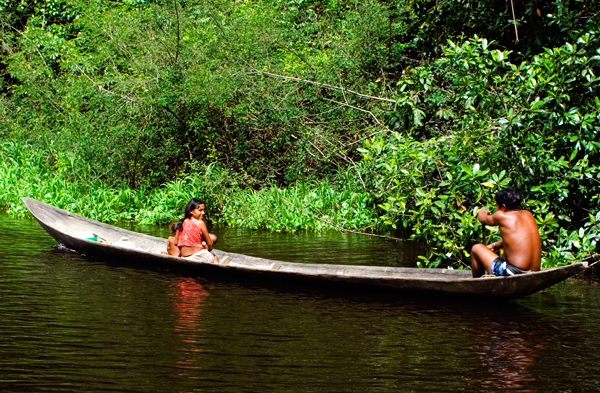 A Warao family traveling in their canoe in Venezuela Most Venezuelans have some degree of Indigenous heritage even if they may not identify as such. The 2011 census estimated that around 52% of the population identified as mestizo. But those who identify as Indigenous, from being raised in those cultures, make up only around 2% of the total population. The Indigenous peoples speak around 29 different languages and many more dialects. As some of the ethnic groups are very small, their native languages are in danger of becoming extinct in the next decades. The most important Indigenous groups are the Ye'kuana, the Wayuu, the Kali'na, the Ya̧nomamö, the Pemon, and the Warao. The most advanced Indigenous peoples to have lived within the boundaries of present-day Venezuela are thought to have been the Timoto-cuicas, who lived in the Venezuelan Andes. Historians estimate that there were between 350,000 and 500,000 Indigenous inhabitants at the time of Spanish colonization. The most densely populated area was the Andean region (Timoto-cuicas), thanks to their advanced agricultural techniques and ability to produce a surplus of food. The 1999 constitution of Venezuela gives Indigenous peoples special rights, although the vast majority of them still live in very critical conditions of poverty. The government provides primary education in their languages in public schools to some of the largest groups, in efforts to continue the languages. |
ブラジル 関連項目: ブラジルの先住民  2022年時点の各州における先住民比率。  現代ブラジル出身の先住民テレナ族の男性 ブラジルの先住民は人口の0.4%(約81万7千人)を占めるが、数百万人のブラジル人が混血(メスティソ)であるか、何らかの先住民の血筋を持ってい る。[260] 先住民はブラジル全土に分布しているが、21世紀においては、その大多数が国内北部および中西部地域の先住民保護区に居住している。2007年1月18 日、国立先住民財団(FUNAI)は、ブラジル国内に67の未接触部族の存在を確認したと報告した。これは2005年の40部族から増加した数値である。 ブラジルは現在、未接触部族の数が最も多い国民であり、ニューギニア島がそれに次ぐ。[260] ワシントン・ポスト紙は2007年に次のように報じた。「過去に証明されたように、未接触部族が他の集団や彼らが持つ微生物と接触すると、風邪のような単 純な病気でも致命的となり得る。」 1970年代、パナラ族の185人が発見から2年以内にインフルエンザや水痘などの感染症にかかり死亡し、生存者は69人だけとなった。」[261] チリ 主な記事:チリの先住民  現代チリのマプチェ族の男性  マプチェ族の男女。マプチェ族はチリ先住民人口の約85%を占める。 2012年国勢調査によれば、イースター島のラパ・ヌイ族(ポリネシア系民族)を含むチリ人口の10%が先住民である。ただし大半は程度の差こそあれ混血 の血筋を持つ。[262] 多くはマプチェ族の子孫であり、サンティアゴ、アラウカニア、ロス・ラゴス地方に居住している。マプチェ族はアラウコ戦争において、スペイン支配下の最初 の300~350年間、敗北を免れることに成功した。チリ共和国との関係は良好だったが、チリ政府が彼らの土地を占領することを決定したことで悪化した。 アラウカニア占領期、マプチェ族は1880年代にチリ軍に降伏した。彼らの土地はチリ人やヨーロッパ人による入植に開放された。マプチェの土地権利をめぐ る紛争は現在も続いている。 その他のグループにはアイマラ族が含まれる。その大半はボリビアとペルーに居住し、少数派がアリカ・パリナコタ地域とタラパカ地域に存在する。またアタカマ人民(アタカメニョス)は主にエル・ロアに居住している。 コロンビア 主な記事:コロンビアの先住民  コロンビアでくつろぐグアンビア族 コロンビアでは、先住民は現在、メスティソや白人が大多数を占める人口の中で少数派だ。コロンビアに住む先住民は、約85の異なる文化と約 1,905,617人で構成されているが、実際にはもっと多い可能性が高い。[263] [264] 1991年憲法では先住民に対する様々な集団的権利が認められている。影響の一つはチブチャ民族集団の一部であるムイスカ文化であり、金細工で有名でエル ドラド伝説の起源となった。スペイン征服当時、ムイスカはインカ帝国とアステカ帝国に地理的に挟まれた最大の先住民文明であった。 エクアドル 主な記事:エクアドルの先住民  現在のエクアドルにあたるアマゾン森林地帯のコファン族のシャーマン エクアドルは、規模の異なる多くの先住民文化や文明が栄えた地であった。沿岸部ではバルディビア文化と呼ばれる初期の定住文化が発達し、カラ族とキトゥ族 は統合して高度な文明を形成したが、首都キトの誕生と共に終焉を迎えた。クエンカ近郊のカニャリス族は最も先進的で、インカ帝国への激しい抵抗からインカ に最も恐れられた。彼らの建築遺跡は後にスペイン人とインカによって破壊された。 エクアドルの人口の55%から65%は、先住民とヨーロッパ人の混血のメスティーソで構成され、先住民は約25%を占める[265]。遺伝子分析によれ ば、エクアドルのメスティーソは主に先住民の祖先を持つ[266]。エクアドルの先住民人口の約96.4%は、シエラ地域の谷間に住む高地のケチュア族で ある。主にインカ帝国に征服された人民の子孫から成り、キチュワ語を話す。カラングイ族、オタバロ族、カヤンベ族、キトゥ・カラス族、パンサレオ族、チン ブエロ族、サラサカン族、トゥグア族、プルハ族、カニャリ族、サラグロ族などが含まれる。言語学的証拠から、サラスカン族とサラグロ族は、ミティマエとし てエクアドルに移住したボリビアの民族集団の子孫である可能性がある。 アワ族、チャチ族、チャチラ族を含む沿岸部の人々は先住民人口の0.24%を占め、残りの3.35%はオリエンテ地域に居住している。オリエンテ・キチュワ(カネロ族とキホス族)、シュアル族、ワオラニ族、シオナ・セコヤ族、コファン族、アチュアル族がこれに該当する。 1986年、エクアドルの先住民は「真に」全国規模の政治組織を初めて結成した。エクアドル先住民民族連合(CONAIE)はそれ以来、先住民の主要な政 治機関であり、現在では国民第2の政党となっている。CONAIEは国民政治に大きな影響力を持ち、1997年のアブダラ・ブカラム大統領と2000年の ハミル・マウアド大統領の退陣に貢献した。 フランス領ギアナ フランス領ギアナには、カリナ族やロコノ族など約1万人の先住民が居住している。時を経て、先住民は違法な金採掘、汚染、野生動物の激減といった様々な環境問題に対して抗議活動を行ってきた。 ガイアナ 詳細記事:ガイアナの先住民 植民地化の初期段階において、ガイアナの先住民はオランダ人入植者との交易関係に参加し、逃亡奴隷の追跡といった民兵活動でイギリスを支援した。この関係は19世紀まで続いた。ガイアナ先住民は、ガイアナ風ペッパーポット料理の発明とアレルヤ教会の設立に関わっている。 ガイアナの先住民は1965年憲法で認められており、総人口の9.16%を占める。 パラグアイ 主な記事:パラグアイの先住民 パラグアイの先住民の大多数は、同国北西部のグラン・チャコ地域に集中している。パラグアイの先住民人口の大半はグアラニー族が占める。グアラニー語はス ペイン語と並んで公用語として認められており、人口の約90%がグアラニー語を話す。パラグアイの先住民は、識字率の低さや安全な飲料水・電気の不足と いった課題に直面している。 ペルー 主な記事:ペルーの先住民  ペルー、クスコ地方の聖なる谷に住むケチュア族の女性と子供 2017年の国勢調査によると、ペルーの先住民人口は約26%を占める[5]。ただし、この数字には先住民族とヨーロッパ系の混血のメスティーソは含まれ ておらず、彼らは人口の大多数を占めている。遺伝子検査によれば、ペルーのメスティーソは主に先住民の祖先を持つ。[267] 先住民の伝統と習慣は、現代ペルー人の生活様式や自己認識を形成してきた。文化的市民権——レナート・ロサルドが「民主的で参加型の意味における、異なる 存在でありながら帰属する権利」(1996:243)と呼んだもの——は、ペルーではまだ十分に発展していない。この状況はアマゾン地域で最も顕著であ り、先住民社会は国家主導の経済的搾取、文化的差別、蔓延する暴力との闘いを続けている。[268] スリナム 詳細記事: スリナムの先住民 2012年国勢調査によれば、スリナムの先住民人口は約2万人で、総人口の3.8%を占める。スリナムで最も人口の多い先住民グループは、主にロコノ族、カリナ族、ティリヨ族、ワヤナ族で構成されている。 ウルグアイ 詳細記事:ウルグアイの先住民 2023年の国勢調査では、ウルグアイの人口の6.4%が何らかの先住民の祖先を持つと申告した。[269] ベネズエラ 詳細記事:ベネズエラの先住民  ベネズエラでカヌーを漕ぐワラオ族の家族 ベネズエラ人の多くは、自らを先住民と認識していなくても、何らかの先住民の血を引いている。2011年の国勢調査では、人口の約52%がメスティーソ (混血)と自認していた。しかし、先住民文化の中で育ち、自らを先住民と認識する人々は、総人口のわずか2%程度に過ぎない。先住民は29の異なる言語 と、さらに多くの方言を話す。一部の民族集団は非常に小規模なため、彼らの母語は今後数十年で消滅する危険にさらされている。主要な先住民はイェクアナ 族、ワユー族、カリナ族、ヤノマモ族、ペモン族、ワラオ族である。現在のベネズエラ領内に住んでいた先住民の中で最も高度な文明を持っていたと考えられて いるのは、ベネズエラ・アンデス山脈に居住していたティモト・クイカ族である。歴史家によれば、スペインによる植民地化当時、先住民の人口は35万から 50万人と推定される。最も人口密度が高かったのはアンデス地域(ティモト・クイカス族)で、これは彼らの高度な農業技術と食糧余剰生産能力によるもの だった。 1999年のベネズエラ憲法は先住民に特別な権利を認めているが、大多数は依然として深刻な貧困状態にある。政府は主要な先住民集団に対し、公教育機関で母語による初等教育を提供し、言語継承に努めている。 |
| Caribbean Main article: Indigenous peoples of the Caribbean The Indigenous population of the Caribbean islands consisted of the Taíno of the Lucayan Archipelago, the Greater Antilles and the northern Lesser Antilles, the Kalinago of the Lesser Antilles, the Ciguayo and Macorix of parts of Hispaniola, and the Guanahatabey of western Cuba. The overall population suffered the most adverse colonial effects out of all the Indigenous populations in the Americas, as the Kalinago have been reduced to a few islands in the Lesser Antilles such as Dominica and the Taíno are culturally extinct, though a large proportion of populations in Greater Antillean islands such as Puerto Rico and Cuba to a lesser extent,[270] possesses degrees of Taíno ancestry. The Cayman Islands were the only island group in the Caribbean to have remained unsettled by Indigenous peoples before the colonial era.[271] Asia Main article: Latin American Asian Philippines Main article: Mexican settlement in the Philippines Historically, during the Spanish colonization of the Philippines, the territory was ruled as a province of the Mexico-centered Viceroyalty of New Spain and thus many Mexicans including those of Indgenous Aztec and Tlaxcalan descent, were sent as colonists there.[272]: Chpt. 6 According to a genetic study by the National Geographic, Filipinos can trace an average of 2% of their ancestry to Native Americans.[273][274] |
カリブ海 主な記事: カリブ海の先住民 カリブ海の島々の先住民は、ルカヤン諸島、大アンティル諸島、小アンティル諸島北部に住むタイノ族、小アンティル諸島のカリナゴ族、イスパニョーラ島の一 部に住むシグアヨ族とマコリックス族、そしてキューバ西部に住むグアナハタベイ族で構成されていた。カリブ諸島の先住民は、アメリカ大陸の先住民の中で最 も深刻な植民地支配の影響を苦悩した。カリナゴ族はドミニカ島などの小アンティル諸島の数島に減少した。タイノ族は文化的に消滅した。ただし、プエルトリ コやキューバなど大アンティル諸島では、人口の大部分が[270]程度のタイノ族の祖先を持つ。ケイマン諸島は、植民地時代以前、先住民による定住がな かったカリブ海唯一の島嶼群であった。[271] アジア 詳細記事: ラテンアメリカ系アジア人 フィリピン 詳細記事: フィリピンにおけるメキシコ人入植 歴史的に、スペインによるフィリピン植民地化時代、この地域はメキシコを中心とするニュー・スペイン副王領の属州として統治されていた。そのため、先住民 アステカやトラスカラ系の血を引く者を含む多くのメキシコ人が入植者として送り込まれた。[272]:第6章 ナショナルジオグラフィックの遺伝子研究に よれば、フィリピン人の祖先の平均2%はネイティブアメリカンに遡ることができる。[273][274] |
| Rise of Indigenous movements Since the late 20th century, Indigenous peoples in the Americas have become more politically active in asserting their treaty rights and expanding their influence. Some have organized to achieve some sort of self-determination and preservation of their cultures. Organizations such as the Coordinator of Indigenous Organizations of the Amazon River Basin and the Indian Council of South America are examples of movements that are overcoming national borders to reunite Indigenous populations, for instance, those across the Amazon Basin. Similar movements for Indigenous rights can also be seen in Canada and the United States, with movements like the International Indian Treaty Council and the accession of native Indigenous groups into the Unrepresented Nations and Peoples Organization. There has been a recognition of Indigenous movements on an international scale. The membership of the United Nations voted to adopt the Declaration on the Rights of Indigenous Peoples, despite dissent from some of the stronger countries of the Americas. In Colombia, various Indigenous groups have protested the denial of their rights. People organized a march in Cali in October 2008 to demand the government live up to promises to protect Indigenous lands, defend the Indigenous against violence, and reconsider the free trade pact with the United States.[275] Indigenous heads of state 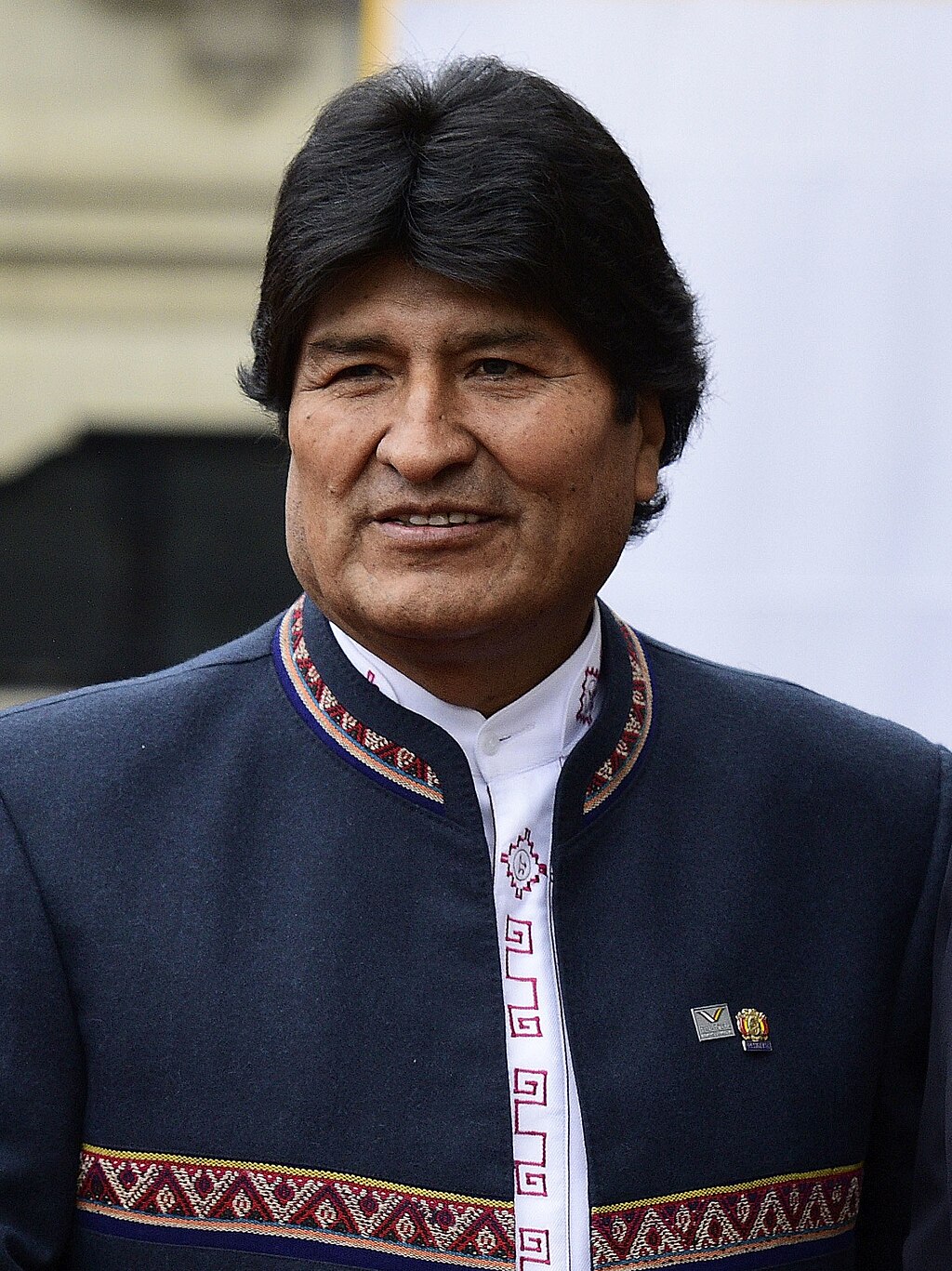 Evo Morales, an Aymara member and former President of Bolivia The first Indigenous President of the Americas was José María Melo, of Pijao descent, who led Colombia in 1854 starting on 17 April 1854. José was born on 9 October 1800, in Chaparral, Tolima, and before his presidency, he fought alongside Simon Bolivar in the Spanish-American Wars of Independence. José María Melo led the Republic of New Granada during the Colombian Civil War of 1854 but eventually lost and was exiled on 4 December 1854.[276] The first Indigenous candidate to be democratically elected as head of a country in the Americas was Benito Juárez, a Zapotec Mexican who was elected President of Mexico in 1858 and led the country until 1872 and led the country to victory during the Second French intervention in Mexico.[277] In 1930 Luis Miguel Sánchez Cerro became the first Peruvian President with Indigenous Peruvian ancestry and the first in South America.[278] He came to power in a military coup. In 2005, Evo Morales of the Aymara people was the first Indigenous candidate elected as president of Bolivia and the first elected in South America.[279] |
先住民運動の勃興 20世紀後半以降、アメリカ大陸の先住民は条約上の権利を主張し影響力を拡大するため、政治的に活発化している。一部は自己決定権の獲得や文化保存を目指 して組織化を進めた。アマゾン川流域先住民族組織調整会議や南米インディアン評議会といった組織は、国境を越えて先住民を再結集させる運動の例だ。例えば アマゾン流域全域にまたがる先住民の結束が挙げられる。カナダやアメリカ合衆国でも、国際インディアン条約評議会(IITC)の活動や、先住民族グループ が未承認民族人民機構(UNPO)に加盟する動きなど、同様の先住民族権利運動が見られる。 国際的な規模で先住民族運動が認知されるようになった。国連加盟国は、アメリカ大陸の有力国の一部が反対したにもかかわらず、『先住民族の権利に関する宣言』を採択する投票を行った。 コロンビアでは、様々な先住民グループが権利の否定に抗議している。2008年10月にはカリでデモ行進が行われ、人民は政府に対し先住民の土地保護、暴力からの防衛、米国との自由貿易協定の再考を約束通り履行するよう要求した[275]。 先住民の国家元首  エボ・モラレス(アイマラ族出身、元ボリビア大統領) アメリカ大陸初の先住民大統領は、ピハオ族の血を引くホセ・マリア・メロである。彼は1854年4月17日よりコロンビアを統治した。ホセは1800年 10月9日、トリマ州チャパラルで生まれ、大統領就任前にはシモン・ボリバルと共にスペイン独立戦争で戦った。ホセ・マリア・メロは1854年のコロンビ ア内戦中に新グラナダ共和国を率いたが、最終的に敗北し、1854年12月4日に亡命した。 アメリカ大陸で民主的に国家元首に選出された最初の先住民候補者は、1858年にメキシコ大統領に選出され、1872年まで同国を率い、第二次フランスによるメキシコ介入の際に同国を勝利に導いた、サポテカ族のメキシコ人、ベニート・フアレスであった。[277] 1930年、ルイス・ミゲル・サンチェス・セロは、ペルー人としては初めて、また南米では初めて、先住民の祖先を持つペルー大統領となった。[278] 彼は軍事クーデターで政権を握った。 2005年、アイマラ族のエボ・モラレスは、ボリビア大統領に選出された最初の先住民候補者であり、南米で初めて選出された先住民大統領となった。[279] |
| Genetic research Main article: Genetic history of Indigenous peoples of the Americas See also: Y-DNA haplogroups in Indigenous peoples of the Americas 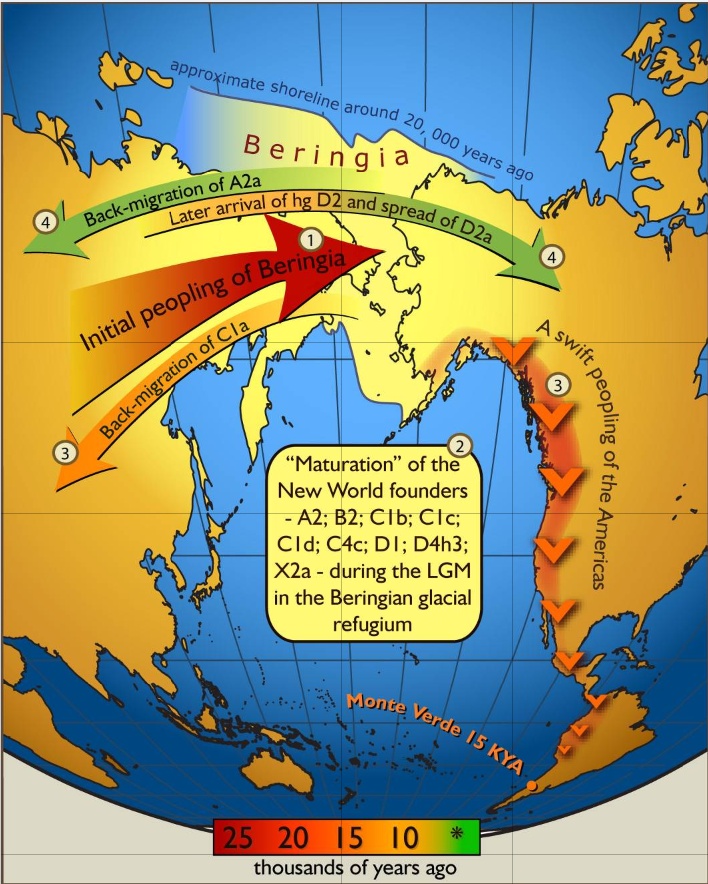 Schematic illustration of maternal geneflow in and out of Beringia. Colours of the arrows correspond to approximate timing of the events and are decoded in the coloured time-bar. The initial peopling of Berinigia (depicted in light yellow) was followed by a standstill after which the ancestors of Indigenous Americans spread swiftly throughout the New World while some of the Beringian maternal lineages, such as C1a, spread westwards. More recent genetic exchange (shown in green) is manifested by back-migration of A2a into Siberia and the spread of D2a into the Northeastern United States that post-dates the initial arrival of people in the New World. A schematic illustration of maternal (mtDNA) gene-flow in and out of Beringia, from 25,000 years ago to present 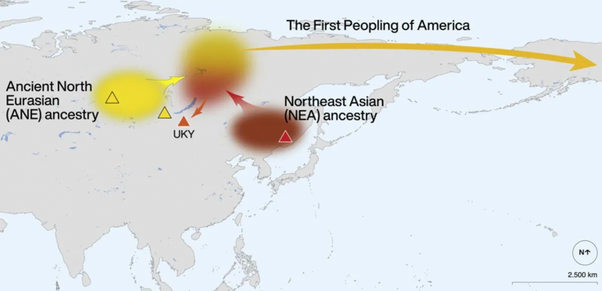 A map showing the origin of the first wave of humans into the Americas, including the Ancestral Northern Eurasian, which represent a distinct Paleolithic Siberian population, and the Northeast Asians, which are an East Asian-related group. The admixture happened somewhere in Northeast Siberia.[280]  Principal component analysis showing the Native American cluster in other Eurasian populations.[281] Genetic history of Indigenous peoples of the Americas primarily focuses on Human Y-chromosome DNA haplogroups and Human mitochondrial DNA haplogroups. "Y-DNA" is passed solely along the patrilineal line, from father to son, while "mtDNA" is passed down the matrilineal line, from mother to offspring of both sexes. Neither recombines and thus Y-DNA and mtDNA change only by chance mutation at each generation with no intermixture between parents' genetic material.[282] Autosomal "atDNA" markers are also used but differ from mtDNA or Y-DNA in that they overlap significantly.[283] AtDNA is generally used to measure the average continent-of-ancestry genetic admixture in the entire human genome and related isolated populations.[283] Genetic comparisons of the mitochondrial DNA (mtDNA) and Y-chromosome of Native Americans to that of certain Siberian and Central Asian peoples (specifically Paleo-Siberians, Turkic, and historically the Okunev culture) have led Russian researcher I.A. Zakharov to believe that, among all the previously studied Asian peoples, it is "the peoples living between Altai and Lake Baikal along the Sayan mountains that are genetically closest to" Indigenous Americans.[284] Some scientific evidence links them to North Asian peoples, specifically the Indigenous peoples of Siberia, such as the Ket, Selkup, Chukchi, and Koryak peoples. Indigenous peoples of the Americas have been linked to some extent to North Asian populations by the distribution of blood types, and in genetic composition as reflected by molecular data, and limited DNA studies.[285][286][287] The common occurrence of the Asian mtDNA haplogroups A, B, C, and D among eastern Asian and Native American populations has been noted.[288] Some subclades of C and D that have been found in the limited populations of Native Americans who have agreed to DNA testing[286][287] bear some resemblance to the C and D subclades in Mongolian, Amur, Japanese, Korean, and Ainu populations.[288][289] Available genetic patterns lead to two main theories of genetic episodes affecting the Indigenous peoples of the Americas; first with the initial peopling of the Americas, and secondly with European colonization of the Americas.[290][291][292] The former is the determinant factor for the number of gene lineages, zygosity mutations, and founding haplotypes present in today's Indigenous peoples of the Americas populations.[291] The most popular theory among anthropologists is the Bering Strait theory, of human settlement of the New World occurring in stages from the Bering Sea coastline, with a possible initial layover of 10,000 to 20,000 years in Beringia for the small founding population.[293][294][295] The micro-satellite diversity and distributions of the Y lineage specific to South America indicate that certain Indigenous peoples of the Americas populations have been isolated since the initial colonization of the region.[296] The Na-Dené, Inuit, and Indigenous populations of Alaska exhibit haplogroup Q (Y-DNA) mutations, however are distinct from other Indigenous peoples of the Americas with various mtDNA and atDNA mutations.[297][298][299] This suggests that the earliest migrants into the northern extremes of North America including Greenland derived from later migrant populations.[300][301] Multiple recent findings on autosomal DNA and full genome revealed more information about the formation, settlement, and external relationships of the Indigenous peoples of the Americas to other populations. Native Americans are very closely related to the Paleosiberian tribes of Siberia, and to the ancient samples of the Mal'ta–Buret' culture (Ancient North Eurasians) as well as to the Ancient Beringians. Native Americans also share a relatively higher genetic affinity with East Asian peoples. Native American genetic ancestry is occasionally dubbed as "Amerindian". This type of ancestry largely overlaps with "Paleosiberian" ancestry but is differentiated from "Neo-Siberian" ancestry, which represents historical expansions from Northeast Asia and is today widespread among Siberian populations. The ancestors of Native Americans used a single migration route, most likely through Beringia, and subsequently populated all of the Americas in a time range between 25,000 and 15,000 years ago. Possible contact between Native Americans and Polynesians dates back to 1,400 years ago. Previously hypothesized "Paleo-Indian" groups turned out to be genetically identical to modern Native Americans. The controversial claim that the first peoples came from Europe via the North Atlantic, based on an ostensible similarity in stone-tool technology between the Solutrean culture of Pleistocene Europe and Clovis in North America, was undermined by the genome of the Anzick Clovis child, which sits squarely on the branch of Ancestral Native American peoples. No ancient or present-day genome (or mtDNA or Y chromosome marker) in the Americas has shown any direct affinities to Upper Palaeolithic European populations.[302][303][304][305][306][307][308][309] 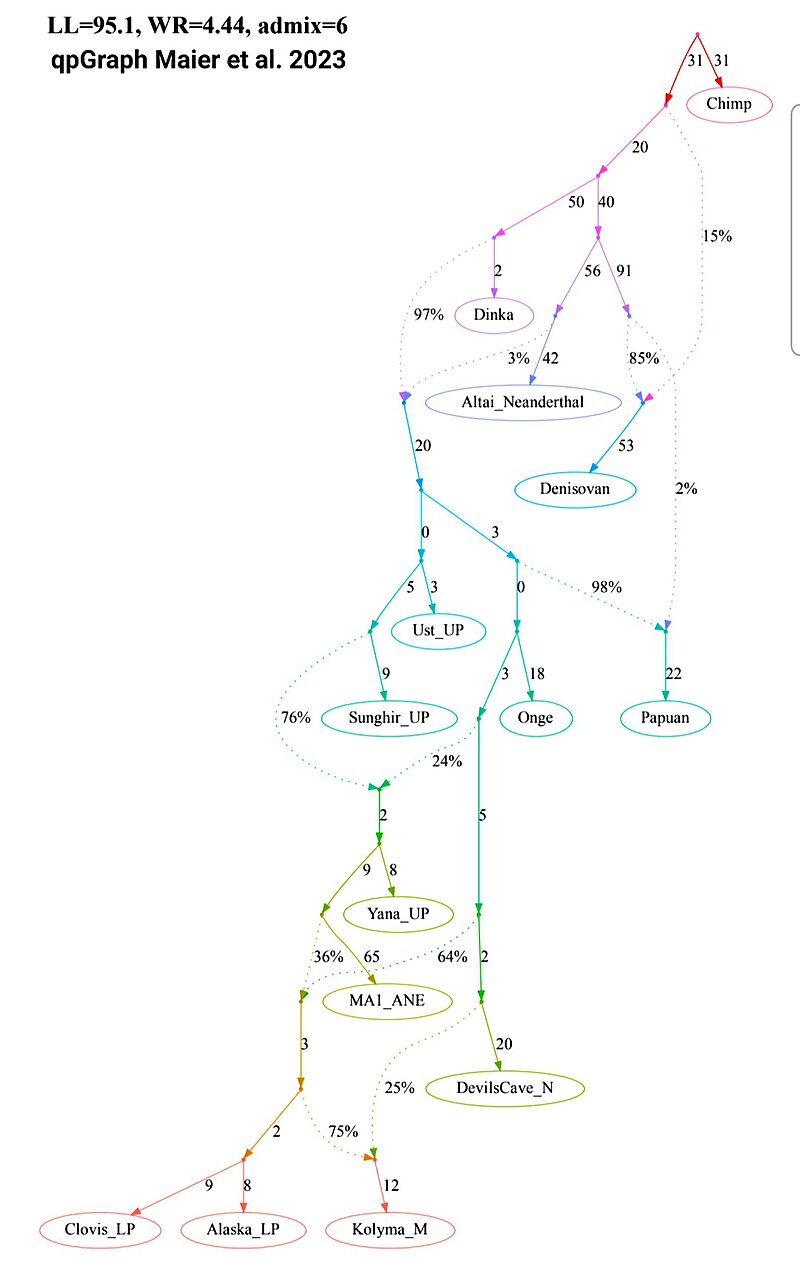 A qpGraph on the formation of Ancient Paleo-Siberians and Native American populations.[310] The date for the formation of the Indigenous peoples of the Americas gene pool ranges from 36,000 to 25,000 years ago, with their internal diverging being around 21,000 years ago, during the settlement of the Americas.[311] Native Americans formed from the admixture of a lineage that diverged from Ancient East Asian people around 36,000 years ago somewhere in Southern China, and subsequently migrated northwards into Siberia where they merged with a Paleolithic Siberian population known as Ancient North Eurasians (ANE), deeply related to European hunter-gatherers, giving rise to both Indigenous peoples of Siberia and Ancestral Native Americans. Both Paleo-Siberians and Ancestral Native Americans derive between 32 and 44% of their ancestry from Ancient North Eurasians (ANE), and 56–68% ancestry from Ancient East Asians.[312][313][314][315] Based on a 2023 mitochondrial DNA study, a subsequent wave of migration from Northern China, originating near the present-day cities of Beijing and Tianjin, occurred as recently as 9000 BCE, following a previously unknown coastal route from Asia to America.[316] |
遺伝学研究 主な記事: アメリカ先住民の遺伝的歴史 関連項目: アメリカ先住民におけるY染色体ハプログループ  ベーリング陸橋における母系遺伝子流動の概略図。矢印の色は出来事のおおよその時期に対応し、色分けされた時間軸で解読される。ベーリング陸橋への初期移 住(薄黄色で示される)の後、停滞期を経て、アメリカ先住民の祖先は新大陸全域に急速に拡散した。一方、C1aなどのベーリング陸橋の母系系統の一部は西 方向へ拡散した。より近年の遺伝的交流(緑色で示される)は、A2a系統のシベリアへの逆移住と、D2a系統の北東アメリカ合衆国への拡散によって現れて おり、これらは新大陸への最初の移住より後の出来事である。 約2万5千年前から現在までの、ベーリング地峡における母系(ミトコンドリアDNA)遺伝子流動の概略図  アメリカ大陸への最初の人類波動の起源を示す地図。これには旧石器時代のシベリア集団を代表する祖先的北ユーラシア人種と、東アジア関連集団である北東アジア人が含まれる。混血は北東シベリアのどこかで起きた。[280]  他のユーラシア集団におけるネイティブアメリカン集団を示す主成分分析。[281] アメリカ先住民の遺伝的歴史は主に、ヒトY染色体DNAハプログループとヒトミトコンドリアDNAハプログループに焦点を当てる。「Y染色体DNA」は父 系のみ、つまり父から息子へと受け継がれる。「ミトコンドリアDNA」は母系、つまり母から子(男女問わず)へと受け継がれる。いずれも再結合せず、した がってY-DNAとmtDNAは各世代で偶然の突然変異によってのみ変化し、親の遺伝物質間の混交は生じない。[282]常染色体「atDNA」マーカー も使用されるが、mtDNAやY-DNAとは異なり、これらは大きく重複する。[283]atDNAは一般的に、全ヒトゲノムおよび関連する孤立集団にお ける平均的な祖先大陸の遺伝的混交を測定するために用いられる。[283] ネイティブアメリカンのミトコンドリアDNA(mtDNA)とY染色体を、特定のシベリア・中央アジアの人民(具体的には古シベリア人、テュルク系、歴史 的にはオクネフ文化)と比較した遺伝学的分析から、ロシア人研究者I.A. ザハロフは、これまでに研究されたアジア諸民族の中で、「アルタイ山脈とバイカル湖の間、サヤン山脈沿いに住む民族が、先住民に遺伝学的に最も近い」と結 論づけた。[284] 一部の科学的証拠は、彼らを北アジアの民族、特にシベリアの先住民(ケト族、セルクプ族、チュクチ族、コリャーク族など)と結びつけている。アメリカ先住 民は、血液型の分布や分子データに反映される遺伝的構成、限定的なDNA研究によって、ある程度北アジアの人々と関連付けられている[285][286] [287]。 東アジアとアメリカ先住民集団の間で、アジアのミトコンドリアDNAハプログループA、B、C、Dが共通して見られることが指摘されている。[288] DNA検査に同意した限られた先住民集団で見つかったCおよびDのサブクレードの一部は、モンゴル人、アムール人、日本人、韓国人、アイヌ人の集団に見ら れるCおよびDのサブクレードと幾分類似している。[288][289] 利用可能な遺伝的パターンから、アメリカ先住民に影響を与えた遺伝的出来事に関する二つの主要な理論が導かれる。第一にアメリカ大陸への初期移住、第二に ヨーロッパ人によるアメリカ大陸の植民地化である[290][291][292]。前者は、今日のアメリカ先住民集団に存在する遺伝子系統数、接合性変 異、および創始ハプロタイプを決定する要因である。[291] 人類学者間で最も支持されている説はベーリング海峡説である。これは新大陸への人類移住がベーリング海沿岸から段階的に進行し、少数の創始集団がベーリン ギアで1万~2万年の初期滞留期間を経た可能性を示唆する。[293][294] [295] 南米固有のY染色体系統のマイクロサテライト多様性と分布は、特定のアメリカ先住民集団がこの地域への初期定住以来、隔離状態にあったことを示している。 [296] ナ・デネ族、イヌイット、アラスカ先住民はハプログループQ(Y染色体DNA)変異を示すが、様々なミトコンドリアDNAおよび常染色体DNA変異を持つ 他のアメリカ先住民とは異なる。[297][298][299] これは、グリーンランドを含む北米最北端地域への初期移住者が、後期の移住集団に由来することを示唆している。[300] [301] 常染色体DNA及び全ゲノムに関する複数の近年の研究成果は、アメリカ先住民の形成、定住、他集団との外部関係について新たな知見をもたらした。ネイティ ブアメリカンはシベリアの古シベリア人部族、マルタ・ブレト文化(古代北ユーラシア人)の古代サンプル、そして古代ベリンジア人と非常に近縁である。ネイ ティブアメリカンは東アジアの人民とも比較的高い遺伝的親和性を共有している。ネイティブアメリカンの遺伝的祖先は時に「アメリカ先住民祖先」と呼ばれ る。この祖先系統は「古シベリア祖先」と大きく重なるが、「新シベリア祖先」とは区別される。後者は北東アジアからの歴史的拡散を表し、現在シベリア集団 に広く分布している。アメリカ先住民の祖先は単一の移動経路、おそらくベーリング陸橋を経由し、2万5千年前から1万5千年前までの間に全米大陸に定住し た。アメリカ先住民とポリネシア人との接触の可能性は1400年前に遡る。従来仮説とされた「古インディアン」集団は、現代のアメリカ先住民と遺伝的に同 一であることが判明した。旧石器時代ヨーロッパのソリュトレ文化と北米クロヴィス文化の石器技術に類似性があるという主張に基づき、最初の住民が北大西洋 経由でヨーロッパから来たとする論争的な説は、アンジック・クロヴィス少年のゲノムによって否定された。そのゲノムは先住アメリカ人の系統に完全に属して いたのである。アメリカ大陸の古代・現代のゲノム(あるいはミトコンドリアDNAやY染色体マーカー)は、いずれも旧石器時代後期のヨーロッパ人集団との 直接的な親縁性を示していない。[302][303][304][305][306][307][308] [309]  古代シベリア系住民とアメリカ先住民集団の形成に関するqpGraph。[310] アメリカ大陸先住民の遺伝子プールの形成時期は3万6千年前から2万5千年前とされ、内部分岐は約2万1千年前、すなわちアメリカ大陸定住期に起こった。 [311] ネイティブアメリカンは、約36,000年前に中国南部で古代東アジア人から分岐した系統と、その後北上してシベリアへ移住した旧石器時代のシベリア人集 団(古代北ユーラシア人:ANE)が混血して形成された。ANEはヨーロッパの狩猟採集民と深い関係があり、シベリア先住民と祖先的ネイティブアメリカン の両方の起源となった。旧シベリア人と祖先アメリカ先住民の双方は、祖先北ユーラシア人(ANE)からの祖先を32~44%、古代東アジア人からの祖先を 56~68%有している。[312][313][314][315] 2023年のミトコンドリアDNA研究によれば、中国北部(現在の北京・天津付近)からの次の移住波は紀元前9000年という比較的最近に発生し、アジア からアメリカ大陸へ至るこれまで知られていなかった沿岸ルートを経由していた。[316] |
| Demography Further information: Population history of Indigenous peoples of the Americas The following table provides estimates for each country or territory in the Americas of the populations of Indigenous people and those with partial Indigenous ancestry, each expressed as a percentage of the overall population. The total percentage obtained by adding both of these categories is also given. Note: these categories are inconsistently defined and measured differently from country to country. Some figures are based on the results of population-wide genetic surveys, while others are based on self-identification or observational estimation. Indigenous populations of the Americas as estimated percentage of total country or territory's population 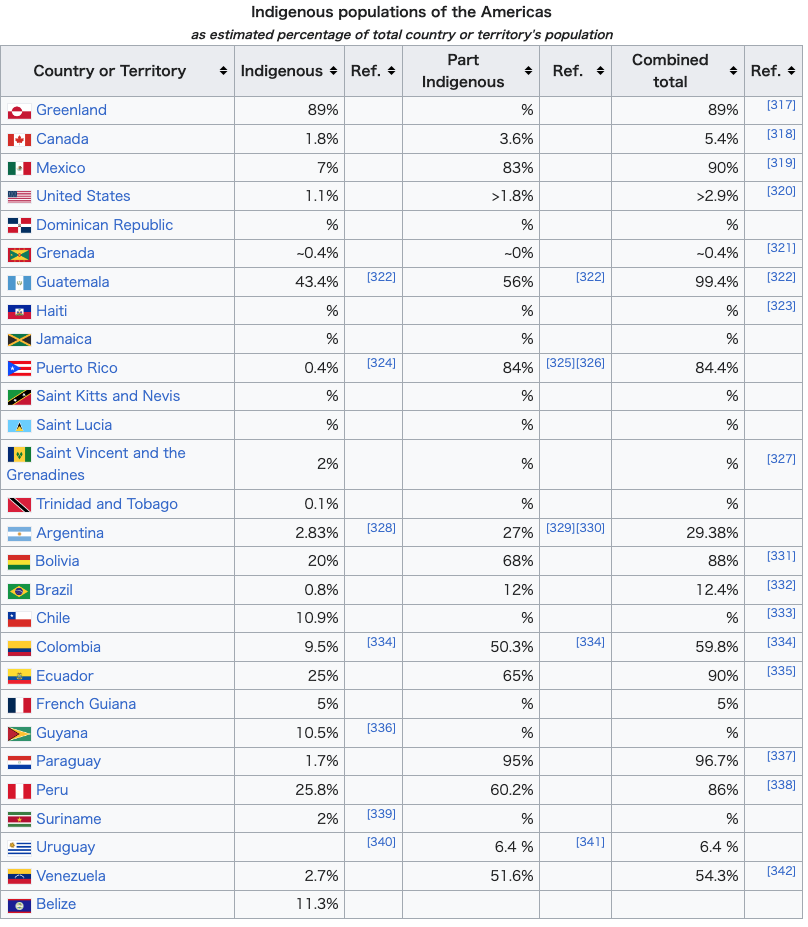 |
人口統計 詳細情報:アメリカ先住民の人口史 以下の表は、アメリカ大陸の各国・地域における先住民および先住民の血筋を部分的に持つ人々の人口推計値を示す。いずれも総人口に対する割合で表されている。両カテゴリーを合計した総割合も併せて記載する。 注:これらのカテゴリーは定義が統一されておらず、国によって測定方法が異なる。一部の数値は全国規模の遺伝子調査結果に基づく一方、自己申告や観察推定に基づくものもある。 アメリカ大陸の先住民人口 (国または地域の人口総数に対する推定割合)  |
| Notable people Main article: List of Indigenous people of the Americas |
著名な人物 主な記事: アメリカ先住民の一覧 |
| See also icon Civilizations portal icon Indigenous peoples of the Americas portal Indigenous peoples in Ecuador Indigenous peoples in Paraguay Indigenous peoples of Costa Rica Indigenous peoples in Argentina Indigenous peoples of Peru Indigenous peoples in Canada Indigenous peoples in Colombia Indigenous peoples in Brazil Indigenous peoples in Chile Languages of Guatemala Indigenous languages of the Americas Ancient American engineering Andean culture (disambiguation) List of Indigenous peoples List of Greenlandic Inuit List of Indigenous artists of the Americas List of Indigenous peoples of the Americas List of Indigenous writers from the Americas Culture Ceramics of Indigenous peoples of the Americas Chunkey Fully feathered basket Indian Mass Native American religion Pow wow Shamanism Population and demographics Child development of the Indigenous peoples of the Americas Classification of the Indigenous peoples of the Americas Indigenous Movements in the Americas Origins of Paleoindians Pacific Islander Population history of the Indigenous peoples of the Americas Central and South America Indigenous peoples of South America List of Mayan languages Society in the Spanish Colonial Americas Caribbean Indigenous peoples of the Caribbean Indigenous peoples of Guyana Indigenous peoples of Suriname North America Genocide of Indigenous peoples of the Americas History of the west coast of North America List of traditional territories of the Indigenous peoples of North America Native Americans in the United States List of American Inuit Native American Languages Act of 1990 Native American weaponry Native Americans in German popular culture Republic of Lakotah Redskin |
関連項目 icon 文明ポータル icon アメリカ先住民ポータル エクアドルの先住民 パラグアイの先住民 コスタリカの先住民 アルゼンチンの先住民 ペルーの先住民 カナダの先住民 コロンビアの先住民 ブラジルの先住民 チリの先住民 グアテマラの言語 アメリカ先住民の言語 古代アメリカの技術 アンデス文化 (曖昧さ回避) 先住民の一覧 グリーンランド・イヌイットの一覧 アメリカ大陸の先住民芸術家の一覧 アメリカ大陸の先住民の一覧 アメリカ大陸の先住民作家の一覧 文化 アメリカ大陸先住民族の陶器 チュンキー 羽根飾りのバスケット インディアン・ミサ ネイティブアメリカンの宗教 パウワウ シャーマニズム 人口と人口統計 アメリカ先住民の子どもの発達 アメリカ先住民の分類 アメリカ先住民運動 古インド人の起源 太平洋諸島民 アメリカ先住民の人口史 中南米 南アメリカの先住民 マヤ語一覧 スペイン植民地時代のアメリカ社会 カリブ カリブ海の先住民 ガイアナの先住民 スリナムの先住民 北アメリカ アメリカ先住民のジェノサイド 北アメリカ西海岸の歴史 北アメリカ先住民の伝統的領土一覧 アメリカ合衆国のネイティブアメリカン アメリカ先住民イヌイット一覧 1990年ネイティブアメリカン言語法 ネイティブアメリカンの武器 ドイツポピュラー・カルチャーにおけるネイティブアメリカン ラコタ共和国 レッドスキン |
| References | |
| Sources Books Barnes, Ian (2015). The Historical Atlas of Native Americans. New York: Chartwell Books. ISBN 978-0-7858-3145-7. Cappel, Constance (2007). The Smallpox Genocide of the Odawa Tribe at L'Arbre Croche, 1763: The History of a Native American People. Lewiston, NY: Edwin Mellen Press. ISBN 978-0-7734-5220-6. OCLC 175217515. Cappel, Constance, ed. (2006). Odawa Language and Legends: Andrew J. Blackbird and Raymond Kiogima. Xlibris. ISBN 978-1-59926-920-7.[self-published source] Churchill, Ward (1997). A Little Matter of Genocide: Holocaust and Denial in the Americas, 1492 to the Present. San Francisco: City Lights Books. ISBN 978-0-87286-323-1. OCLC 35029491. Dean, Bartholomew (2002). "State Power and Indigenous Peoples in Peruvian Amazonia: A Lost Decade, 1990–2000". In Maybury-Lewis, David (ed.). The Politics of Ethnicity: Indigenous Peoples in Latin American States. David Rockefeller Center series on Latin American studies, Harvard University. Vol. 9. Cambridge, MA: Harvard University/David Rockefeller Center for Latin American Studies. pp. 199–238. ISBN 978-0-674-00964-6. OCLC 427474742. Dean, Bartholomew; Levi, Jerome M. (2003). At the Risk of Being Heard: Identity, Indigenous Rights, and Postcolonial States. Ann Arbor: University of Michigan Press. ISBN 978-0-472-09736-4. OCLC 50841012. Dean, Bartholomew (January 2006). "Salt of the Mountain: Campa Asháninka History and Resistance in the Peruvian Jungle (review)". The Americas. 62 (3): 464–466. doi:10.1353/tam.2006.0013. ISSN 0003-1615. S2CID 143708252. Archived from the original on 6 November 2011. Retrieved 14 September 2009. Hultkrantz, Åke (1987). "North American Indian Religions: An Overview". In Mircea Eliade (ed.). The Encyclopedia of Religion. Vol. 10. New York: Macmillan. ISBN 0-02-909810-6. Archived from the original on 24 September 2024. Retrieved 25 September 2024 – via Encyclopedia.com. Josephy, Alvin M. Jr. (1995). 500 Nations: An Illustrated History of North American Indians. London: Hutchinson/Pimlico. ISBN 0-09-179148-0. Kane, Katie (1999). "Nits Make Lice: Drogheda, Sand Creek, and the Poetics of Colonial Extermination". Cultural Critique. 42 (42): 81–103. doi:10.2307/1354592. ISSN 0882-4371. JSTOR 1354592. König, Eva (2002). Indianer 1858–1928, Photographische Reisen von Alaska bis Feuerland. Museum für Volkerkunde Hamburg: Edition Braus. ISBN 978-3-89904-021-0. Krech, Shepard III (1999). The Ecological Indian: Myth and History. New York: W. W. Norton & Company. ISBN 978-0-393-04755-4. OCLC 318358852. Olson, James Stuart; Pappas, Nicholas Charles (1994). An Ethnohistorical dictionary of the Russian and Soviet empires. Connecticut Greenwood Press. ISBN 978-0-313-27497-8. Todd, Roy; Thornton, Martin; Collins, D. N. (2001). Aboriginal people and other Canadians: shaping new relationships. University of Ottawa Press. ISBN 978-0-7766-0541-8. Varese, Stefano; Ribeiro, Darcy (2004) [2002]. Salt of the Mountain: Campa Ashaninka History and Resistance in the Peruvian Jungle. trans. Susan Giersbach Rascón. Norman: University of Oklahoma Press. ISBN 978-0-8061-3512-0. OCLC 76909908. Zerries, Otto (1987). "South American Indian Religions: An Overview". In Mircea Eliade (ed.). The Encyclopedia of Religion. Vol. 13. Translated by John Maressa. New York: Macmillan. ISBN 0-02-909840-8. Archived from the original on 11 May 2021. Retrieved 25 September 2024 – via Encyclopedia.com. |
出典 書籍 バーンズ、イアン(2015年)。『ネイティブアメリカンの歴史地図帳』。ニューヨーク:チャートウェル・ブックス。ISBN 978-0-7858-3145-7。 カペル、コンスタンス(2007年)。1763年、ラルブル・クロッシュにおけるオダワ族の天然痘による虐殺:ネイティブアメリカン人民の歴史。ニュー ヨーク州ルイストン:エドウィン・メレン・プレス。ISBN 978-0-7734-5220-6。OCLC 175217515。 カッペル、コンスタンス編(2006)。オダワ語と伝説:アンドルー・J・ブラックバードとレイモンド・キオギマ。Xlibris。ISBN 978-1-59926-920-7。[自費出版] チャーチル、ウォード (1997)。虐殺の小さな問題:1492年から現在までのアメリカ大陸におけるホロコーストと否定。サンフランシスコ:シティ・ライツ・ブックス。ISBN 978-0-87286-323-1。OCLC 35029491。 ディーン、バーソロミュー(2002)。「ペルーのアマゾン地域における国家権力と先住民:失われた 10 年、1990 年から 2000 年」。メイバリー・ルイス、デビッド(編)。『民族性の政治学:ラテンアメリカ諸国における先住民』デイヴィッド・ロックフェラー・センター・ラテンアメ リカ研究シリーズ、ハーバード大学。第9巻。マサチューセッツ州ケンブリッジ:ハーバード大学/デイヴィッド・ロックフェラー・ラテンアメリカ研究セン ター。pp. 199–238。ISBN 978-0-674-00964-6。OCLC 427474742。 ディーン、バーソロミュー;レヴィ、ジェローム・M.(2003年)。『声を上げるリスク:アイデンティティ、先住民族の権利、そしてポストコロニアル国家』。アナーバー:ミシガン大学出版局。ISBN 978-0-472-09736-4。OCLC 50841012。 ディーン、バーソロミュー(2006年1月)。「山の塩:ペルーのジャングルにおけるカンパ・アシャンインカの歴史と抵抗(書評)」。『アメリカ大陸』 62巻3号:464–466頁。doi:10.1353/tam.2006.0013。ISSN 0003-1615。S2CID 143708252。2011年11月6日にオリジナルからアーカイブされた。2009年9月14日に取得。 Hultkrantz, Åke (1987). 「北米インディアン(宗教)」. Mircea Eliade (編). 『宗教百科事典』. 第10巻. ニューヨーク: Macmillan. ISBN 0-02-909810-6. 2024年9月24日にオリジナルからアーカイブされた。2024年9月25日に取得 – Encyclopedia.com経由。 ジョセフィー、アルビン・M・ジュニア(1995)。『500の国民:北米インディアン図説史』。ロンドン:ハッチンソン/ピムリコ。ISBN 0-09-179148-0。 ケイン、ケイティ (1999). 「シラミは卵から生まれる:ドロヘダ、サンドクリーク、そして植民地絶滅の詩学」. 『文化批評』. 42 (42): 81–103. doi:10.2307/1354592. ISSN 0882-4371. JSTOR 1354592. ケーニヒ、エヴァ (2002). 『インディアン 1858–1928、アラスカからティエラ・デル・フエゴまでの写真旅行』. ハンブルク民族学博物館: エディション・ブラウス. ISBN 978-3-89904-021-0. クレック、シェパード III (1999). 生態学的インディアン:神話と歴史。ニューヨーク:W. W. ノートン&カンパニー。ISBN 978-0-393-04755-4。OCLC 318358852。 オルソン、ジェームズ・スチュワート;パパス、ニコラス・チャールズ(1994)。ロシア帝国とソビエト帝国の民族歴史辞典。コネチカット州グリーンウッドプレス。ISBN 978-0-313-27497-8。 トッド、ロイ、ソーントン、マーティン、コリンズ、D. N. (2001)。先住民とその他のカナダ人:新しい関係の構築。オタワ大学出版局。ISBN 978-0-7766-0541-8。 ヴァレーゼ、ステファノ、リベイロ、ダーシー (2004) [2002]。『山の塩:ペルーのジャングルにおけるカンパ・アシャニンカ族の歴史と抵抗』。翻訳:スーザン・ギアースバック・ラスコン。ノーマン:オク ラホマ大学出版。ISBN 978-0-8061-3512-0。OCLC 76909908。 ゼリーズ、オットー (1987)。「南米インディアン宗教:概要」ミルチャ・エリアーデ(編)『宗教百科事典』第 13 巻、ジョン・マレッサ訳、ニューヨーク:マクミラン、ISBN 0-02-909840-8。2021年5月11日にオリジナルからアーカイブ。2024年9月25日取得 – Encyclopedia.com 経由。 |
| Journal articles Gaskins, S. (1999). "Children's daily lives in a Mayan village: A case study of culturally constructed roles and activities". Children's Engagement in the World: Sociocultural Perspectives: 25–61. Nimmo, J. (2008). "Young children's access to real life: An examination of the growing boundaries between children in child care and adults in the community". Contemporary Issues in Early Childhood. 9 (1): 3–13. doi:10.2304/ciec.2008.9.1.3. S2CID 144208459. Morelli, G.; Rogoff, B.; Angelillo, C. (2003). "Cultural variation in young children's access to work or involvement in specialised child-focused activities". International Journal of Behavioral Development. 27 (3): 264–274. doi:10.1080/01650250244000335. S2CID 145563973. Woodhead, M. (1998). Children's perspectives on their working lives: A participatory study in Bangladesh, Ethiopia, the Philippines, Guatemala, El Salvador and Nicaragua. Rogoff, B.; Morelli, G. A.; Chavajay, P. (2010). "Children's Integration in Communities and Segregation From People of Differing Ages". Perspectives on Psychological Science. 5 (4): 431–440. doi:10.1177/1745691610375558. PMID 26162189. S2CID 1391080. Gaskins, S. (2006). 13 The Cultural Organization of Yucatec Mayan Children's Social Interactions. Peer relationships in cultural context, 283. |
学術論文 ガスキンス, S. (1999). 「マヤの村における子どもの日常生活:文化的に構築された役割と活動の事例研究」. 『世界における子どもの関わり:社会文化的視点』: 25–61. ニモ, J. (2008). 「幼児の現実生活へのアクセス:保育施設の子どもと地域社会の大人との境界拡大に関する考察」『幼児期の現代的課題』9(1): 3–13. doi:10.2304/ciec.2008.9.1.3. S2CID 144208459. モレリ、G.;ロゴフ、B.;アンジェリロ、C.(2003)。「幼児の労働へのアクセスまたは専門的な子ども向け活動への関与における文化的差異」。 『国際行動発達ジャーナル』。27巻3号:264–274頁。doi:10.1080/01650250244000335. S2CID 145563973. ウッドヘッド, M. (1998). 児童の労働生活に関する見解:バングラデシュ、エチオピア、フィリピン、グアテマラ、エルサルバドル、ニカラグアにおける参加型研究。 Rogoff, B.; Morelli, G. A.; Chavajay, P. (2010). 「子どもたちのコミュニティへの統合と異なる年齢層からの分離」. 心理科学の視点. 5 (4): 431–440. doi:10.1177/1745691610375558. PMID 26162189. S2CID 1391080. ガスキンス, S. (2006). 13 ユカテコ・マヤ族の子供たちの社会的相互作用の文化的組織化. 文化的文脈における仲間関係, 283. |
| Further reading Handbook of North American Indians, ongoing 20-volume series generally edited by William C. Sturtevant. Washington, D.C.: Smithsonian Institution, 1978–. Hamilton, Charles, ed. (1972) [1950 Macmillan Co.]. Cry of the Thunderbird: The American Indian's Own Story. The Civilization of the American Indian Series, vol. 119. Norman, Ok: University of Oklahoma Press. ISBN 978-0-8061-1003-5. OCLC 483932822. |
追加文献(さらに読む) 『北米インディアンハンドブック』は、ウィリアム・C・スターテヴァントが編集を担当した全20巻のシリーズだ。ワシントンD.C.:スミソニアン協会、1978年~。 ハミルトン、チャールズ編(1972) [1950 マクミラン社]。『サンダーバードの叫び:アメリカインディアン自身の物語』。アメリカインディアン文明シリーズ、第 119 巻。オクラホマ州ノーマン:オクラホマ大学出版。ISBN 978-0-8061-1003-5。OCLC 483932822。 |
| https://en.wikipedia.org/wiki/Indigenous_peoples_of_the_Americas |
リンク
文献
その他の情報
Copyleft, CC, Mitzub'ixi Quq Chi'j,
1996-2099
Do not paste, but [re]think this message for all undergraduate students!!!
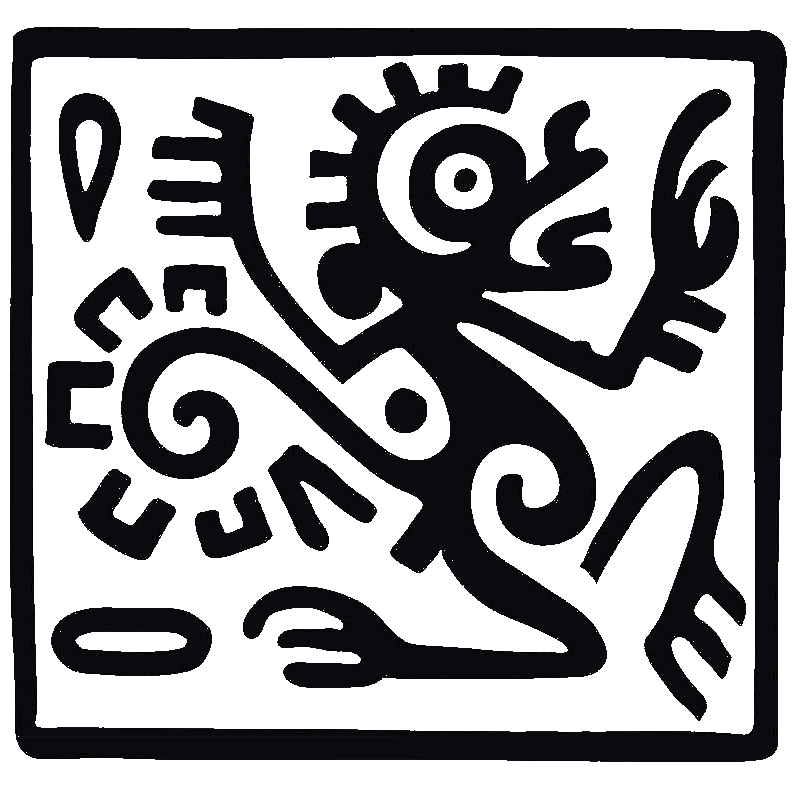
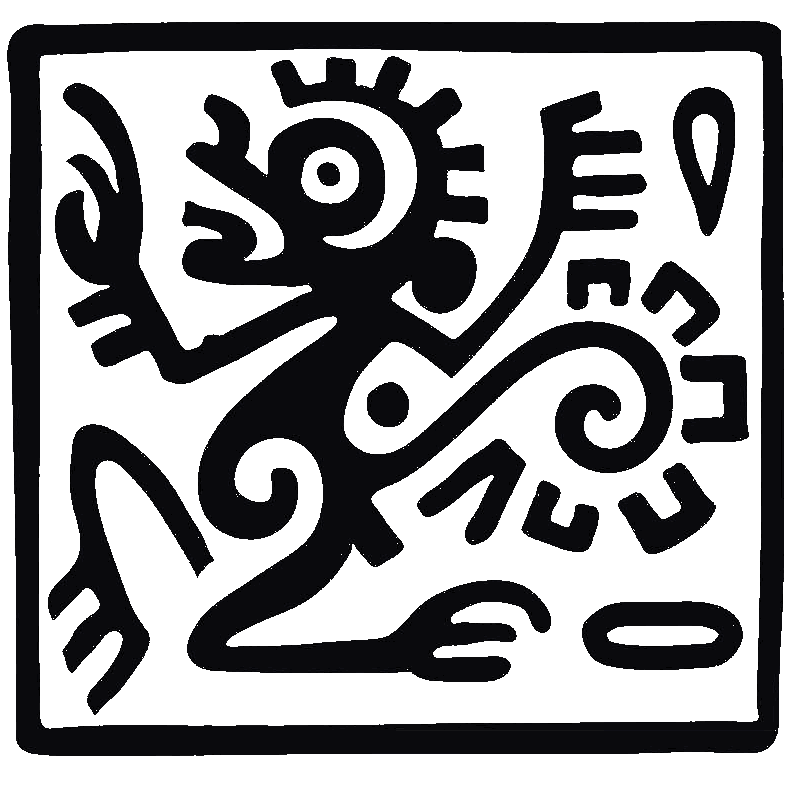
Copyleft,
CC, Mitzub'ixi Quq Chi'j, 1996-2099